Sony A3880080 GSM 850/900/1800/1900 GPRS / EDGE / UMTS FDD1&8 / HSPA mobile phone with Bluetooth, GPS/A-GPS, FM receiver User Manual 08 part 1
Sony Mobile Communications Inc GSM 850/900/1800/1900 GPRS / EDGE / UMTS FDD1&8 / HSPA mobile phone with Bluetooth, GPS/A-GPS, FM receiver 08 part 1
Sony >
Contents
- 1. 08 user manual part 1
- 2. 08 user manual parts 2 and 3
- 3. 08 user manual part1
- 4. 08 user manual parts2and3
08 user manual part 1

Hazel™
Extended User guide
Contents
Getting started..............................................................................5
Phone overview...................................................................................6
Turning on the phone..........................................................................7
Help....................................................................................................8
Charging the battery...........................................................................8
Maximising battery performance.........................................................9
Screen icons.....................................................................................10
Menu overview..................................................................................11
Navigation.........................................................................................12
Memory............................................................................................13
Phone language................................................................................14
Entering text......................................................................................14
Chinese input....................................................................................15
Calling..........................................................................................17
Making and answering calls..............................................................17
Contacts ..........................................................................................19
Speed dial.........................................................................................21
More calling features.........................................................................21
Imaging .......................................................................................25
Viewfinder and camera keys..............................................................25
Using the still camera........................................................................25
Using the video camera.....................................................................27
Working with photos.........................................................................27
Viewing and tagging photos..............................................................27
Using photos.....................................................................................28
Printing photos..................................................................................28
Using web albums............................................................................29
Accessing videos in your phone........................................................29
Music ..........................................................................................31
Stereo portable handsfree.................................................................31
Music player......................................................................................31
Playlists.............................................................................................31
SensMe™ technology.......................................................................32
Audio books......................................................................................33
Buy Now...........................................................................................33
PlayNow™ application......................................................................33
TrackID™ application .......................................................................33
Online music and video clips.............................................................34
Radio ...............................................................................................34
2
This is an Internet version of this publication. © Print only for private use.
Recording sound ..............................................................................35
Transferring and handling content...........................................36
Handling content in the phone..........................................................36
Sending content to another phone....................................................36
Using a USB cable............................................................................36
Transferring content to and from a computer....................................37
Phone name.....................................................................................38
Using Bluetooth™ wireless technology..............................................38
Backing up and restoring..................................................................39
Updating your phone.................................................................40
Updating your phone using Sony Ericsson PC Suite..........................40
Messaging...................................................................................41
Text and picture messages...............................................................41
Conversations...................................................................................42
Voice messages................................................................................42
Email.................................................................................................42
Internet .......................................................................................45
To access the web browser toolbar..................................................45
Web browser shortcuts.....................................................................45
Bookmarks.......................................................................................45
History pages....................................................................................46
More browser features......................................................................46
Internet security and certificates........................................................46
File transfers......................................................................................46
Web feeds........................................................................................47
GPS..............................................................................................49
Using GPS........................................................................................49
Tracker.............................................................................................50
Synchronising.............................................................................52
Synchronising using a computer.......................................................52
Synchronising using an Internet service.............................................52
More features.............................................................................53
Flight mode.......................................................................................53
Alarms..............................................................................................53
Calendar...........................................................................................54
Notes................................................................................................54
Tasks................................................................................................55
Profiles..............................................................................................55
Time and date...................................................................................55
Themes.............................................................................................56
Main menu layout..............................................................................56
Screen orientation.............................................................................56
3
This is an Internet version of this publication. © Print only for private use.
Ringtones..........................................................................................56
Games..............................................................................................57
Applications......................................................................................57
Antivirus............................................................................................57
PIN codes.........................................................................................58
Keypad lock......................................................................................59
IMEI number.....................................................................................59
Troubleshooting.........................................................................60
Common questions...........................................................................60
Error messages.................................................................................62
Legal information.......................................................................64
Index............................................................................................66
4
This is an Internet version of this publication. © Print only for private use.
Getting started
Important information
Please read the Important information leaflet before you use your mobile phone.
5
This is an Internet version of this publication. © Print only for private use.
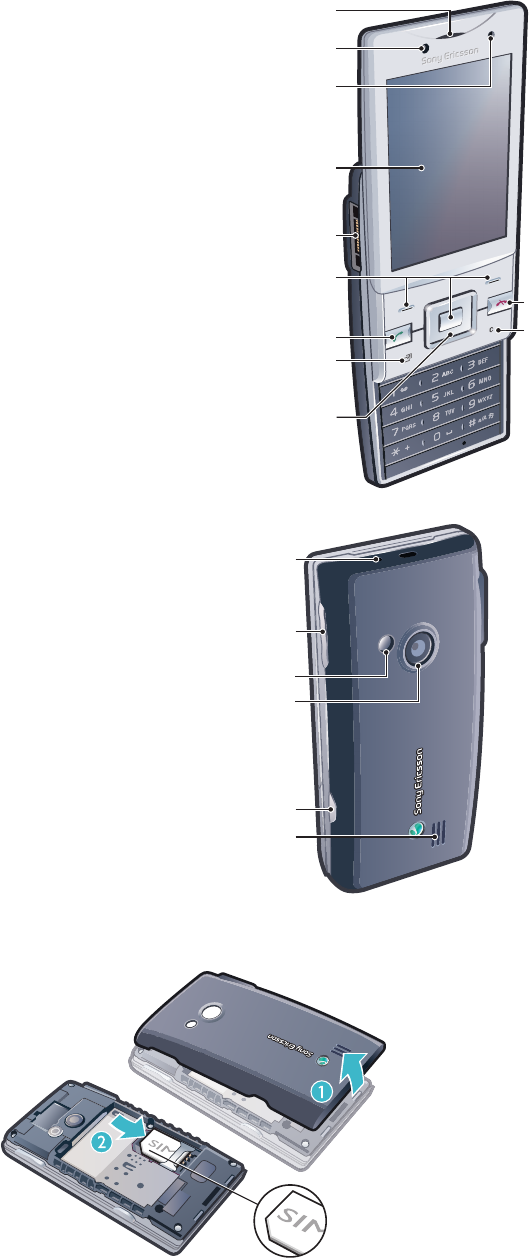
Phone overview
1 Ear speaker
1
3
6
2
4
5
7
8
9
10
11
2 Video call camera
3 Light sensor
4 Screen
5 Connector for charger, handsfree, and USB cable
6 Selection keys
7 Call key
8 Activity menu key
9 Navigation key
10 End key, On/off key
11 C key (Clear)
12 Strap hole
12
13
16
17
14
15
13 Volume, digital zoom key
14 Flash light
15 Main camera lens
16 Camera key
17 Speaker
To insert the SIM card
1Remove the battery cover.
2Slide the SIM card into its holder with the gold-coloured contacts facing down.
6
This is an Internet version of this publication. © Print only for private use.
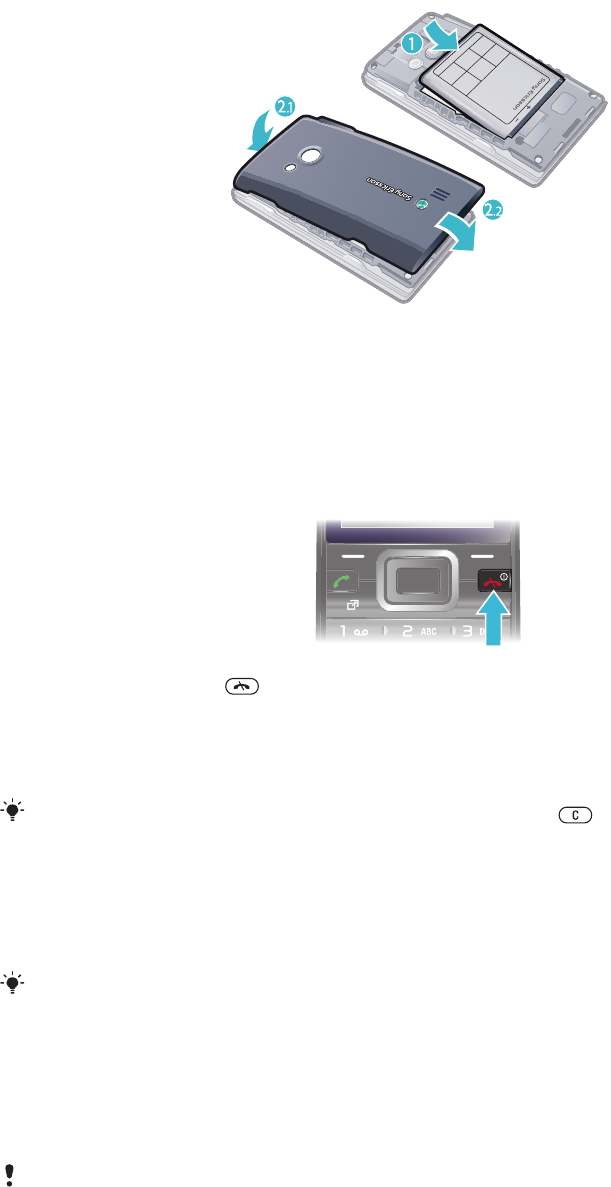
To insert the battery
1Insert the battery with the label side up and the connectors facing each other.
2Attach the battery cover.
Turning on the phone
To turn on the phone
1Press and hold down .
2Enter your SIM card PIN (Personal Identification Number), if requested, and select
OK.
3Select a language.
4Follow the instructions that appear.
If you want to correct a mistake when you enter your PIN, press .
SIM card
The SIM (Subscriber Identity Module) card, which you get from your network operator,
contains information about your subscription. Always turn off your phone and detach the
charger before you insert or remove the SIM card.
You can save contacts on the SIM card before you remove it from your phone.
PIN
You may need a PIN (Personal Identification Number) to activate the services and functions
in your phone. Your PIN is supplied by your network operator. Each PIN digit appears as
*, unless it starts with emergency number digits, for example, 112 or 911. You can see and
call an emergency number without entering a PIN.
If you enter the wrong PIN three times in a row, the SIM card is blocked. See SIM protection on
page 58.
Standby
After you have turned on your phone and entered your PIN, the name of the network
operator appears. This view is called standby. Your phone is now ready for use.
7
This is an Internet version of this publication. © Print only for private use.

Widget Manager
You can show, hide or add widgets by using Widget Manager. A widget is a live update on
a website, web page or desktop. Widgets contain personalised content or applications
selected by the user.
To manage widgets
1From standby, press the navigation key up.
2Select Manage. Widget icons appear.
3To select a widget, press the navigation key left or right.
4Select Hide to hide a widget or Show if you want the widget to appear in the standby
screen.
To start a widget
1From standby, press the navigation key up.
2To select a widget, press the navigation key left or right.
3Press Select to start the widget.
Using other networks
Making and receiving calls, using messaging and data transfer, for example, Internet-based
services, outside your home network (roaming) may incur additional costs. Contact your
operator for more information.
Help
In addition to this User guide, Feature guides and more information are available at
www.sonyericsson.com/cn.
There are also help functions and a User guide in your phone. See the following instructions
on how to access them.
To access the User guide in your phone
•Select Menu > Settings > User help > User guide.
To view tips and tricks
•Select Menu > Settings > User help > Tips and tricks.
To view information about functions
•Scroll to a function and select Info, if available. In some cases, Info appears under
Options.
To view the phone demonstration
•Select Menu > Entertainment > Demo tour.
To view the phone status
•Press the volume key. Phone, memory and battery information is shown.
Supported services and features
Some of the services and features described in this User guide are not supported by all networks
and/or service providers in all areas. Without limitation, this applies to the GSM International
Emergency Number 112. Please contact your network operator or service provider to determine
availability of any specific service or feature and whether additional access or usage fees apply.
Charging the battery
The phone battery is partly charged when you buy it.
It may take 30 minutes for the battery icon to appear on the screen.
8
This is an Internet version of this publication. © Print only for private use.
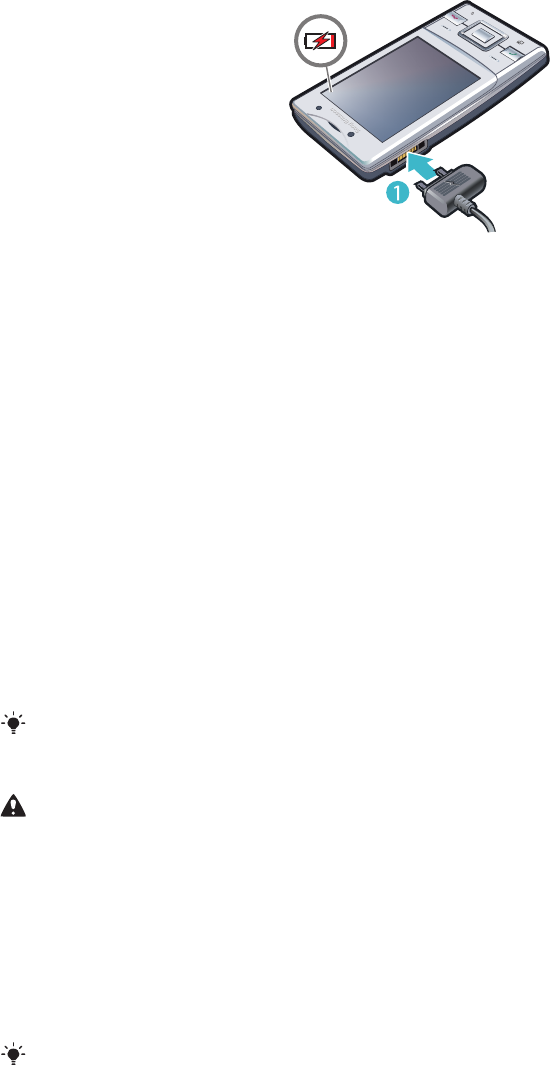
To charge the battery
1Connect the charger to the phone.
2Remove the charger by tilting the plug upwards.
Note
•If there are two USB cables in the kit (a USB cable for charging and a USB cable for data
transfer), the USB cable for charging is only intended for charging your phone. Do not
use it for transferring data. The USB cable for the USB charger is only intended for
connection to the AC adapter to charge your phone. It must not be used for connection
to a computer. It can only be used for charging your phone. Never use it for charging
accessories.
•If there is only one USB cable in the kit, it is intended for charging your phone as well as
transferring data.
•If there is only one USB cable for the USB charger in the phone kit, this USB cable is only
intended for charging your phone.
•To charge your phone, Sony Ericsson strongly recommends that you use only
Sony Ericsson branded original batteries, a power supply which is in accordance
with specification YD/T 1591-2006 (a Communications Industry standard of P. R.
China) , and the USB cable supplied with your phone. The use of third-party products
may decrease the performance of your phone and/or pose a risk to your health or safety
You can charge the battery for more or less than 3 hours. Interrupted charging does not damage
the battery. Performance depends on temperatures, signal strength, usage patterns, features
selected and voice or data transmissions. The standby time for this battery is up to 400 hours.
Use only Sony Ericsson branded original batteries intended for use with your mobile phone. If
you use other batteries you may not be able to charge your phone.
Maximising battery performance
•Charge your phone often. The battery lasts longer if you charge it frequently.
•If you are in an area with no coverage, your phone repeatedly scans for available networks.
This consumes power. If you cannot move to an area with better coverage, turn off your
phone temporarily.
•Do not cover the phone antenna when you are engaged in a call.
Go to
www.sonyericsson.com/support
to learn more about how to maximise the battery
performance.
9
This is an Internet version of this publication. © Print only for private use.
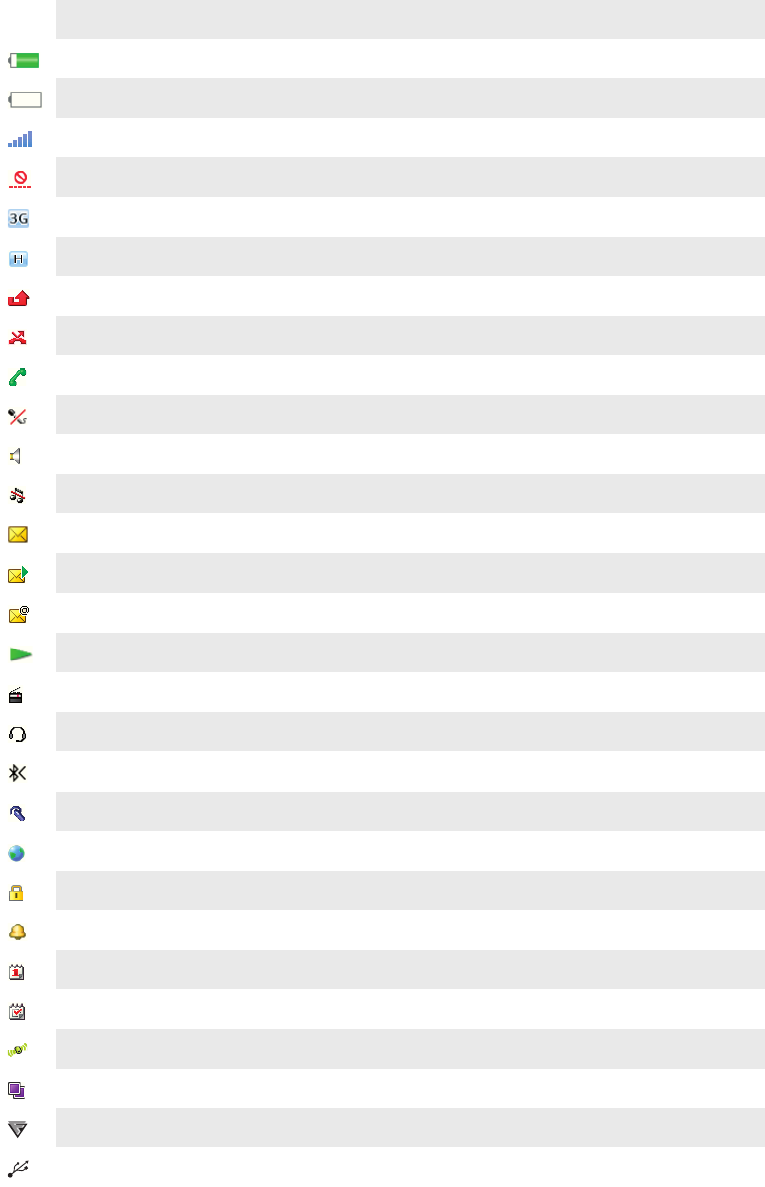
Screen icons
These icons may appear on the screen:
Icon Description
The battery is almost fully charged
The battery needs charging
The network coverage is good
No network coverage (also shown in flight mode)
A 3G network is available
A UMTS HSPA network is available
Missed calls
Calls diverted
Ongoing call
The microphone is muted
The loudspeaker is on
The phone is in silent mode
New text message
New multimedia message
New email
The music player is playing
The radio is playing
A handsfree is connected
The Bluetooth function is activated
A Bluetooth headset is connected
The phone is connected to the Internet
Secure website
An alarm is activated
Appointment reminder
Task reminder
GPS is activated
A Java™ application is activated
Activating Antivirus
USB cable is connected
10
This is an Internet version of this publication. © Print only for private use.
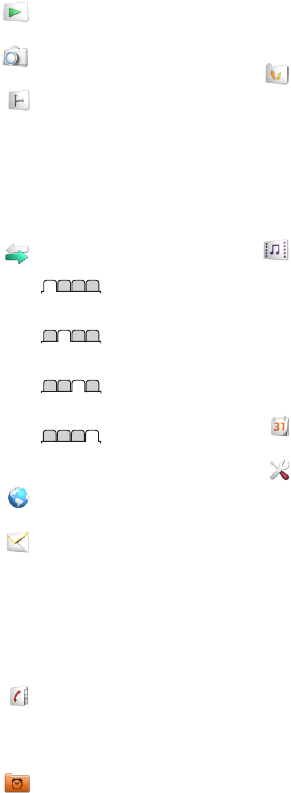
Menu overview*
PlayNow™
Camera
Location services
Google Maps
Navigation
Tracker
My favourites
Settings
Calls**
All
Answered
Dialled
Missed
Internet
Messaging
Write new
Inbox/Conversations
Messages
Email
Call voicemail
Contacts
Myself
New contact
Organiser
Alarms
Applications
File manager **
File transfer
Tasks
Notes
Media Home
Synchronisation
Timer
Stopwatch
Torch
Calculator
Entertainment
Online services
Radio
TrackID™
Games
Record sound
Demo tour
Media
Photo
Music
Video
Games
Web feeds
Settings
Calendar
Settings
General
Profiles
Time & date
Language
Update software
Voice control
Shortcuts
Flight mode
Automatic keylock
PIN codes
Security
Accessibility
Phone status
Master reset
Sounds & alerts
Ring volume
Ringtone
Silent mode
Increasing ring
Vibrating alert
Message alert
Key sound
Display
Wallpaper
Main menu layout
Theme
Startup screen
Screen saver
Clock size
Brightness
Edit line names
Calls
Speed dial
Smart search
Divert calls
Switch to line 2
Manage calls
Time
Show/hide my no.
Handsfree
Open to answer
Close to end call
Connectivity
Bluetooth
USB
Phone name
Content sharing
Synchronisation
Device management
Mobile networks
Data communication
Internet settings
Streaming settings
Message settings
SIP settings
Accessories
User help
User guide
Basic setup
Tips and tricks
* Some menus are operator-,
network- and subscription-
dependent.
** You can use the navigation
key to scroll between tabs in
submenus.
11
This is an Internet version of this publication. © Print only for private use.
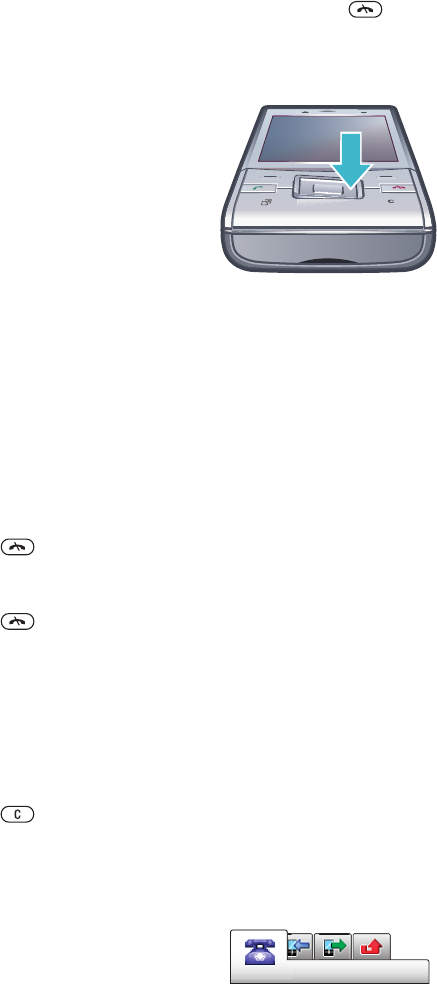
Navigation
To access the main menu
•When Menu appears on the screen, press the centre selection key to select
Menu.
•If Menu does not appear on the screen, press , and then press the centre
selection key to select Menu.
To navigate the phone menus
•Press the navigation key upwards, downwards, left or right to move through the
menus.
To select actions on the screen
•Press the left, centre or right selection key.
To view options for an item
•Select Options to, for example, edit.
To end a function
•Press .
To return to standby
•Press .
To navigate your media
1Select Menu > Media.
2Scroll to a menu item and press the navigation key right.
3To go back, press the navigation key left.
To delete items
•Press to delete items such as numbers, letters, pictures and sounds.
Tabs
Tabs may be available. For example, Calls have tabs.
To scroll between tabs
•Press the navigation key left or right.
Shortcuts
You can use the navigation key shortcuts to go directly to functions from standby.
To use navigation key shortcuts
•Press the navigation key upwards, downwards, left or right to go directly to a
function.
12
This is an Internet version of this publication. © Print only for private use.

To edit a navigation key shortcut
1Select Menu > Settings > General > Shortcuts.
2Scroll to an option and select Edit.
3Scroll to a menu option and select Shortc..
Main menu shortcuts
Menu numbering starts from the top left icon and moves across and then down row by
row.
To go directly to a main menu item
•Select Menu and press – , , or .
The Main menu layout must be set to Grid. See To change the main menu layout on page 56.
Activity menu
The activity menu gives you quick access to:
•New events – missed calls and new messages.
•Running apps – applications that are running in the background.
•My shortcuts – add your favourite functions to access them quickly.
•Internet – connect conveniently to the Internet.
To open the activity menu
•Press .
Memory
You can save content on a memory card, in the phone memory and on the SIM card. Photos
and music are saved on the memory card, if a memory card is inserted. If not, or if the
memory card is full, photos and music are saved in the phone memory. Messages and
contacts are saved in the phone memory, but you can choose to save them on the SIM
card.
Memory card
You may have to purchase a memory card separately.
Your phone supports a microSD™ memory card, adding more storage space to your
phone. This type of card can also be used as a portable memory card with other compatible
devices.
You can move content between a memory card and the phone memory.
To insert a memory card
•Remove the battery cover and insert the memory card with the gold-coloured
contacts facing down.
13
This is an Internet version of this publication. © Print only for private use.
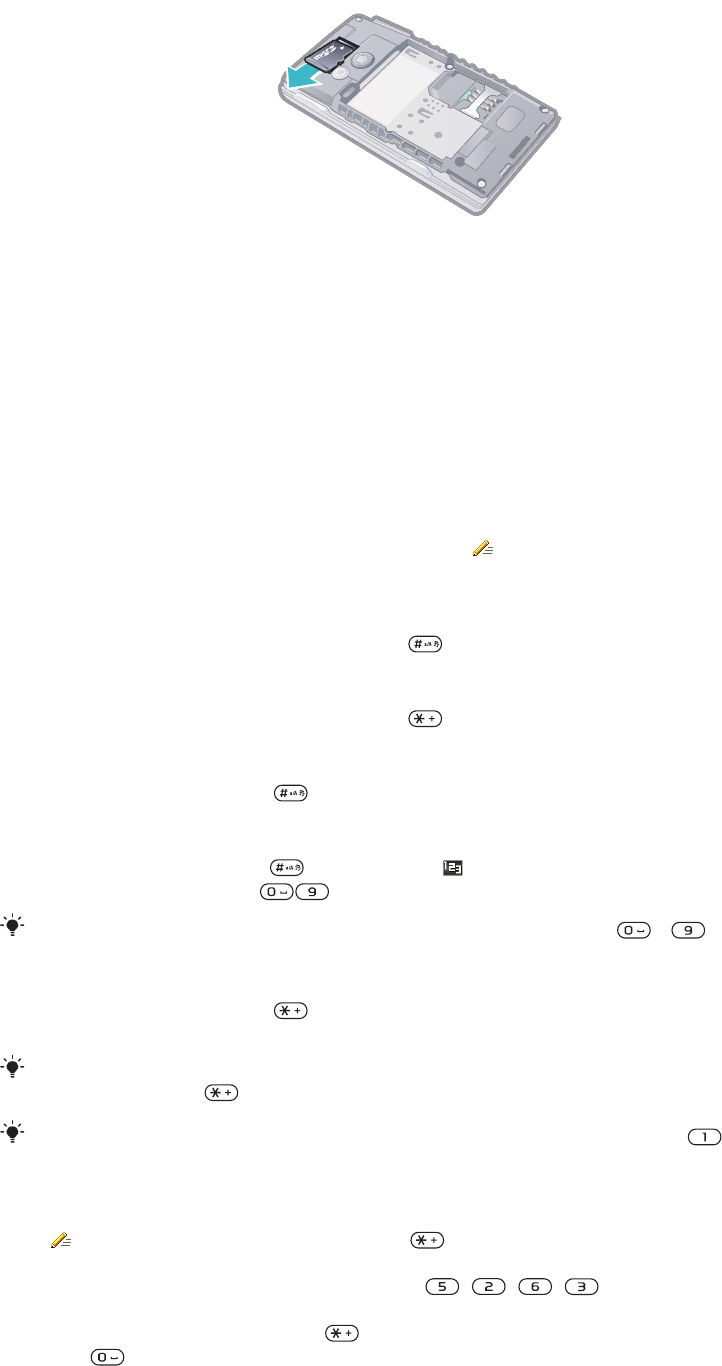
To remove a memory card
•Remove the battery cover and slide the memory card to remove it.
Phone language
You can select a language to use in your phone.
To change the phone language
1Select Menu > Settings > General > Language > Phone language.
2Select an option.
Entering text
You can use multitap text input or Quick text input to enter text. The Quick text input
method uses a dictionary application in your phone.
To change the writing language
•When you enter text, press and hold down .
To change the text input method
•When you enter text, press and hold down .
To shift between upper- and lower-case letters or numbers
•When you enter text, press .
To enter numbers
1When you enter text, press repeatedly until appears at the top of the screen.
2To enter a number, press .
To enter a number from text input mode, you can press and hold down – .
To enter punctuation marks and symbols
1When you enter text, press briefly.
2Scroll to a symbol and select Insert.
When you enter Chinese, you can insert full-size symbols such as
。
or
《
. To open the full-size
symbol table, press and select Full.
To select from the most commonly used punctuation marks, you can also press .
To enter text using Quick text input
1Select, for example, Menu > Messaging > Write new > Message.
2If is not displayed, press and hold down to change to Quick text input.
3Press each key only once, even if the letter you want is not the first letter on the key.
For example, to write the word “Jane”, press , , , . Write the whole
word before looking at the suggestions.
4To view word suggestions, press or press the navigation key downwards.
5Press to accept a suggestion and add a space.
14
This is an Internet version of this publication. © Print only for private use.

To enter text using the multitap method
1Select, for example, Menu > Messaging > Write new > Message.
2If is displayed, press and hold down to change to multitap text input.
3Press – repeatedly until the desired letter appears.
4Press to add a space.
Multitap input only applies when Latin characters are selected as input language.
To add words to the phone dictionary
1When you enter text using Quick text input, select Options > Spell word.
2Write the word using multitap input and select Save.
Chinese input
This mobile phone has different input methods for entering Chinese characters:
•Stroke input
•Pinyin input
You can use these methods, for example, to enter Chinese names and Chinese short
messages.
General instructions
Your phone has a function to speed up the entry of Chinese characters. Whenever you
enter a stroke or a Pinyin letter, a candidate row of the most frequently used characters
containing that stroke or relating to that letter appears at the bottom of the screen. Pressing
to present another candidate row. Continue pressing until the character you want is
displayed. Alternatively, you can enter the next stroke or Pinyin letter, and a new set of
characters will immediately be displayed in the candidate row. To go back to the previous
row, press . To select a character in the candidate row, press the navigation key or press
and hold the key corresponding to the number above the character you want to enter.
Stroke input
A Chinese character is built up of strokes which are grouped into five stroke categories.
Each category is represented on the keypad by one of the keys - . The Wild Card
key , is used when you are not sure of which stroke to use.
Components
Using components is a fast method for entering complex characters. After entering the first
two strokes of the desired character, the component and character candidates that started
with that stroke are displayed in the candidate row.
The smaller candidates surrounded by dotted frames are components, and the bigger candidates
without dotted frames are characters.
For example, to enter “ 信息”
1Enter “ ”, “ ” and “ ”.
2Move the cursor to “信”, press the centre selection key.
3Move the cursor to “息”, press the centre selection key again to select “ 息”.
Example of using the wild card key
The wild card key , is used to supplement unclear strokes in entering characters. If you
want to enter “互”, but you only know that “ 一” is the first and the last stroke of the character
and that the total number of strokes is four, enter , , , . The character is
displayed in the candidate row.
15
This is an Internet version of this publication. © Print only for private use.

Pinyin input
Press the keys containing the required Pinyin letters, and the phone will make various
proposals on the screen, according to the pronunciation rules of Mandarin.
On the keypad, the letter ü is replaced by v.
For example, to enter “ 信息”
1Press , , .
2When “xin” is highlighted, press or and select “ 信”, then press the centre
selection key. (If you want to enter any of the other suggested Pinyin combinations,
scroll up or down to the desired combination, then press the centre selection key.)
3Press the centre selection key again to select “ 息”, when “ 息” is highlighted.
Fuzzy Pinyin
In Fuzzy Pinyin, some spelling differences are ignored. For example, c and ch, z and zh,
n and ng. This is helpful when you are uncertain about the exact spelling of a character.
For example, you can enter
信
with either spelling xin or xing.
To turn on Fuzzy Pinyin
1When you enter text using Pinyin input, select Options > Writing settings > Fuzzy
Pinyin.
2Select On.
16
This is an Internet version of this publication. © Print only for private use.

Calling
You need to turn on your phone and be within range of a network.
Making and answering calls
To end a call
•Press .
To re-dial a number
•When Retry? appears, select Yes.
Do not hold your phone to your ear when waiting for the call to connect. When the call connects,
your phone gives a loud signal.
To answer a call
•Press .
To reject a call
•Press .
To change the ear speaker volume during a call
•Press the volume keys up or down.
To mute the microphone during a call
1Press and hold down . appears.
2Press and hold down again to resume.
To turn on the loudspeaker during a call
•Select Spkr on. appears.
Do not hold the phone to your ear when using the loudspeaker. This could damage your hearing.
To view missed calls from standby
• appears. Press to open the call list.
Background music
You can add background music to an ongoing call. When activated, background music
can be heard by all participants. When the microphone is muted, the background music
continues to play.
To start playing background music during a call
•During the call, select Music.
See To play music on page 31.
To stop playing background music during a call
•Press the centre selection key.
To change the background music volume during a call
•Press the volume key up or down.
Only the music volume can be changed when the music is playing.
Call sound quality
The Noise shield filters out sound around you that can make it difficult for the other party
to hear your voice, while the Clear Voice function helps you hear better in a crowded
environment. You can enable or disable these functions during a call.
17
This is an Internet version of this publication. © Print only for private use.

To turn off the Noise shield
•During a call, select Options > Noise shield off. The status icon on the screen
changes to .
To turn on Clear Voice
•During a call, select Options > Clear Voice on.
Video call
During a video call, the person you are talking to can see you on their screen.
Before making video calls
3G (UMTS) service is available when or appears. To make a video call, both parties
on the call must have a 3G (UMTS) phone subscription that supports 3G (UMTS) service
and 3G (UMTS) coverage.
To make a video call
1Enter a phone number (with international country code and area code, if applicable).
2Select Options > Make video call.
To use the zoom with an outgoing video call
•Press the navigation key upwards or downwards.
To share photos and videos during a video call
1During a video call, press the navigation key left to switch to the video share mode
tab.
2Scroll to a video clip or photo and select Share.
To view video call options
•During the call, select Options.
Emergency calls
Your phone supports international emergency numbers, for example, 112 or 911. You can
normally use these numbers to make emergency calls in any country, with or without the
SIM card inserted, if you are within range of a network.
In some countries, other emergency numbers may also be promoted. Your network operator may
therefore have saved additional local emergency numbers on the SIM card.
To make an emergency call
•Enter 112 (the international emergency number) and press .
To view your local emergency numbers
1Select Menu > Contacts.
2Scroll to New contact and select Options > Special numbers > Emergency
numbers.
Call list
You can view information about answered , dialled and missed or rejected calls.
To call a number from the call list
1Press and scroll to a tab.
2Scroll to a name or a number and press .
18
This is an Internet version of this publication. © Print only for private use.

Contacts
You can save names, phone numbers and personal information in Contacts. Information
can be saved in the phone memory or on the SIM card.
You can synchronise your contacts using the Sony Ericsson PC Suite. Add the area code when
you save fixed line numbers in your phone.
Default contacts
You can choose which contact information is shown by default. If Phone contacts is
selected as the default, only contact information saved to the phone memory is listed in
Contacts. If you select SIM contacts as the default, only names and numbers saved on
the SIM card are shown in Contacts.
To select default contacts
1Select Menu > Contacts.
2Scroll to New contact and select Options > Advanced > Default contacts.
3Select an option.
Phone contacts
Phone contacts can contain names, phone numbers and personal information. They are
saved in the phone memory.
To add a phone contact
1Select Menu > Contacts.
2Scroll to New contact and select Add.
3Enter the name and select OK.
4Scroll to New number: and select Add.
5Enter the number and select OK.
6Select a number option.
7Scroll between the tabs and add information to the fields.
8Select Save.
Calling contacts
To call a contact written in Chinese characters
1Select Menu > Contacts. Enter the entire multi-letter name, pure initial or mixed
initial Pinyin of Chinese contacts you want to call.
2When the contact is highlighted, press navigation key left or right to select a number.
Press the Call key.
To call a contact written in Latin letters
1Select Menu > Contacts. Scroll to, or enter the first letters or all letters of the contact
you want to call (a maximum of 10 letters).
2When the contact is highlighted, press the navigation key left or right to select a
number. Press the Call key.
The phone supports a mixed search of Chinese and English contacts. When a contact is written
in Latin characters, the entered letter can reach the Latin contact you want to call. When a contact
is written in Chinese characters, the entered letter can reach the Pinyin of the Chinese contact
you want to call.
To go directly to the contacts list
•Press and hold down – .
To make a call using Smart search
1Press – to enter a sequence of (at least two) digits. All entries that match
the sequence of digits, or corresponding letters, are shown in a list.
2Scroll to a contact or a phone number and press .
19
This is an Internet version of this publication. © Print only for private use.

To turn on or off Smart search
1Select Menu > Settings > Calls > Smart search.
2Select an option.
Editing contacts
To add information to a phone contact
1Select Menu > Contacts.
2Scroll to a contact and select Options > Edit contact.
3Scroll between the tabs and select Add or Edit.
4Select an option and an item to add or edit.
5Select Save.
If your subscription supports Calling Line Identification (CLI) services, you can assign personal
ringtones and pictures to contacts.
To copy names and numbers to phone contacts
1Select Menu > Contacts.
2Scroll to New contact and select Options > Advanced > Copy from SIM.
3Select an option.
To copy names and numbers to the SIM card
1Select Menu > Contacts.
2Scroll to New contact and select Options > Advanced > Copy to SIM.
3Select an option.
When you copy all contacts from your phone to the SIM card, all existing SIM card information
is replaced.
To automatically save names and phone numbers on the SIM card
1Select Menu > Contacts.
2Scroll to New contact and select Options > Advanced > Auto save on SIM.
3Select an option.
To save contacts on a memory card
1Select Menu > Contacts.
2Scroll to New contact and select Options > Advanced > Back up to m. card.
SIM contacts
SIM contacts can contain names and numbers only. They are saved on the SIM card.
To add a SIM contact
1Select Menu > Contacts.
2Scroll to New contact and select Add.
3Enter the name and select OK.
4Enter the number and select OK.
5Select a number option and add more information, if available.
6Select Save.
Deleting contacts
To delete all contacts
1Select Menu > Contacts.
2Scroll to New contact and select Options > Advanced > Delete all contacts.
3Select an option.
Contact memory status
The number of contacts you can save in your phone or on the SIM card depends on
available memory.
20
This is an Internet version of this publication. © Print only for private use.

To view contact memory status
1Select Menu > Contacts.
2Scroll to New contact and select Options > Advanced > Memory status.
Myself
You can enter information about yourself and, for example, send your business card.
To enter information in Myself
1Select Menu > Contacts.
2Scroll to Myself and select Open.
3Scroll to an option and edit the information.
4Select Save.
To add your own business card
1Select Menu > Contacts.
2Scroll to Myself and select Open.
3Scroll to My contact info and select Add > Create new.
4Scroll between the tabs and add information to the fields.
5Enter the information and select Save.
Groups
You can create a group of phone numbers and email addresses from Phone contacts to
send messages to. You can also use groups (with phone numbers) when you create
accepted callers lists.
To create a group of numbers and email addresses
1Select Menu > Contacts.
2Scroll to New contact and select Options > Groups.
3Scroll to New group and select Add.
4Enter a name for the group and select Continue.
5Scroll to New and select Add.
6For each contact phone number or email address you want to mark, scroll to it and
select Mark.
7Select Continue > Done.
Speed dial
Speed dialling lets you select nine contacts that you can dial quickly from standby. The
contacts can be saved in positions 1-9.
To assign speed dial numbers to contacts
1Select Menu > Contacts.
2Scroll to New contact and select Options > Speed dial.
3Scroll to a position number and select Add.
4Select a contact.
To speed dial
•Enter the position number and press .
More calling features
Voicemail
If your subscription includes an answering service, callers can leave a voicemail message
when you cannot answer a call.
21
This is an Internet version of this publication. © Print only for private use.

To enter your voicemail number
1Select Menu > Messaging > Messages > Settings > the Message settings tab
> Voicemail number.
2Enter the number and select OK.
To call your voicemail service
•Press and hold down .
Voice control
By creating voice commands you can:
•Voice dial – call someone by saying their name
•Answer and reject calls when you use a handsfree
To record a voice command using voice dialling
1Select Menu > Settings > General > Voice control > Voice dialling > Activate.
2Select Yes > New voice command and select a contact. If the contact has more
than one number, select the number to add the voice command to.
3Follow the instructions that appear. Wait for the tone and say the command to
record. Record a voice command such as “John mobile”. The voice command is
played back to you.
4If the recording sounds OK, select Yes. If not, select No and repeat steps 3 and 4.
Voice commands are saved in the phone memory only. They cannot be used in another phone.
To voice dial a contact
1Press and hold down a volume key.
2Wait for the tone and say a recorded voice command, for example “John mobile.”
The phone plays the command back to you and connects the call.
To activate voice answering and record voice answer commands
1Select Menu > Settings > General > Voice control > Voice answer > Activate.
2Follow the instructions that appear and select Continue. Wait for the tone and say
“Answer”, or say any other word.
3Select Yes to accept or No to make a new recording.
4Wait for the tone and say “Busy”, or say any other word.
5Select Yes to accept or No to make a new recording.
6Follow the instructions that appear and select Continue.
7Select the environments in which you want to activate voice answering.
To answer a call using voice commands
•Say “Answer.”
To re-record a voice command
1Select Menu > Settings > General > Voice control > Voice dialling > Edit
names.
2Scroll to a command and select Options > Replace voice.
3Wait for the tone and say the command.
Diverting calls
You can divert calls, for example, to an answering service.
When Restrict calls is used, some divert call options are not available.
To divert calls
1Select Menu > Settings > Calls > Divert calls.
2Select a call type and a divert option.
3Select Activate. appears.
4Enter the number to divert calls to and select OK.
22
This is an Internet version of this publication. © Print only for private use.

Call waiting
You will hear a beep if you receive a second call while call waiting is active.
To activate call waiting
•Select Menu > Settings > Calls > Manage calls > Call waiting > Activate.
More than one call
You can handle more than one call at a time. For example, you can put an ongoing call on
hold while you make or answer a second call. You can also switch between the two calls.
You cannot answer a third call without ending one of the first two calls.
To switch between two calls
•During the call, press .
To join two calls
•During the call, select Options > Join calls.
To end an ongoing call and return to the call on hold
•First press and then .
To make a second call
1During the call, press . This puts the ongoing call on hold.
2Select Options > Add call.
3Enter the number to call and press .
To answer a second call
•During the call, press . This puts the ongoing call on hold.
To reject a second call
•During the call, press and continue with the ongoing call.
To end an ongoing call and answer a second call
•During the call, select Replace active call.
Conference calls
With a conference call, you can have a joint conversation with up to five people.
To add a new participant
1During the call, press . This puts the joined calls on hold.
2Select Options > Add call.
3Enter the number to call and press .
4Select Options > Join calls to add the new participant.
5Repeat this task to add more participants.
To release a participant
1Select Options > Release party.
2Select the participant to release.
To have a private conversation
1During the call, select Options > Talk to and select the participant to talk to.
2To resume the conference call, select Options > Join calls.
My numbers
You can view, add and edit your own phone numbers.
23
This is an Internet version of this publication. © Print only for private use.

To check your phone numbers
1Select Menu > Contacts.
2Scroll to New contact and select Options > Special numbers > My numbers.
3Select an option.
Accept calls
You can choose to receive calls from certain phone numbers only.
To add numbers to the accepted callers list
1Select Menu > Settings > Calls > Manage calls > Accept calls > Only from list.
2Scroll to New and select Add.
3Select a contact or Groups.
To accept all calls
•Select Menu > Settings > Calls > Manage calls > Accept calls > All callers.
Restricted dialling
You can restrict outgoing and incoming calls. A password from your service provider is
required.
If you divert incoming calls, you cannot use some restrict calls options.
To restrict calls
1Select Menu > Settings > Calls > Manage calls > Restrict calls.
2Select an option.
3Select Activate.
4Enter your password and select OK.
Call time and cost
During a call, the phone shows how long you have been talking. You can also check on
the duration of your last call, your outgoing calls and the total time of all your calls.
To check the call time
•Select Menu > Settings > Calls > Time > Call timers.
Showing or hiding your phone number
You can decide to show or hide the number displayed on the call recipient's phone when
you make a call.
To hide your phone number
1Select Menu > Settings > Calls > Show/hide my no..
2Select Hide number.
24
This is an Internet version of this publication. © Print only for private use.
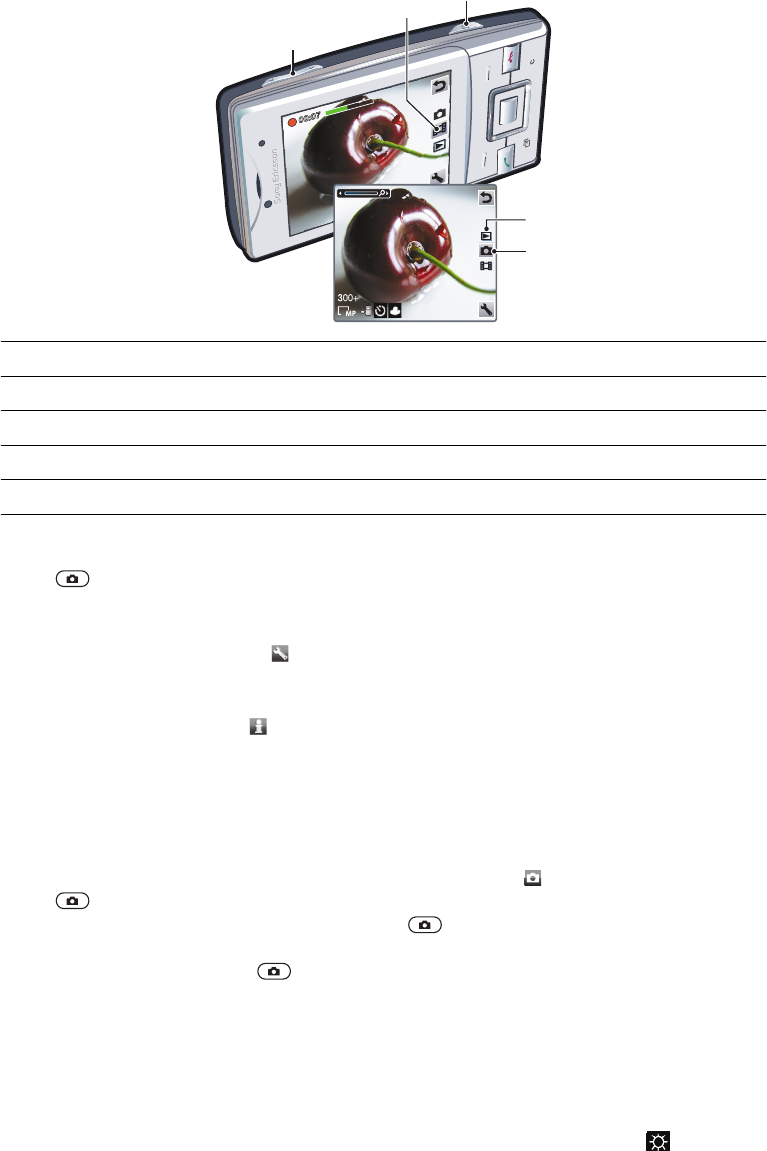
Imaging
You can take photos and record videos to view, save or send. You can find saved photos
and videos in Media and in File manager.
Viewfinder and camera keys
1
2
3
4
5
1 Zoom in or out
2 Indicates photo mode
3 View photos and video clips
4 Indicates video mode
5 Activate the camera/Take photos/Record video clips
To activate the camera
•Press .
To change settings
•Activate the camera and select .
To view information about settings
•Scroll to a setting and select .
Using the still camera
To take a photo
1Activate the camera and press the navigation key to scroll to .
2Press halfway down to use auto focus.
3When the dot and focus frame are green, press fully down to take a photo. The
photo is automatically saved.
4To take another photo, press to return to the viewfinder.
To use zoom
•Press the volume key.
To adjust brightness
•Press the navigation key left to decrease the brightness. Press the navigation key
right to increase the brightness. The level of brightness appears beside the .
25
This is an Internet version of this publication. © Print only for private use.

Face detection
You can use face detection to bring an off-centre face into focus. The camera automatically
detects up to three faces, indicated by white frames. A green frame shows which face has
been selected for focus. Focus is set to the face closest to the camera.
To set face detection
•Select > Focus > Face detection.
Smile detection
Smile detection allows you to capture the smiles of family and friends. The camera detects
up to three faces and selects one face for smile detection and auto focus. A yellow frame
shows which face is selected. When the selected face smiles, the camera automatically
takes a photo.
To set Smile detection
1Select > Shoot mode > Smile detection.
2When appears, the camera is in Smile detection mode.
To use Smile detection
1With Smile detection set, point the camera at your subject.
2The camera automatically takes the photo when the subject smiles.
Scenes
You can use Scenes to quickly set up the camera for common situations using pre-
programmed scenes. The camera has determined a number of settings for you to fit the
selected scene, ensuring the best possible photo.
To use Scenes
1Activate the camera and press the navigation key to scroll to .
2Select > Scenes.
3Select a scene.
4Select to return to the viewfinder.
5Take a photo.
Photo fix
You can use Photo fix to improve photos. In a one-click operation, brightness, light and
contrast are adjusted to give you the best possible photo. The improvements are saved as
a copy of the photo. The original photo is not affected.
To improve a photo with Photo fix
1Activate the camera and press the navigation key to scroll to .
2Make sure Review is set to On. Select > Settings and scroll to Review > On.
Select to return to the viewfinder.
3Take a photo.
4When you review the photo, select Options > Photo fix.
5Review the improvement and select Save to save.
6If you do not want to save the improvement, select Back.
Tips on using the camera
Rule of thirds
Don’t place your subject in the middle of the frame. By placing it a third of the way in, you
achieve a better result.
Hold it steady
Avoid blurry photos by holding the camera steady. Try to steady your hand by leaning it
against a solid object. You can also use the self-timer to make sure that the phone is steady
when the photo is taken.
26
This is an Internet version of this publication. © Print only for private use.

Get closer
By getting as close as possible to your subject, you can avoid relying on the zoom. Try to
fill the viewfinder with your subject.
Stay within the flash range
Photos taken beyond the maximum flash range will be too dark. The maximum flash range
is about four steps from the subject.
Consider variety
Think about different angles, and move towards the object. Take some vertical photos. Try
different positions.
Use a plain background
A plain background helps highlight your subject.
Keep your lens clean
Mobile phones are used in all kinds of weather and places, and carried in pockets and bags.
This results in the camera lens becoming dirty and covered with fingerprints. Use a soft
cloth to clean the lens.
Using the video camera
To record a video
1Activate the camera and press the navigation key to scroll to .
2Press fully down to start recording.
3To stop recording, press fully down. The video is saved automatically.
4To return to the viewfinder and to record another video, press .
Working with photos
You can view, enhance and organise photos and videos on your computer by installing the
Adobe™ Photoshop™ Album Starter Edition application. It is available for download at
www.sonyericsson.com/support.
Use theMedia Go™ application to transfer content to and from your phone.
Viewing and tagging photos
To view photos
1Activate the camera and press the navigation key to scroll to .
2Scroll through the photos.
To view videos
1Activate the camera and press the navigation key to scroll to .
2Scroll to a video and press the centre selection key. Videos are indicated by in
the upper left corner.
To view photos in a slide show
1Select Menu > Media > Photo > Camera album.
2Select a month.
3Scroll to a photo and select View.
4Select Options > Slide show.
5Select a mood.
27
This is an Internet version of this publication. © Print only for private use.

Viewing photos on a map
When you take a photo, you can attach your geographical position to it. This is called geo
tagging. Geo-tagged photos are tagged with in Media. If you cannot view photos on a
map, see I cannot use Internet-based services on page 60.
Information acquired by cell-id is approximate. Sony Ericsson takes no responsibility for the
accuracy of such location data.
To view photos on a map
•Select Menu > Media > Photo > Geotags.
Photo tags
You can organise your photos using photo tags. You can create new tags, assign one or
several tags to a photo, or remove a tag from a photo. Photos with the same tag are saved
together under Photo tags. For example, you can add the tag ’Vacation’ to all your vacation
photos and view them all in Photo tags under the tag ’Vacation’.
To create a new photo tag
1Select Menu > Media > Photo > Camera album.
2Select a month.
3Scroll to a photo and select View.
4Press the navigation key downwards and select Options > New tag.
To tag photos
1Select Menu > Media > Photo > Camera album.
2Select a month.
3Scroll to a photo and select View.
4Press the navigation key downwards and scroll to a tag.
5Select Options > Tag this photo.
6For each photo you want to tag, scroll to the photo and select Options > Tag this
photo.
To delete a tag from a photo
1When viewing a photo, press the navigation key downwards
2Scroll to a tag and select Options > Undo tag.
Using photos
You can add a photo to a contact, use the photo during phone startup, as a wallpaper in
standby, or as a screen saver.
To use photos
1Select Menu > Media > Photo > Camera album.
2Select a month.
3Scroll to a photo and select View.
4Select Options > Use as.
5Select an option.
Printing photos
You can print photos using a USB cable connected to a PictBridge™ compatible printer.
You can also print using a Bluetooth compatible printer that supports the Object Push Profile.
28
This is an Internet version of this publication. © Print only for private use.

To print photos using a USB cable
1Select Menu > Media > Photo > Camera album.
2Select a month.
3Select Options > Mark > Mark several or Mark all.
4Select Options > Print and follow the instructions.
5Connect the USB cable to the phone.
6Connect the USB cable to the printer.
7Wait for feedback in the phone.
8Set printer settings if required and select Print.
Disconnect and re-connect the USB cable if there is a printer error.
Using web albums
If your subscription supports this service, you can send photos or videos to a web album.
If you cannot send content to a web album, see I cannot use Internet-based services on
page 60.
Web services may require a separate license agreement between you and the service provider.
Additional regulations and charges may apply. Contact your service provider for more
information.
To send photos saved in your phone to a web album
1Select Menu > Media > Photo > Camera album.
2Select a month and year.
3Scroll to the photo and select Options > Send > To web albums.
4Select a web album service. If requested, enter your login information.
5Select an album, or add a new album.
6Enter text and select Send.
To send videos saved in your phone to a web album
1Select Menu > Media > Video > Videos.
2Scroll to a video and select Options > Send > To web albums.
3Select a web album service. If requested, enter your login information.
4Select a web album, or add a new web album.
5Enter some text and select Send.
To send photos or videos you have just taken to a web album
1When you have taken a photo or recorded a video, select Send > To web
albums.
2Select a web album service. If requested, enter your login information.
3Select an album, or add a new album.
4Enter some text and select Send.
To view web albums
1Select Menu > Media > Photo > Web albums.
2Select a web album.
To go to a web address from contacts
1Select Menu > Contacts.
2Scroll to a contact and select Open.
3Scroll to a web address and select Go to.
Accessing videos in your phone
You can browse and play videos using the video player from Media and File manager.
You can find videos you recorded using the camera under Camera album. You can access
other videos from Videos.
29
This is an Internet version of this publication. © Print only for private use.
To play videos
1Select Menu > Media > Video > Videos or Camera album.
2Scroll to a title and select Play.
To stop playing a video
•Press the centre selection key.
To fast forward and rewind
•Press and hold down the navigation key right or left.
To move between videos
•Press the navigation key right or left.
To change the volume
•Press the volume keys up or down.
To change the video screen size
•Press the navigation key downwards.
30
This is an Internet version of this publication. © Print only for private use.
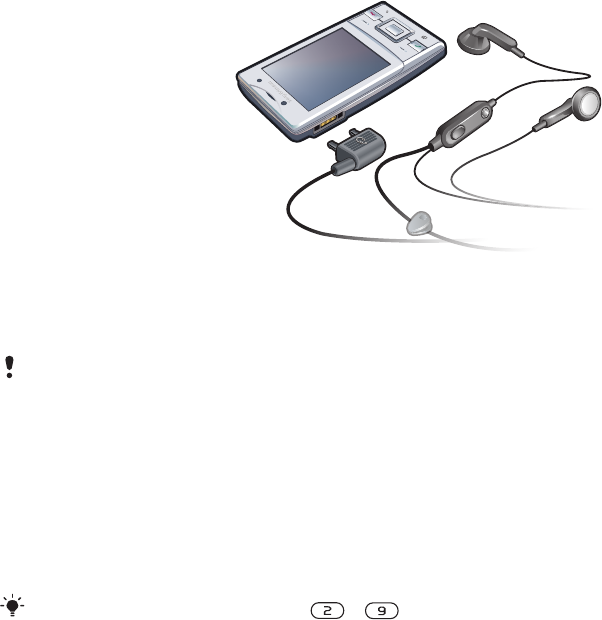
Music
You can listen to music, audio books and podcasts. Use the Media Go™ application to
transfer content to and from your phone. For more information, see Transferring content
to and from a computer on page 37.
Stereo portable handsfree
To use a handsfree
•Connect a portable handsfree. Music stops when you receive a call and resumes
when the call has ended.
If headphones are not included with the phone, you may purchase them separately.
Music player
To play music
1Select Menu > Media > Music.
2Browse by category using the navigation key.
3Scroll to a title and select Play.
Within a category, you can press – to go to entries beginning with a specific letter.
To stop playing music
•Press the centre selection key.
To fast forward and rewind
•Press and hold down the navigation key right or left.
To move between tracks
•Press the navigation key right or left.
To change the volume
•Press the volume keys up or down.
To minimise the music player
•Select Options > Minimise.
To return to the player
•Select Menu > Media.
Playlists
You can create playlists to organise your music. You can add tracks and folders to a playlist.
It may take a few minutes for the phone to create a playlist.
31
This is an Internet version of this publication. © Print only for private use.
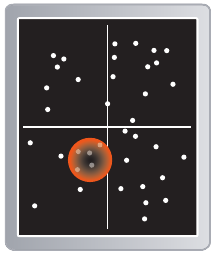
To create a playlist
1Select Menu > Media > Music > Playlists.
2Scroll to New playlist and select Add.
3Enter a name and select OK.
4For each track you want to add, scroll to the track and select Mark.
5Select Add to add the marked tracks to the playlist.
To add tracks to a playlist
1Select Menu > Media > Music > Playlists.
2Select a playlist.
3Scroll to Add music and select Add.
4For each track you want to add, scroll to the track and select Mark.
5Select Add to add the marked tracks to the playlist.
SensMe™ technology
With SensMe™ technology you can create playlists in two ways: by mood or from all the
tracks in your phone. To create playlists by mood, you first need to use the Media Go™
application to transfer tracks to your phone. Information such as mood, tempo and chords
is then added. The tracks are displayed as dots on a map with two axes. In the All view,
all the tracks in your phone are placed randomly on the map.
To create a playlist by mood
1Select Menu > Media > Music.
2Scroll to SensMe™ and select Open.
3Press the navigation key upwards, downwards, right or left.
4Make sure you are in Mood view. If you are not, select Mood.
5To preview different tracks, press the navigation key upwards, downwards, right or
left.
6To choose an area of tracks, select Add and press the navigation key upwards or
downwards.
7To create the playlist and play it in the music player, select Create.
8Select Options > Save playlist.
9Enter a name and select OK.
To create a playlist from the All view
1Select Menu > Media > Music.
2Scroll to SensMe™ and select Open.
3Press the navigation key upwards, downwards, right or left.
4Make sure you are in All view. If you are not, select All.
5To preview different tracks, press the navigation key upwards, downwards, right or
left.
6To choose an area of tracks, select Add and press the navigation key upwards or
downwards.
7To create the playlist for playing in the music player, select Create.
8Select Options > Save playlist.
9Enter a name and select OK.
32
This is an Internet version of this publication. © Print only for private use.

Audio books
If you use the Media Go™ application to transfer audio books to your phone from a
computer, you can listen to the audio books in your phone. It may take a few minutes before
a transferred audio book appears in the list of available audio books.
To access audio books
•Select Menu > Media > Music > Audio books.
You can find audio books in formats other than M4B and those that do not have ID3v2 chapter
tags in the Tracks folder.
Buy Now
If you subscribe to a music service allowing limited, non-permanent use with your phone,
you can mark a track you are interested in buying later. The next time you synchronise your
music with the Microsoft® Windows Media® Player application on a computer with enabled
Internet access, you should be asked if you want to buy the track you marked earlier. If you
accept, the track is downloaded to your computer and your selected music service account
is charged. This service requires a subscription and account with a downloadable music
service, a computer with the Microsoft® Windows Media® Player 11 application or
subsequent compatible version of the Microsoft® Windows Media® Player application, and
a USB computer connection.
You cannot see that a track is marked. You cannot unmark tracks you have already marked.
To mark a track
•When the track you want to mark is playing, press and hold down .
PlayNow™ application
When you open the PlayNow™ application, you enter PlayNow™, where you can
download music, games, ringtones, themes and wallpapers. You can preview or listen to
content before you purchase and download it to your phone. If you cannot use the
PlayNow™ application, see I cannot use Internet-based services on page 60.
This service is not available in all countries/regions.
For extended functionality, you can also access the PlayNow™ web shop on a computer
from www.sonyericsson.com/playnow. For more information, go to
www.sonyericsson.com/support to read the PlayNow™ Feature guide.
To use the PlayNow™ application
1Select Menu > PlayNow™.
2Scroll through PlayNow™ and follow the instructions to preview and purchase
content.
TrackID™ application
TrackID™ technology is a music recognition service. You can search for the title, artist and
album name of a track you hear playing through a loudspeaker or on the radio in your
phone. If you cannot use the TrackID™ application, see I cannot use Internet-based
services on page 60.
To search for track information
•When you hear a track playing through a loudspeaker, select Menu > Entertainment >
TrackID™ > Start.
•When you hear a track playing on your phone radio, select Options > TrackID™ >
TrackID™.
For best results, use TrackID™ in a quiet area.
33
This is an Internet version of this publication. © Print only for private use.

Online music and video clips
You can view video clips and listen to music by streaming them to your phone from the
Internet. If you cannot use the Internet, see I cannot use Internet-based services on
page 60.
To select a data account for streaming
1Select Menu > Settings > Connectivity > Streaming settings > Connect using:.
2Select the data account to use.
3Select Save.
To stream music and video clips
1Select Menu > Internet Service.
2Select and then select .
3Select a link to stream from.
Radio
Do not use your phone as a radio in places where this is prohibited.
To turn on the radio
1Connect a handsfree to the phone.
2Select Menu > Entertainment > Radio.
To search for channels automatically
•Select Search.
To fine tune the frequency
•Press the navigation key right or left.
To change the volume
•Press the volume keys up or down.
To minimise the radio
•Select Options > Minimise.
To return to the radio
•Select Menu > Entertainment > Radio.
Saving channels
You can save up to 20 preset channels.
To save channels automatically
•Select Options > Channels > Auto save.
To save channels manually
1When you find a radio channel, select Options > Channels > Save.
2Scroll to a position and select Insert.
3If you want, you can rename the channel. Select Save.
You can also save a channel in a position by pressing and holding down - .
To switch between saved channels
•Press the navigation key upwards or downwards.
You can also select a saved channel by pressing - .
34
This is an Internet version of this publication. © Print only for private use.

Recording sound
You can record a voice memo or a call. Recorded sounds can also be set as ringtones.
In some countries/regions or states, it is required by law that you inform the other person before
recording a call.
To record a sound
1Select Menu > Entertainment > Record sound > Record.
2To stop recording and save, select Save.
To record a call
1During an ongoing call, select Options > Record.
2To save the recording, select Save.
To listen to a recording
1Select Menu > Organiser > File manager.
2Scroll to Music and select Open.
3Scroll to a recording and select Play.
35
This is an Internet version of this publication. © Print only for private use.

Transferring and handling content
You can transfer and handle content such as pictures and music.
You are not allowed to exchange some copyright-protected material. identifies a protected
item.
Handling content in the phone
You can use File manager in your phone to handle content saved in the phone memory
or on a memory card. Tabs and icons in File manager show where the content is saved.
If the memory is full, delete some content to create space.
To view memory status
1Select Menu > Organiser > File manager.
2Select Options > Memory status.
3Select Memory card or Phone.
To select more than one item in a folder
1Select Menu > Organiser > File manager.
2Scroll to a folder and select Open.
3Select Options > Mark > Mark several.
4For each item you want to mark, scroll to the item and select Mark.
To move items between the phone memory and the memory card
1Select Menu > Organiser > File manager.
2Find an item and select Options > Manage file > Move.
3Select Memory card or Phone.
4Scroll to a folder and select Open.
5Select Paste.
To view information about content
1Select Menu > Organiser > File manager.
2Find an item and select Options > Information.
Sending content to another phone
You can send content using different transfer methods, for example, Messages or
Bluetooth wireless technology.
To send content
1Scroll to an item and select Options > Send.
2Select a transfer method.
Make sure the receiving device supports the transfer method you select.
Using a USB cable
You can connect your phone to a computer using a USB cable, wait until the computer
recognizes your phone. If you are using a computer running a Microsoft® Windows®
operating system and you have not already installed the necessary USB software, you are
asked to install PC Companion.
You may have to purchase a USB cable separately. Only use a USB cable supported by your
phone. Check that Autoplay functionality is enabled on your PC.
To disconnect the USB cable safely
Do not disconnect the USB cable when transferring content as this may corrupt the content.
36
This is an Internet version of this publication. © Print only for private use.

1Computer: Right-click the Safely Remove Hardware icon in the Microsoft®
Windows® Explorer application.
2Select the drives you want to disconnect. Select Stop.
3Wait until you are notified that it is safe to remove the drive. Disconnect the USB
cable.
PC Companion
PC Companion lets you:
•Explore content in your phone.
•Use your phone as a modem.
•Install PC software used to synchronise, transfer and back up phone content.
For more information, including Feature guides, go to www.sonyericsson.com/support.
To download Mac® compatible software, go to www.sonyericsson.com/support.
To install PC Companion
If the necessary USB software has not been installed on your PC, you need to install PC
Companion. Also, Autoplay functionality needs to be enabled on your PC.
1Using a USB cable supported by your phone, connect the phone to a computer that
runs a Microsoft® Windows® operating system.
2Computer: Follow the on-screen instructions.
Dragging and dropping content
You can drag and drop content between your phone, a memory card and a computer using
the Microsoft® Windows® Explorer application.
To drag and drop content
1Connect your phone to a computer using a USB cable supported by the phone.
2Computer: Wait until the phone memory and memory card appear as external disks
in the Microsoft® Windows® Explorer application.
3Drag and drop selected files between the phone and the computer.
Required operating systems
You need one of these operating systems to use Sony Ericsson PC software:
•Microsoft® Windows® 7
•Microsoft® Windows Vista™
•Microsoft® Windows® XP, Service Pack 2 or higher
Transferring content to and from a computer
You can use the Media Go™ application to transfer media content between your phone
and a computer. The Media Go™ application is available for download through PC
Companion or from www.sonyericsson.com/support.
Mac® compatible software is also available for download at www.sonyericsson.com/support.
To transfer content using Media Go™
1Connect your phone to a computer using a USB cable supported by your phone.
2Computer: When the Portable Device dialog box appears, select Transfer to or from
Device using Media Go and click OK. The Media Go™ application opens.
3Computer: Wait until your device appears in the Library navigation pane on the left
of the Media Go™ window. You can now select and transfer files between the phone
and computer.
4Move files between your phone and the computer using the Media Go™ application.
37
This is an Internet version of this publication. © Print only for private use.

Phone name
You can enter a name for your phone that is shown to other devices when using, for
example, Bluetooth™ wireless technology.
To enter a phone name
1Select Menu > Settings > Connectivity > Phone name.
2Enter the phone name and select OK.
Using Bluetooth™ wireless technology
Use Bluetooth™ technology to wirelessly connect to other devices, free of charge. You
can, for example:
•Connect to handsfree devices.
•Connect to several devices at the same time.
•Connect to computers and access the Internet.
•Exchange MP3 files, virtual business cards, photos, and more.
•Play multiplayer games.
A range of less than 10 metres (33 feet), with no solid objects in between, is recommended for
Bluetooth communication.
Before using Bluetooth™ wireless technology
You must turn on the Bluetooth™ function to communicate with other devices. You may
also have to pair your phone with other Bluetooth™ devices.
To turn on the Bluetooth™ function
•Select Menu > Settings > Connectivity > Bluetooth > Turn on.
Make sure the device you want to pair your phone with has the Bluetooth™ function activated
and is visible to other devices.
To pair the phone with another device
1Select Menu > Settings > Connectivity > Bluetooth > Add new device.
2Select a device.
3Enter a passcode, if required.
To allow connections to the phone
1Select Menu > Settings > Connectivity > Bluetooth.
2Select a device from the list.
3Select Options > Allow connection.
4Select Always ask or Always allow.
This is only possible with devices that require access to a secure service.
Power saving
You can save battery power with the Power save function. In Power save mode you can
only connect to a single Bluetooth device. If you want to connect to more than one
Bluetooth device at the same time, you must turn off this function.
To turn on Power save
•Select Menu > Settings > Connectivity > Bluetooth > Options > Power save >
On.
Transferring sound to and from a Bluetooth handsfree
You can transfer sound to and from a Bluetooth handsfree using the phone keypad or the
appropriate key on the handsfree.
38
This is an Internet version of this publication. © Print only for private use.

To transfer sound
1Select Menu > Settings > Connectivity > Bluetooth > Options > Incoming call.
2Select an option. In phone transfers sound to the phone. In handsfree transfers
sound to the handsfree.
If you select the option In phone and answer using the handsfree key, the sound transfers to the
handsfree.
To transfer sound during a call
1During a call, select Sound.
2Select from the list of available handsfree devices.
Backing up and restoring
You can back up and restore your contacts, calendar, tasks, notes and bookmarks using
the Sony Ericsson PC Suite, which is available through PC Companion or from
www.sonyericsson.com/support
.
You can also back up and restore contacts in your phone by moving content between the
memory card and the phone memory. See Handling content in the phone on page 36.
Back up your phone content regularly to make sure you do not lose it.
To make a backup using the Sony Ericsson PC Suite
1Computer: Start the Sony Ericsson PC Suite from Start/Programs/Sony Ericsson/
Sony Ericsson PC Suite.
2Follow the instructions in the Sony Ericsson PC Suite on how to connect.
3Go to the backup and restore section in the Sony Ericsson PC Suite and make a
backup of your phone content.
To restore phone content using the Sony Ericsson PC Suite
The Sony Ericsson PC Suite overwrites all phone content during the restore process. You may
damage your phone if you interrupt the process.
1Computer: Start the Sony Ericsson PC Suite from Start/Programs/Sony Ericsson/
Sony Ericsson PC Suite.
2Follow the instructions in the Sony Ericsson PC Suite on how to connect.
3Go to the backup and restore section in the Sony Ericsson PC Suite and restore
your phone content.
39
This is an Internet version of this publication. © Print only for private use.

Updating your phone
You can update your phone to the most recent software for optimal performance and to
get the latest enhancements. You need a USB cable and an Internet-connected PC.
To learn how, go to
www.sonyericsson.com/update
.
Remember to back up your phone content before updating. See Backing up and restoring on
page 39.
Updating your phone using Sony Ericsson PC Suite
You can update your phone using a USB cable and Sony Ericsson PC Suite. When the
phone is connected, it will automatically check for and notify you of new updates.
40
This is an Internet version of this publication. © Print only for private use.

Messaging
Text and picture messages
Messages can contain text, pictures, sound effects, animations, and melodies.
When sending messages, the phone automatically selects the most suitable method (as a
text or picture message) for sending the message.
If you cannot use picture messages, see I cannot use Internet-based services on
page 60.
Sending messages
You can send messages from your phone. The maximum size of a standard text message
is 160 characters (including spaces) if no other items are added to the message. If you
enter more than 160 characters, a second message is created. Your messages are sent
as one concatenated message.
To create and send a message
1Select Menu > Messaging > Write new > Message.
2Enter text. To add items to the message, press the navigation key downwards, scroll
by pressing the navigation key left or right, and select an item.
3Select Continue > Contacts look-up.
4Select a recipient and select Send.
If you send a message to a group, you may be charged for each member. Contact your service
provider for details.
To copy and paste text in a message
1When you write the message, select Options > Copy & paste.
2Select Copy all or Mark & copy. Scroll to and mark text in the message.
3Select Options > Copy & paste > Paste.
Receiving and saving messages
You are notified when you receive a message. or appears. Messages are
automatically saved in the phone memory. When the phone memory is full, you can delete
messages or save them on a memory card or on the SIM card.
To save an incoming message on a memory card
•Select Menu > Messaging > Messages > Settings > Save to > Memory card.
To save a message on the SIM card
1Select Menu > Messaging > Messages and select a folder.
2Scroll to a message and select Options > Save message.
To view a message in the inbox
1Select Menu > Messaging > Messages > Inbox.
2Scroll to the message and select View.
To call a number contained in a message
•When you view the message, scroll to the phone number and press .
Message options
You can set some options, such as the Message alert and default storage location, to apply
to all messages. You can set other options, such as the Delivery priority and Delivery time,
for each message you send.
41
This is an Internet version of this publication. © Print only for private use.

To set options for all messages
1Select Menu > Messaging > Messages > Settings.
2Select an option.
To set options for a specific message
1When the message is ready and a recipient is selected, select Options >
Advanced.
2Scroll to an option and select Edit.
Conversations
You can choose whether to view your messages in Conversations or the Inbox. A
messaging conversation shows all messaging communication between you and one of
your contacts.
To view messages in Conversations
•Select Menu > Messaging > Inbox > the Conversations tab.
•Select Menu > Messaging > Conversations and select a conversation.
To send a message from Conversations
1Select Menu > Messaging.
2Select Conversations, or select Inbox > the Conversations tab.
3Select a conversation.
4Write a message and select Send.
Voice messages
You can send and receive a sound recording as a voice message.
The sender and recipient must have a subscription supporting multimedia messaging.
To record and send a voice message
1Select Menu > Messaging > Write new > Voice message.
2Record the message and select Stop > Send > Contacts look-up.
3Select a recipient and select Send.
Email
You can get e-mail in your phone and use all standard e-mail functions.
You can synchronise your email using the Microsoft® Exchange ActiveSync® application.
Before using email
You can use the setup wizard to check if settings for your email account can be
automatically downloaded. If this does not work, you will be prompted to enter settings
manually.
To use email, you need the correct Internet settings in your phone. If you cannot use the Internet,
see I cannot use Internet-based services on page 60.
To create an email account for the first time
1To start the email setup wizard, select Menu > Messaging > Email.
2Follow the instructions to create the account.
If you need to enter settings manually, you can contact your email provider for more information.
An email provider could be the company that supplied your email address.
42
This is an Internet version of this publication. © Print only for private use.

To write and send an email message
1Select Menu > Messaging > Email.
2If you have several email accounts, select the account you want to send the message
from.
3Select Write new.
4To add a recipient, scroll to To: and select Add > Enter email address. Enter the
email address and select OK.
5To add more recipients, scroll to To: and select Edit. Scroll to an option and select
Add. When you are ready, select Done.
6To enter a subject, scroll to Subject:, select Edit, enter the subject, and select OK.
7To enter the message text, scroll to Text:, select Edit, enter the text, and select
OK.
8Select Add to attach a file.
9Select Continue > Send.
To receive and read an email message
1Select Menu > Messaging > Email.
2If you have several email accounts, select an account.
3Select Inbox > Options > Check new email.
4Scroll to the message and select View.
To save an email message
1Select Menu > Messaging > Email.
2If you have several email accounts, select an account.
3Select Inbox.
4Scroll to the message and select View > Options > Save message.
To reply to an email message
1Select Menu > Messaging > Email.
2If you have several email accounts, select an account.
3Select Inbox.
4Scroll to the message and select Options > Reply.
5Write the reply and select OK.
6Select Continue > Send.
To view an attachment in an email message
•When you view the message, select Options > Attachments > Use > View.
Active email account
If you have several email accounts, you can change which one is active.
To create additional email accounts
1Select Menu > Messaging > Email.
2If you have several email accounts, select an account.
3Select Accounts.
4Scroll to New account and select Add.
To change the active email account
1Select Menu > Messaging > Email.
2If you have several email accounts, select an account.
3Select Accounts.
4Select the account you want to activate.
Checking for new email messages automatically
You can set your phone to check for new email messages automatically. You can use a
time interval for the check, or you can let the phone stay connected to the email server
(push email). The phone will only check for email messages for the active email account.
When you receive a new email message, appears on the screen.
43
This is an Internet version of this publication. © Print only for private use.
To set the interval for checking for new email messages
1Select Menu > Messaging > Email.
2If you have several email accounts, select an account.
3Select Settings > the Download tab > Check interval.
4Select an option.
44
This is an Internet version of this publication. © Print only for private use.
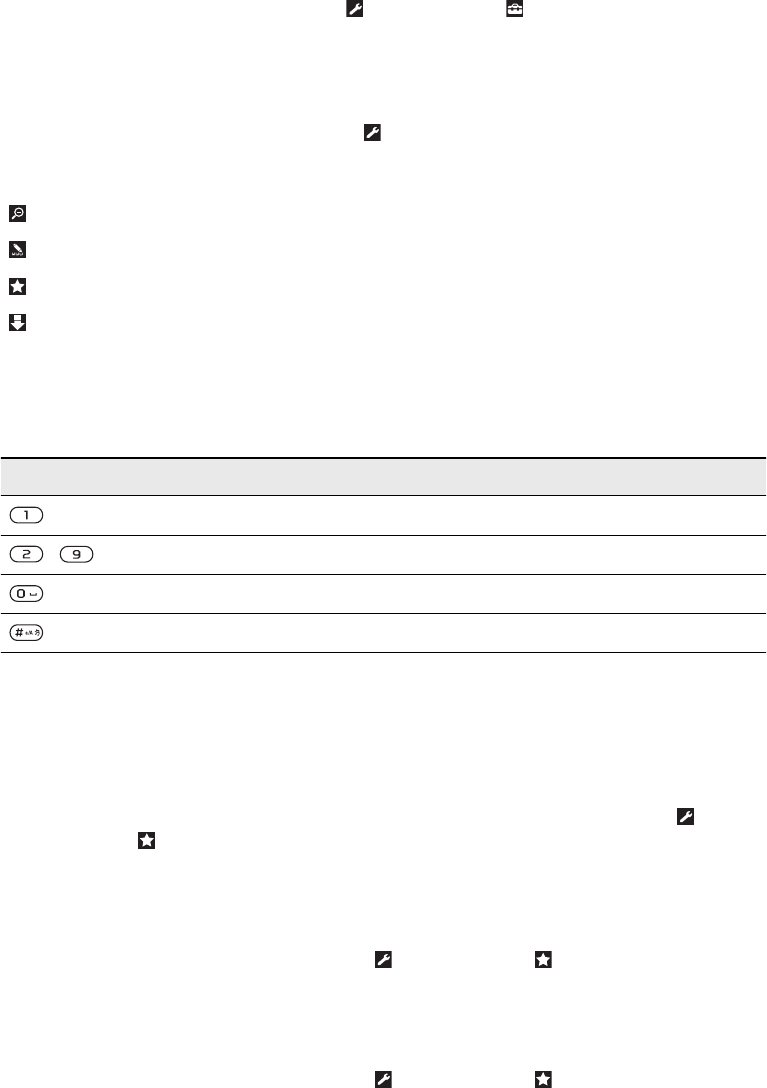
Internet
If you cannot use the Internet, see I cannot use Internet-based services on page 60.
To start browsing
1Select Menu > Internet.
2Enter a web address, a search phrase or the name of a bookmark.
3Scroll to an item in the list and select Go to or Search.
To exit the browser
1When you are browsing the web, select and then select .
2Select Exit browser.
To access the web browser toolbar
When you are viewing a web page, select . The following options appear:
Icon Function
Pan and zoom the web page
Search the web or enter a web address
Manage your favourite web pages
Manage the files you have downloaded from the Internet
Web browser shortcuts
You can use the keypad to go directly to a web browser function.
Key Shortcut
Bookmarks
- Enter text to enter an address, search the Internet or search in Bookmarks
Zoom
Overview (when Smart-Fit is off)
Bookmarks
You can create and edit bookmarks as quick links to your favourite web pages.
To create a bookmark
1When you are viewing a web page you want to add to your bookmarks, select
and then select .
2Select Add as bookmark.
To select a bookmark
1Select Menu > Internet Service.
2When you are browsing the Internet, select and then select .
3Scroll to a bookmark and select Go to.
To send a bookmark
1Select Menu > Internet Service.
2When you are browsing the Internet, select and then select .
3Scroll to a bookmark, then select Options.
4Select Send and select a transfer method.
45
This is an Internet version of this publication. © Print only for private use.

History pages
You can view and go to web pages you have previously visited.
To view history pages
1Select Menu > Internet Service.
2Select and then select .
3Select History.
More browser features
To turn on or off Smart-Fit Rendering™
1Select Menu > Internet Service.
2Select and then select .
3Select Settings > Smart-Fit.
4Select an option.
To use pan and zoom on a web page
1When you are viewing a web page, select and then select .
2Use the navigation key to move the frame.
3Press the centre selection key to zoom in on a part of the web page.
To use pan and zoom, Smart-Fit must be turned off.
To make a call when you are browsing the web
•Press .
To save a picture from a web page
1When you are viewing a web page, select and then select .
2Select Save picture.
3Select a picture.
To find text on a web page
1When viewing a web page, select and then select .
2Select Find on page.
3Enter text and select Find.
To send a link
1When you are viewing a web page, select and then select .
2Select Send link and select a transfer method.
Make sure the receiving device supports the transfer method you select.
Internet security and certificates
Your phone supports secure browsing. Certain Internet services, such as banking, require
certificates in your phone. Your phone may already contain certificates when you buy it or
you can download new certificates.
To view certificates in the phone
•Select Menu > Settings > General > Security > Certificates.
File transfers
The File transfer manager keeps track of the files you download from the Internet, for
example, media files, podcasts and games, and helps you access the files. It also tracks
your photo uploads to web sites, such as web albums and blogs. In the File transfer
manager you can also install downloaded Java applications, and to pause, resume or
cancel downloads.
46
This is an Internet version of this publication. © Print only for private use.

To access a file using File transfer
1Select Menu > Organiser > File transfer.
2Scroll to the file.
3Press the centre selection key to access the file, or select Options for other actions.
Web feeds
Using web feeds, you can subscribe to and download frequently updated content, such
as news, podcasts or photos.
To add new feeds from a web page
1When you browse a page on the Internet that provides web feeds, indicated by ,
select and then .
2For each feed you want to add, scroll to the feed and select Add > Yes.
3Select an update frequency.
To search for web feeds
1Select Menu > Media > Web feeds.
2Select New feed and enter a web address.
To download content via web feeds
1Select Menu > Media > Web feeds.
2Select Options >Update feed.
3Scroll to an updated feed and select View.
4Scroll to a heading by pressing the navigation key left or right.
5Scroll to the item you want to download by pressing the navigation key downwards,
then select Options > Download file.
You can access downloaded files from the File transfer manager. See File transfers on
page 46.
You can also subscribe to and download web feed content to a computer using the Media Go™
application. See To transfer content using Media Go™ on page 37.
Updating web feeds
You can manually update your feeds, or schedule updates. When updates arrive,
appears on the screen.
To schedule web feed updates
1Select Menu > Media > Web feeds.
2Scroll to a feed and select Options > Schedule update.
3Select an option.
Frequent updates may be costly.
Web feeds in standby
You can show news updates on the standby screen using the ticker application.
This application may not be available in all markets.
To show web feeds in standby
1Select Menu > Media > Web feeds.
2Scroll to a feed and select Options > Settings > Standby ticker > Show in
standby.
To access web feeds from standby
1From standby, select Ticker.
2To read more about a feed, press the navigation key upwards or downwards to scroll
to a headline, then select View.
47
This is an Internet version of this publication. © Print only for private use.
Podcasts
Podcasts are files, for example, radio programmes or video content, that you can download
and play. You subscribe to and download podcasts using web feeds.
To access audio podcasts
•Select Menu > Media > Music > Music feeds.
To access video podcasts
•Select Menu > Media > Video > Video feeds.
48
This is an Internet version of this publication. © Print only for private use.
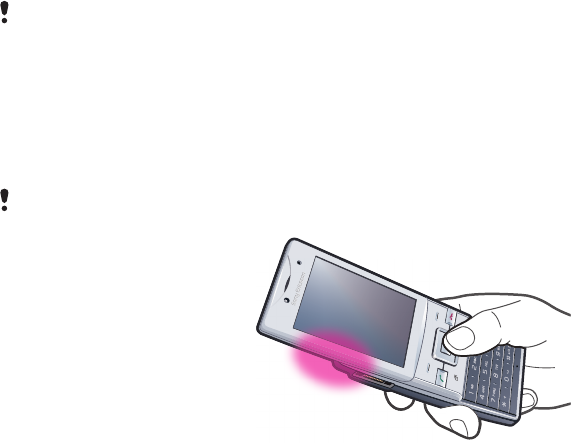
GPS
Your phone has a GPS receiver that uses satellite signals to calculate your location. Some
GPS features use the Internet. Data rates and charges may apply.
If you cannot use some GPS features, see I cannot use Internet-based services on page 60.
Using GPS
Your location can be found when you have a clear view of the sky. If your location is not
found after a few minutes, move to another location. To help the search, stand still and do
not cover the GPS antenna.
The first time you use the GPS it may take up to 10 minutes before your location is found.
Saving locations
You can find all saved locations in My favourites.
To save your current location
1Select Menu > Location services > My favourites > Add new place.
2Select Edit and enter the title. Select OK.
3Scroll to Description: and select Add.
4Enter the description and select OK.
5Scroll to Position: and select Add > Current position.
6When the position is found, select Save.
To view a saved location on a map
1Select Menu > Location services > My favourites.
2Scroll to a location and select Go to.
Location requests
External services may ask for your location. You can allow external services to use
information about your location, as well as restrict them from doing so.
To change access for external services
1Select Menu > Location services > Settings > Privacy.
2Select an option.
Turning off GPS
The GPS receiver turns off automatically when it is not in use. You can also turn the GPS
receiver off manually. This saves battery power when you use features that do not require
the GPS receiver to find your location.
To turn on or off GPS manually
1Select Menu > Location services > Settings.
2Select Enable GPS or Disable GPS.
49
This is an Internet version of this publication. © Print only for private use.

Tracker
Tracker is a GPS-based sports application which allows you to keep track of your speed,
distance, route and energy consumption during training. You can base the training on how
long time you want to train or on what distance you want to cover. You can also base it on
a previous training route which has GPS data.
Information provided by use of the Tracker application is approximate. Sony Ericsson makes no
warranty of any kind with respect to the accuracy of the Tracker application. Any serious health
and fitness concerns should be referred to a health care professional.
To start a training session
1Select Menu > Location services > Tracker > Start training.
2Select a training type.
3Scroll to an item, select Edit and enter the data.
4To save, select Done.
5To start training, select Start.
To switch between training views
•During a training session, press the navigation key left or right to view information on
training duration, progress and live comparison with a previous session.
To compare results during training
1Select Menu > Location services > Tracker > Start training.
2Select Route based.
3Scroll to Route:, select Edit and select a route.
4Scroll to Live compare and select Edit.
5Scroll to the result you want to compare and select Compare.
6Select Done and then Start.
A GPS location is required before results can be compared.
To end a training session manually
•During a training session, select Pause > End.
Results
The training result is shown after a session is ended. You can view past results anytime,
and compare them if they have GPS data.
To view a training result
1Select Menu > Location services > Tracker > Results.
2Scroll to a month and select View.
3Scroll to a date and select View.
4Select a training result. If you have used laps, press the navigation key left or right
to view result per lap.
To compare results
1Select Menu > Location services > Tracker > Results.
2Scroll to a result and select Options > Compare.
3Select a result to compare with.
A GPS location is required before results can be compared.
Energy consumption
To calculate and view the energy consumption for a session you must first set your personal
profile in Settings in Tracker. You view the energy consumption in the result view.
To set the personal profile
1Select Menu > Location services > Tracker > Settings > Personal profile.
2Select an item, enter data and select OK.
3When finished, select Options > Save profile.
50
This is an Internet version of this publication. © Print only for private use.
To turn on energy consumption
•Select Menu > Location services > Tracker > Settings > Energy consumption
> On.
51
This is an Internet version of this publication. © Print only for private use.

Synchronising
You can synchronise your phone in two different ways: using a computer program, or using
an Internet service.
Use only one of the synchronisation methods at a time with your phone.
For more information, go to www.sonyericsson.com/support to read the Synchronisation
Feature guide.
Synchronising using a computer
You can use a USB cable or Bluetooth wireless technology to synchronise phone contacts,
appointments, bookmarks, tasks and notes using an online service or a computer program
such as the Microsoft® Outlook® application.
Before synchronising, you need to install the Sony Ericsson PC Suite. Sony Ericsson PC
Suite software is available for download through PC Companion or from
www.sonyericsson.com/support
.
Mac® compatible software is also available for download at
www.sonyericsson.com/support
.
To synchronise using the Sony Ericsson PC Suite
1Computer: Start Sony Ericsson PC Suite from Start/Programs/Sony Ericsson/
Sony Ericsson PC Suite.
2Follow the instructions in the Sony Ericsson PC Suite for how to connect.
3When you are notified that the Sony Ericsson PC Suite has found your phone, you
can start synchronising.
For usage details, see the Sony Ericsson PC Suite Help section once the software has been
installed on your computer.
Synchronising using an Internet service
You can synchronise your phone data through an Internet service using SyncML™, or you
can use a Microsoft® Windows® Server in combination with the Microsoft® Exchange
ActiveSync® application. For more information, go to www.sonyericsson.com/support to
read the Synchronisation Feature guide.
52
This is an Internet version of this publication. © Print only for private use.

More features
Flight mode
In Flight mode the network and radio transceivers are turned off to prevent disturbance to
sensitive equipment.
When the flight mode menu is activated you are asked to select a mode the next time you
turn on your phone:
•Normal mode – full functionality
•Flight mode – limited functionality
To activate the flight mode menu
•Select Menu > Settings > General > Flight mode > Continue > Show at
startup.
To select flight mode
1When the flight mode menu is activated, turn off your phone.
2Turn on your phone and select Flight mode. appears.
Alarms
You can set a sound or the radio as an alarm signal. The alarm sounds even if the phone
is turned off. When the alarm sounds, you can silence it or turn it off.
To set the alarm
1Select Menu > Organiser > Alarms.
2Scroll to an alarm and select Edit.
3Scroll to Time: and select Edit.
4Enter a time and select OK > Save.
To set the recurrent alarm
1Select Menu > Organiser > Alarms.
2Scroll to an alarm and select Edit.
3Scroll to Recurrent: and select Edit.
4Scroll to a day and select Mark.
5To select another day, scroll to the day and select Mark.
6Select Done > Save.
To set the alarm signal
1Select Menu > Organiser > Alarms.
2Scroll to an alarm and select Edit.
3Scroll to the tab.
4Scroll to Alarm signal: and select Edit.
5Find and select an alarm signal. Select Save.
To silence the alarm
•When the alarm sounds, press any key.
•To repeat the alarm, select Snooze.
To turn off the alarm
•When the alarm sounds, press any key, then select Turn off.
To cancel the alarm
1Select Menu > Organiser > Alarms.
2Scroll to an alarm and select Turn off.
53
This is an Internet version of this publication. © Print only for private use.

To set the snooze duration
1Select Menu > Organiser > Alarms.
2Scroll to an alarm and select Edit.
3Scroll to Snooze duration: and select Edit.
4Select an option.
The alarm in silent mode
You can set the alarm not to sound when the phone is in silent mode.
To set an alarm to sound or not in silent mode
1Select Menu > Organiser > Alarms.
2Scroll to an alarm and select Edit.
3Scroll to the tab.
4Scroll to Silent mode: and select Edit.
5Select an option.
Calendar
You can synchronise your phone calendar with a computer calendar, with a calendar on
the web or with the Microsoft® Outlook® application.
Appointments
You can add new appointments or reuse existing appointments.
To add an appointment
1Select Menu > Calendar.
2Select a date.
3Scroll to New entry and select Add.
4Enter the information and confirm each entry.
5Select Save.
To view an appointment
1Select Menu > Calendar.
2Select a date.
3Scroll to an appointment and select View.
To edit an appointment
1Select Menu > Calendar.
2Select a date.
3Scroll to an appointment and select View.
4Select Options > Edit.
5Edit the appointment and confirm each entry.
6Select Save.
To set when reminders should sound
1Select Menu > Calendar.
2Select a date.
3Select Options > Advanced > Reminders.
4Select an option.
A reminders option set in the Calendar application affects a reminders option set in Tasks.
Notes
You can make notes and save them. You can also show a note in the standby view.
54
This is an Internet version of this publication. © Print only for private use.

To add a note
1Select Menu > Organiser > Notes.
2Scroll to New note and select Add.
3Write a note and select Save.
To show a note in standby
1Select Menu > Organiser > Notes.
2Scroll to a note and select Options > Show in standby.
To hide a note shown in standby
1Select Menu > Organiser > Notes.
2Scroll to the note shown in standby. This is marked with the icon . Select Options >
Hide in standby.
Tasks
You can add new tasks or reuse existing tasks.
To add a task
1Select Menu > Organiser > Tasks.
2Select New task and select Add.
3Select an option.
4Enter details and confirm each entry.
To set when reminders should sound
1Select Menu > Organiser > Tasks.
2Scroll to a task and select Options > Reminders.
3Select an option.
A reminders option set in Tasks affects a reminders option set in Calendar.
Profiles
You can change settings such as the ring volume and vibrating alert to suit different
locations. You can reset all profiles to the phone’s original settings.
To select a profile
1Select Menu > Settings > General > Profiles.
2Select a profile.
To view and edit a profile
1Select Menu > Settings > General > Profiles.
2Scroll to a profile and select Options > View and edit.
You cannot rename the Normal profile.
Time and date
To set the time
1Select Menu > Settings > General > Time & date > Time.
2Enter the time and select Save.
To set the date
1Select Menu > Settings > General > Time & date > Date.
2Enter the date and select Save.
55
This is an Internet version of this publication. © Print only for private use.

To set the time zone
1Select Menu > Settings > General > Time & date > My time zone.
2Select the time zone you are in.
If you select a city, My time zone also updates the time when daylight saving time changes.
To change the clock size displayed on the standby screen
1Select Menu > Settings > Display > Clock size.
2Select an option.
This application may not be available in all markets.
Themes
You can change the appearance of the screen using options such as different colours and
wallpaper. You can also create new themes and download them. For more information, go
to www.sonyericsson.com/fun.
To set a theme
1Select Menu > Settings > Display > Theme.
2Scroll to a theme and select Set.
Main menu layout
You can change the layout of the icons in the main menu.
To change the main menu layout
1Select Menu > Options > Main menu layout.
2Select an option.
Screen orientation
You can change between landscape and portrait orientation.
To change screen orientation in the browser
1Select Menu > Internet Service.
2Select and then select .
3Select Settings > the Browsing tab > Display orientation.
4Select an option.
To change screen orientation in Media
1Select Menu > Media > Settings > Orientation.
2Select an option.
Ringtones
To set a ringtone
1Select Menu > Settings > Sounds & alerts > Ringtone.
2Find and select a ringtone.
To set the ringtone volume
1Select Menu > Settings > Sounds & alerts > Ring volume.
2Press the navigation key left or right to adjust the volume.
3Select Save.
56
This is an Internet version of this publication. © Print only for private use.

To turn off the ringtone
•Press and hold down . appears.
The alarm signal is not affected.
To set the vibrating alert
1Select Menu > Settings > Sounds & alerts > Vibrating alert.
2Select an option.
Games
Your phone contains preloaded games. You can also download games. For more
information, go to www.sonyericsson.com/fun. Help texts are available for most games.
To start a game
1Select Menu > Media > Games.
2Select a game.
To end a game
•Press .
Applications
You can download and run Java™ applications. You can also view information or set
different permissions. If you cannot use Java applications, see I cannot use Internet-based
services on page 60.
To select a Java application
1Select Menu > Organiser > Applications.
2Select an application.
To set permissions for a Java application
1Select Menu > Organiser > Applications.
2Scroll to an application and select Options > Permissions.
3Set permissions.
Java application screen size
Some Java applications are designed for a specific screen size. For more information,
contact the application vendor.
This application may not be available in all markets.
To set the screen size for a Java application
1Select Menu > Organiser > Applications.
2Scroll to an application and select Options > Screen size.
3Select an option.
To set a Java™ application as a wallpaper
1Select Menu > Settings > Display.
2Select Wallpaper > Application.
3Select a Java application.
You can only see the Java applications that have support for wallpaper.
Antivirus
Antivirus identifies and removes applications you install on your phone that become infected
by viruses. It automatically scans applications during installation. When an infected
application is detected, you can delete or release the infected application. You can select
57
This is an Internet version of this publication. © Print only for private use.

a 30-day free evaluation or enter a subscription number. We recommend that you update
the antivirus application with the latest virus protection frequently. You need the correct
Internet settings in your phone to use this function.
Our inclusion or your use of antivirus software does not ensure that your use of this product will
be free from exposure to viruses, malware or other harmful software.
To turn on Antivirus scanning
1Select Menu > Settings > General > Security > Antivirus.
2Follow the instructions to use the setup wizard.
To turn off Antivirus scanning
1Select Menu > Settings > General > Security > Antivirus > Virus scan.
2Select Off.
PIN codes
SIM protection
This lock only protects your subscription. Your phone will work with a new SIM card. If the
lock is on, you have to enter a PIN (Personal Identity Number).
If you enter your PIN incorrectly three times in a row, the SIM card is blocked and you need
to enter your PUK (Personal Unblocking Key). Your PIN and PUK are supplied by your
network operator.
To unblock the SIM card
1When PIN blocked appears, enter your PUK and select OK.
2Enter a new four-to-eight-digit PIN and select OK.
3Re-enter the new PIN and select OK.
To edit the PIN
1Select Menu > Settings > General > PIN codes > SIM protection > Change
PIN.
2Enter your PIN and select OK.
3Enter a new four-to-eight-digit PIN and select OK.
4Re-enter the new PIN and select OK.
If Codes do not match appears, you entered the new PIN incorrectly. If Incorrect PIN appears,
you entered the old PIN incorrectly.
To use the SIM card lock
1Select Menu > Settings > General > PIN codes > SIM protection > Protection.
2Select an option.
3Enter your PIN and select OK.
Phone protection
You can stop unauthorised use of your phone by activating phone lock protection. After
activating, you will be asked to enter your phone lock code every time you restart the phone.
The default phone lock code is 0000. It is recommended that you change this to any four-
to-eight-digit personal code.
It is important that you remember your new code. If you forget it, you need to take your phone
to your local Sony Ericsson retailer.
58
This is an Internet version of this publication. © Print only for private use.

To activate the phone lock
1Select Menu > Settings > General > PIN codes > Phone protection >
Protection.
2Select On if you want to enter a lock code every time you start the phone, or select
Automatic if you want the code to be entered only when the phone restarts after a
new SIM card is inserted.
3Enter the phone lock code (0000 by default) and select OK.
To unlock the phone
•When Phone locked appears, enter your phone lock code and select OK.
To change the phone lock code
1Select Menu > Settings > General > PIN codes > Phone protection > Change
code.
2Enter the old code and select OK.
3Enter the new code and select OK.
4Repeat the code and select OK.
Keypad lock
You can set the keypad lock to avoid accidental dialling. appears. Incoming calls can
be answered without unlocking the keypad.
Calls to the international emergency number 112 can still be made.
To use the automatic keylock
1Select Menu > Settings > General > Automatic keylock.
2Select an option.
To unlock the keypad manually
•Press any key and select Unlock > OK.
IMEI number
To view your IMEI number
•Press , , , , .
59
This is an Internet version of this publication. © Print only for private use.
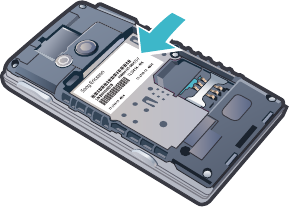
Troubleshooting
Some problems can be fixed using Update Service. Using Update Service on a regular
basis will optimise the phone’s performance. See Updating your phone on page 40.
Some problems will require you to call your network operator.
For more support go to www.sonyericsson.com/support.
Common questions
Where can I find the regulatory information such as my IMEI number if
I cannot turn on my phone?
I have problems with memory capacity or the phone is working slowly
Restart your phone every day to free memory or do a Master reset.
Master reset
If you select Reset settings, the changes that you have made to settings will be deleted.
If you select Reset all, your settings and content, such as contacts, messages, pictures,
sounds and downloaded games, will be deleted. You may also lose content that was in the
phone at purchase.
To reset the phone
1Select Menu > Settings > General > Master reset.
2Select an option.
3Follow the instructions that appear.
I cannot charge the phone or battery capacity is low
The charger is not properly connected or the battery connection is poor. Remove the
battery and clean the connectors.
The battery is worn out and needs to be replaced. See Charging the battery on page 8.
No battery icon appears when I start charging the phone
It may take a few minutes before the battery icon appears on the screen.
Some menu options appear in grey
A service is not activated. Contact your network operator.
I cannot use Internet-based services
Your subscription does not include data capability. Settings are missing or incorrect.
You can download settings using the Settings download or from
www.sonyericsson.com/support.
You can download settings from www.sonyericsson.com/support.
60
This is an Internet version of this publication. © Print only for private use.
I cannot send messages from my phone
To send messages, you need to set a service centre number. The number is supplied by
your service provider and is usually saved on the SIM card. If the number of your service
centre is not saved on your SIM card, you must enter the number yourself.
To send most picture messages, you must set an MMS (Multimedia Messaging Service)
profile and the address of your message server. If no MMS profile or message server exists,
you can receive all the settings automatically from your network operator by going to
www.sonyericsson.com/support.
To enter a service centre number
1Select Menu > Settings > Connectivity > Message settings > Text message and
scroll to Service centre. The number is shown if it is saved on the SIM card.
2If there is no number shown, select Edit.
3Scroll to New service centre and select Add.
4Enter the number, including the international “+” sign and country code.
5Select Save.
To select an MMS profile
1Select Menu > Settings > Connectivity > Message settings > Multim.
message.
2Select an existing profile or create a new one.
To set the message server address
1Select Menu > Settings > Connectivity > Message settings > Multim.
message.
2Scroll to a profile and select Options > Edit.
3Scroll to Message server and select Edit.
4Enter the address and select OK > Save.
The phone does not ring or rings too softly
Make sure that Silent mode has not been set to On. See To turn off the ringtone on
page 57.
Check the ringtone volume. See To set the ringtone volume on page 56.
Check the profile. See To select a profile on page 55.
Check the divert call options. See To divert calls on page 22.
The phone cannot be detected by other devices using Bluetooth
wireless technology
You have not turned the Bluetooth function on. Make sure that the visibility is set to Show
phone. See To turn on the Bluetooth™ function on page 38.
I cannot synchronise or transfer content between my phone and the
computer, when using a USB cable.
The software or the USB drivers have not been properly installed. Go to
www.sonyericsson.com/support to read Feature guides which contain detailed installation
instructions and troubleshooting sections.
How do I use my new Sony Ericsson mobile phone to upload photos to
photo.blog.sina.com?
First, make sure that you have registered for an account on photo.blog.sina.com. Then you
have to link up your mobile phone number with photo.blog.sina.com to be able to use this
function. Follow these steps to link up:
61
This is an Internet version of this publication. © Print only for private use.
1On your computer, register and log in at photo.blog.sina.com, and then click on the
Upload Photos button. Click on the Link up your mobile phone for free link in the
upload page.
2Enter your mobile phone number in the upload page, and then click the Save button.
Now your mobile phone number is linked up with photo.blog.sina.com!
3Use your mobile phone to edit a multimedia message and send it to
1066888817102. This picture will appear in your default album on
photo.blog.sina.com. The title and text of the multimedia message will become the
title and description of the photo on photo.blog.sina.com. (Sina.com does not
charge anything for you to send photos from your cell phone to photo.blog.sina.com,
but local telecom operators will charge transmission fees according to their own
policies.)
Follow these steps when you want to cancel the link or if you need to change the number
of the linked-up mobile phone:
1. Log in to photo.blog.sina.com and click on the Upload Photos button. Click on the
Cancel link to mobile phone link in the upload page.
2. Click the OK button, and the link between your mobile phone number and
photo.blog.sina.com will be canceled.
SMS/MMS Blogging Services Activation Instructions for blog.163.com
Please first log in to the 163.com SMS/MMS blogging services page to start the activation
process:
1Register/log in at 163.com, then go to the SMS blogging services page (http://blog.
163.com/services/emsblog.html?fromservices), and click Free Activation of SMS
Blogging.
2Enter your account number, password, and mobile phone number, and then click
Next.
3After clicking Get Activation Code For Free, you will receive a six-digit activation
code via SMS; enter this code in the box provided and click Next.
4When you see the Phone Activation Complete page, then your cell phone has been
successfully activated for SMS/MMS blogging services, and you can start blogging
right away.
About the fees:
1. There is no monthly service charge for SMS/MMS blogging; 163.com does not charge
any fees.
2. Telecom charges are the same as those for SMS/MMS messages sent to other phones,
and are determined by your telecom provider (China Mobile or China Unicom).
There is no charge for undelivered messages; incoming messages are free.
Error messages
Insert SIM
There is no SIM card in your phone or you may have inserted it incorrectly.
See To insert the SIM card on page 6.
The SIM card connectors need cleaning. If the card is damaged, contact your network
operator.
Insert correct SIM card
Your phone is set to work only with certain SIM cards. Check if you are using the correct
operator SIM card.
Incorrect PIN/Incorrect PIN2
You have entered your PIN or PIN2 incorrectly.
Enter the correct PIN or PIN2 and select OK.
62
This is an Internet version of this publication. © Print only for private use.
PIN blocked/PIN2 blocked
You have entered your PIN or PIN2 code incorrectly three times in a row.
To unblock, see SIM protection on page 58.
Codes do not match
Codes that you have entered do not match. When you want to change a security code, for
example your PIN, you have to confirm the new code. See SIM protection on page 58.
No netw. coverage
•Your phone is in flight mode. See Flight mode on page 53.
•Your phone is not receiving any network signal, or the received signal is too weak. Contact
your network operator and make sure that the network has coverage where you are.
•The SIM card is not working properly. Insert your SIM card in another phone. If this works,
it is probably your phone that is causing the problem. Please contact the nearest
Sony Ericsson service location.
PUK blocked. Contact operator.
You have entered your personal unblocking key code (PUK) incorrectly 10 times in a row.
63
This is an Internet version of this publication. © Print only for private use.
Legal information
Sony Ericsson J20
This User guide is published by Sony Ericsson Mobile Communications AB or its local affiliated company, without any
warranty. Improvements and changes to this User guide necessitated by typographical errors, inaccuracies of current
information, or improvements to programs and/or equipment, may be made by Sony Ericsson Mobile Communications
AB at any time and without notice. Such changes will, however, be incorporated into new editions of this User guide.
All rights reserved.
©Sony Ericsson Mobile Communications AB, 2010
Publication number: 1235-4763.1
Your mobile phone has the capability to download, store and forward additional content, e.g. ringtones. The use of
such content may be restricted or prohibited by rights of third parties, including but not limited to restriction under
applicable copyright laws. You, and not Sony Ericsson, are entirely responsible for additional content that you
download to or forward from your mobile phone. Prior to your use of any additional content, please verify that your
intended use is properly licensed or is otherwise authorized. Sony Ericsson does not guarantee the accuracy, integrity
or quality of any additional content or any other third party content. Under no circumstances will Sony Ericsson be
liable in any way for your improper use of additional content or other third party content.
This User Guide may reference services or applications provided by third parties. Use of such programming or services
may require separate registration with the third party provider and may be subject to additional terms of use. For
applications accessed on or through a third-party website, please review such website’s terms of use and applicable
privacy policy in advance. Sony Ericsson does not warrant or guaranty the availability or performance of any third-
party websites or offered services.
Smart-Fit Rendering is a trademark or a registered trademark of ACCESS Co., Ltd.
Bluetooth is a trademark or a registered trademark of Bluetooth SIG Inc. and any use of such mark by
Sony Ericsson is under license.
The Liquid Identity logo, Hazel , PlayNow and TrackID are trademarks or registered trademarks of Sony Ericsson
Mobile Communications AB.
TrackID™ is powered by Gracenote Mobile MusicID™. Gracenote and Gracenote Mobile MusicID are trademarks or
registered trademarks of Gracenote, Inc.
Sony and "make.believe" are trademarks or registered trademarks of Sony Corporation.
Media Go is a trademark or registered trademark of Sony Media Software and Services.
microSD is a trademark or a registered trademark of SanDisk Corporation.
PictBridge is a trademark or registered trademark of Canon Kabushiki Kaisha Corporation.
Google Maps™ is a trademark or registered trademark of Google, Inc.
Lotus Notes is a trademark or a registered trademark of International Business Machines Corporation.
SyncML is a trademark or registered trademark of Open Mobile Alliance LTD.
Ericsson is a trademark or registered trademark of Telefonaktiebolaget LM Ericsson.
Mac is a trademark of Apple Computer, Inc., registered in the U.S. and other countries.
Adobe Photoshop Album Starter Edition is a trademark or registered trademark of Adobe Systems Incorporated in
the United States and/or other countries/regions.
Microsoft, Windows, Outlook, Windows Vista, Windows Server and ActiveSync are registered trademarks or
trademarks of Microsoft Corporation in the United States and/or other countries/regions.
This product is protected by certain intellectual property rights of Microsoft. Use or distribution of such technology
outside of this product is prohibited without a license from Microsoft.
Content owners use Windows Media digital rights management technology (WMDRM) to protect their intellectual
property, including copyrights. This device uses WMDRM software to access WMDRM-protected content. If the
WMDRM software fails to protect the content, content owners may ask Microsoft to revoke the software's ability to
use WMDRM to play or copy protected content. Revocation does not affect unprotected content. When you download
licenses for protected content, you agree that Microsoft may include a revocation list with the licenses. Content owners
may require you to upgrade WMDRM to access their content. If you decline an upgrade, you will not be able to access
content that requires the upgrade.
This product is licensed under the MPEG-4 visual and AVC patent portfolio licenses for the personal and non-
commercial use of a consumer for (i) encoding video in compliance with the MPEG-4 visual standard ("MPEG-4 video")
or the AVC standard ("AVC video") and/or (ii) decoding MPEG- 4 or AVC video that was encoded by a consumer
engaged in a personal and non-commercial activity and/or was obtained from a video provider licensed by MPEG LA
to provide MPEG-4 and/or AVC video. No license is granted or shall be implied for any other use. Additional information
including that relating to promotional, internal and commercial uses and licensing may be obtained from MPEG LA,
L.L.C. See http://www.mpegla.com. MPEG Layer-3 audio decoding technology licensed from Fraunhofer IIS and
Thomson.
Java, JavaScript and Java-based trademarks and logos are trademarks or registered trademarks of Sun
Microsystems, Inc. in the U.S. and other countries/regions.
End-user license agreement for Sun Java Platform, Micro Edition.
1. Restrictions: Software is confidential copyrighted information of Sun and title to all copies is retained by Sun and/
or its licensors. Customer shall not modify, decompile, disassemble, decrypt, extract, or otherwise reverse engineer
Software. Software may not be leased, assigned, or sublicensed, in whole or in part.
2. Export Regulations: This product, including any software or technical data contained in or accompanying the
product, may be subject to import and export regulations of the European Union, the United States and other
countries/regions. The user and any possessor of the product agrees to comply strictly with all such regulations and
acknowledges that it is their responsibility to obtain any required licenses to export, re-export, or import this product.
Without limiting the foregoing, and as an example, the user and any possessor of the product: (1) must not knowingly
export or re-export Products to destinations identified pursuant to Articles in Chapter II of European Council Regulation
(EC) 1334/2000; (2), must comply with U.S. government Export Administration Regulations ("EAR", 15 C.F.R. §§
730-774, http://www.bis.doc.gov/ ) administered by Department of Commerce, Bureau of Industry and Security; and
(3) must comply with economic sanctions regulations (30 C.F.R. §§ 500 et. seq.,., http://www.treas.gov/offices/
enforcement/ofac/) administered by the U.S. Department of Treasury, Office of Foreign Assets Control. The user and
any possessor of the product may not transport or deliver the product, its accessories or separate software to any
country, region, entity or person prohibited by these regulations..
Restricted Rights: Use, duplication or disclosure by the United States government is subject to the restrictions as set
forth in the Rights in Technical Data and Computer Software Clauses in DFARS 252.227-7013(c) (1) (ii) and FAR
52.227-19(c) (2) as applicable.
Includes "protobuf-c", http://code.google.com/p/protobuf-c/.
Copyright 2008, Dave Benson.
Licensed under the Apache License, Version 2.0 (the "License"); you may not use this file except in compliance with
the License. You may obtain a copy of the License at http://www.apache.org/licenses/LICENSE-2.0.
Unless required by applicable law or agreed to in writing, software distributed under the License is distributed on an
“AS IS” BASIS, WITHOUT WARRANTIES OR CONDITIONS OF ANY KIND, either express or implied. See the License
for the specific language governing permissions and limitations under the License.
Other product and company names mentioned herein may be the trademarks of their respective owners.
Any rights not expressly granted herein are reserved.
Note: Sony Ericsson advises users to backup their personal data information.
All illustrations are for illustration only and may not accurately depict the actual phone.
64
This is an Internet version of this publication. © Print only for private use.
SMS Registration: In order to provide faster and better quality after-sale services, an SMS will be sent automatically
by the phone (The SMS expense is upon the mobile fee bill from the operator) to the server of Sony Ericsson Mobile
Communications (China) Co., Ltd. once the phone is in use. The relevant information of the SMS will be stored and
used for after-sales service management by Sony Ericsson.
To use some pre-loaded applications (e.g. TrackID, MSN) you need first activate data service. Using data services
(GPRS or 3G services) may incur data traffic fee. Please contact your network operator for expense details.
Please visit www.sonyericsson.com/cn to get the latest version of this User's Guide.
65
This is an Internet version of this publication. © Print only for private use.
Index
A
activity menu ...........................................................13
alarms ......................................................................53
answering service ....................................................21
antivirus ...................................................................57
applications .............................................................57
appointment ............................................................54
audio book ..............................................................33
automatic email checking .......................................43
B
background music ...................................................17
backing up and restoring ........................................39
battery
capacity .............................................................8
charging ............................................................9
inserting .............................................................7
blog .........................................................................29
Bluetooth™ wireless technology .............................38
bookmarks ...............................................................45
business card ..........................................................21
C
calendar ...................................................................54
call divert .................................................................22
call list ......................................................................18
call numbers in message .........................................41
call time ...................................................................24
caller-specific ringtones ..........................................20
calls
accepting .........................................................24
answering and rejecting ..................................17
emergency .......................................................18
putting on hold ................................................23
recording .........................................................35
video ................................................................18
camera .....................................................................25
printing ............................................................28
clip ...........................................................................29
conference calls ......................................................23
contacts
adding phone contacts ...................................19
default contacts ...............................................19
groups .............................................................21
smart search ....................................................19
conversations ..........................................................42
costs ..........................................................................8
D
date .........................................................................55
download
files ..................................................................46
music ...............................................................33
E
email ........................................................................42
emergency numbers ................................................18
F
face detection ..........................................................26
file manager .............................................................36
file transfers .............................................................46
flight mode ..............................................................53
G
games ......................................................................57
geo tagging .............................................................28
GPS .........................................................................49
groups .....................................................................21
H
handsfree ...........................................................22, 31
help ............................................................................8
hiding your phone number ......................................24
I
imaging ....................................................................25
IMEI number ............................................................59
Internet ....................................................................46
bookmarks ......................................................45
screen orientation ............................................56
security and certificates ..................................46
settings ............................................................60
K
keypad lock .............................................................59
keys ...........................................................................6
L
language ..................................................................14
location services ......................................................49
lock
keypad .............................................................59
SIM card ..........................................................58
M
master reset ............................................................60
Media Go™ .............................................................37
media transfer .........................................................37
memory ...................................................................13
memory card ...........................................................13
memory status .........................................................20
menu overview ........................................................11
messages
email ................................................................42
picture .............................................................41
text ..................................................................41
voice ................................................................42
microphone .............................................................17
MMS See picture messages
model name ...............................................................8
music feed .........................................................46, 48
music player ............................................................31
SensMe™ technology .....................................32
my numbers .............................................................23
my phone number .....................................................8
N
navigating menus ....................................................12
notes ........................................................................54
O
online
music ...............................................................34
video clips .......................................................34
P
pan and zoom
web pages .......................................................46
PC Companion ........................................................37
PC Suite ..................................................................52
phone
turning on ..........................................................7
phone memory ....................................................8, 13
phone name ............................................................38
photo .......................................................................29
photo feed ...............................................................46
photo fix ..................................................................26
photos .....................................................................27
66
This is an Internet version of this publication. © Print only for private use.
geo tagging .....................................................28
improving .........................................................26
printing ............................................................28
tags ..................................................................28
picture messages ....................................................41
pictures ..............................................................27, 29
PIN .......................................................................7, 58
playlists ....................................................................31
PlayNow™ ...............................................................33
podcasts ............................................................46, 48
power saving ...........................................................38
profiles .....................................................................55
protection
phone ..............................................................58
PUK .........................................................................58
push email ...............................................................43
Q
Quick text input .......................................................14
R
radio ........................................................................34
recording
listening to .......................................................35
restricted dialling .....................................................24
ringtones ..................................................................56
setting ..............................................................56
roaming .....................................................................8
RSS feeds - see web feeds
S
Scenes .....................................................................26
screen icons ............................................................10
screen orientation ....................................................56
search
on web pages ..................................................46
selection keys ..........................................................12
SensMe™ technology .............................................32
setting
ringtones .........................................................56
settings
Internet ............................................................60
shortcuts .................................................................12
web browser ....................................................45
SIM card
copying to/from ...............................................20
inserting .............................................................6
locking .............................................................58
unblocking .......................................................58
SMS See text messages
SOS See emergency numbers
sound recorder ........................................................35
speed dialling ..........................................................21
standby ......................................................................7
notes ................................................................55
still camera ..............................................................25
streaming .................................................................34
synchronising ..........................................................52
T
tagging photos ........................................................27
tasks ........................................................................55
text messages .........................................................41
themes .....................................................................56
time ....................................................................55, 56
time zone .................................................................56
Tracker ....................................................................50
TrackID™ technology ..............................................33
training .....................................................................50
transfer methods
Bluetooth™ wireless technology .....................38
USB cable .......................................................36
transferring
music ...............................................................37
photos .............................................................37
sound ..............................................................38
transferring content .................................................36
turning on/off
Bluetooth™ function .......................................38
phone lock .......................................................59
SIM lock protection .........................................58
U
updating phone software ........................................40
USB cable ...............................................................36
V
video ........................................................................29
video camera ...........................................................27
video feed ................................................................46
video player .............................................................30
video recorder .........................................................25
video ringtones ........................................................56
voice control ............................................................22
voice messages .......................................................42
voicemail .................................................................21
volume
ear speaker ......................................................17
ringtone ...........................................................56
W
web ..........................................................................46
web album ...............................................................29
web feeds ................................................................47
web pages history ...................................................46
web site ...................................................................29
Z
zoom ........................................................................25
67
This is an Internet version of this publication. © Print only for private use.
08 user manual part1

Hazel™
Extended User guide
Contents
Getting started..............................................................................5
Phone overview...................................................................................6
Turning on the phone..........................................................................7
Help....................................................................................................8
Charging the battery...........................................................................8
Maximising battery performance.........................................................9
Screen icons.....................................................................................10
Menu overview..................................................................................11
Navigation.........................................................................................12
Memory............................................................................................13
Phone language................................................................................14
Entering text......................................................................................14
Chinese input....................................................................................15
Calling..........................................................................................17
Making and answering calls..............................................................17
Contacts ..........................................................................................19
Speed dial.........................................................................................21
More calling features.........................................................................21
Imaging .......................................................................................25
Viewfinder and camera keys..............................................................25
Using the still camera........................................................................25
Using the video camera.....................................................................27
Working with photos.........................................................................27
Viewing and tagging photos..............................................................27
Using photos.....................................................................................28
Printing photos..................................................................................28
Using web albums............................................................................29
Accessing videos in your phone........................................................29
Music ..........................................................................................31
Stereo portable handsfree.................................................................31
Music player......................................................................................31
Playlists.............................................................................................31
SensMe™ technology.......................................................................32
Audio books......................................................................................33
Buy Now...........................................................................................33
PlayNow™ application......................................................................33
TrackID™ application .......................................................................33
Online music and video clips.............................................................34
Radio ...............................................................................................34
2
This is an Internet version of this publication. © Print only for private use.
Recording sound ..............................................................................35
Transferring and handling content...........................................36
Handling content in the phone..........................................................36
Sending content to another phone....................................................36
Using a USB cable............................................................................36
Transferring content to and from a computer....................................37
Phone name.....................................................................................38
Using Bluetooth™ wireless technology..............................................38
Backing up and restoring..................................................................39
Updating your phone.................................................................40
Updating your phone using Sony Ericsson PC Suite..........................40
Messaging...................................................................................41
Text and picture messages...............................................................41
Conversations...................................................................................42
Voice messages................................................................................42
Email.................................................................................................42
Internet .......................................................................................45
To access the web browser toolbar..................................................45
Web browser shortcuts.....................................................................45
Bookmarks.......................................................................................45
History pages....................................................................................46
More browser features......................................................................46
Internet security and certificates........................................................46
File transfers......................................................................................46
Web feeds........................................................................................47
GPS..............................................................................................49
Using GPS........................................................................................49
Tracker.............................................................................................50
Synchronising.............................................................................52
Synchronising using a computer.......................................................52
Synchronising using an Internet service.............................................52
More features.............................................................................53
Flight mode.......................................................................................53
Alarms..............................................................................................53
Calendar...........................................................................................54
Notes................................................................................................54
Tasks................................................................................................55
Profiles..............................................................................................55
Time and date...................................................................................55
Themes.............................................................................................56
Main menu layout..............................................................................56
Screen orientation.............................................................................56
3
This is an Internet version of this publication. © Print only for private use.
Ringtones..........................................................................................56
Games..............................................................................................57
Applications......................................................................................57
Antivirus............................................................................................57
PIN codes.........................................................................................58
Keypad lock......................................................................................59
IMEI number.....................................................................................59
Troubleshooting.........................................................................60
Common questions...........................................................................60
Error messages.................................................................................62
Legal information.......................................................................64
Index............................................................................................66
4
This is an Internet version of this publication. © Print only for private use.
Getting started
Important information
Please read the Important information leaflet before you use your mobile phone.
5
This is an Internet version of this publication. © Print only for private use.
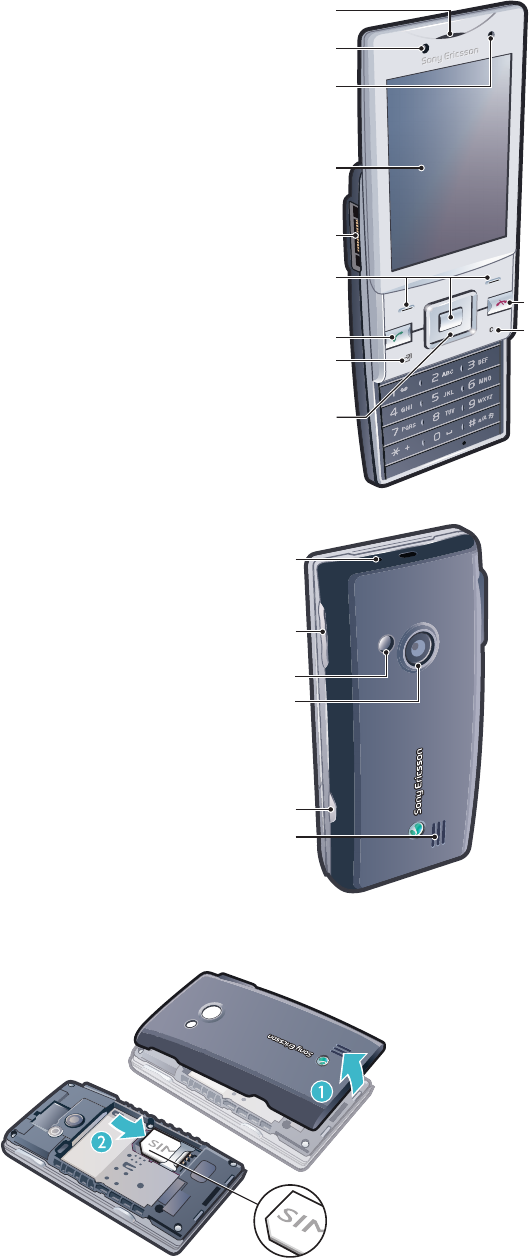
Phone overview
1 Ear speaker
1
3
6
2
4
5
7
8
9
10
11
2 Video call camera
3 Light sensor
4 Screen
5 Connector for charger, handsfree, and USB cable
6 Selection keys
7 Call key
8 Activity menu key
9 Navigation key
10 End key, On/off key
11 C key (Clear)
12 Strap hole
12
13
16
17
14
15
13 Volume, digital zoom key
14 Flash light
15 Main camera lens
16 Camera key
17 Speaker
To insert the SIM card
1Remove the battery cover.
2Slide the SIM card into its holder with the gold-coloured contacts facing down.
6
This is an Internet version of this publication. © Print only for private use.
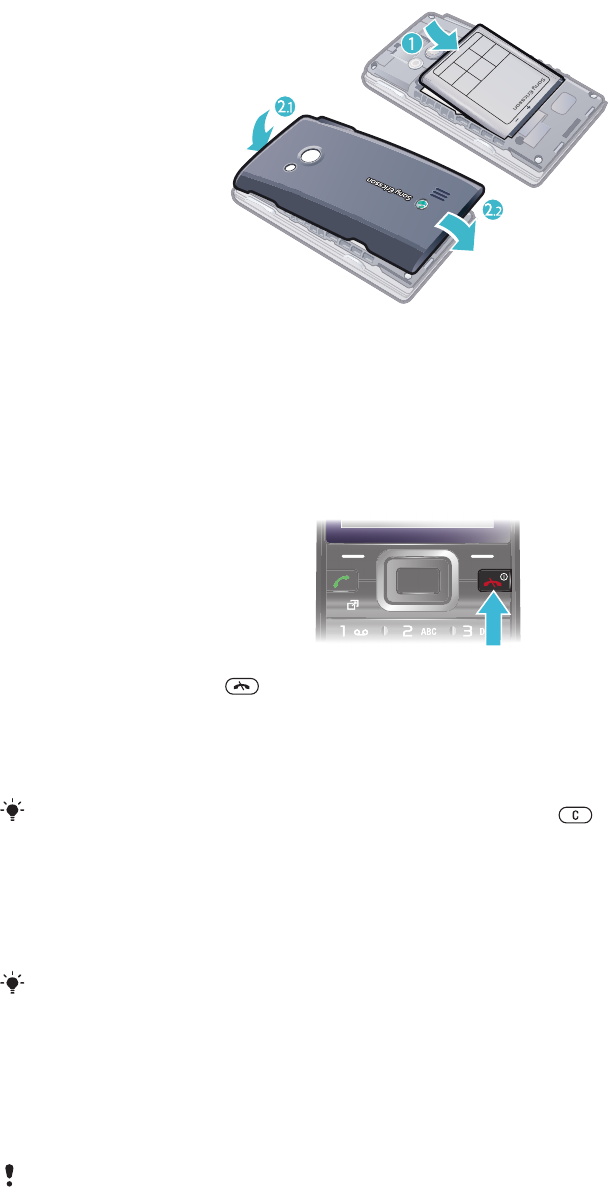
To insert the battery
1Insert the battery with the label side up and the connectors facing each other.
2Attach the battery cover.
Turning on the phone
To turn on the phone
1Press and hold down .
2Enter your SIM card PIN (Personal Identification Number), if requested, and select
OK.
3Select a language.
4Follow the instructions that appear.
If you want to correct a mistake when you enter your PIN, press .
SIM card
The SIM (Subscriber Identity Module) card, which you get from your network operator,
contains information about your subscription. Always turn off your phone and detach the
charger before you insert or remove the SIM card.
You can save contacts on the SIM card before you remove it from your phone.
PIN
You may need a PIN (Personal Identification Number) to activate the services and functions
in your phone. Your PIN is supplied by your network operator. Each PIN digit appears as
*, unless it starts with emergency number digits, for example, 112 or 911. You can see and
call an emergency number without entering a PIN.
If you enter the wrong PIN three times in a row, the SIM card is blocked. See SIM protection on
page 58.
Standby
After you have turned on your phone and entered your PIN, the name of the network
operator appears. This view is called standby. Your phone is now ready for use.
7
This is an Internet version of this publication. © Print only for private use.

Widget Manager
You can show, hide or add widgets by using Widget Manager. A widget is a live update on
a website, web page or desktop. Widgets contain personalised content or applications
selected by the user.
To manage widgets
1From standby, press the navigation key up.
2Select Manage. Widget icons appear.
3To select a widget, press the navigation key left or right.
4Select Hide to hide a widget or Show if you want the widget to appear in the standby
screen.
To start a widget
1From standby, press the navigation key up.
2To select a widget, press the navigation key left or right.
3Press Select to start the widget.
Using other networks
Making and receiving calls, using messaging and data transfer, for example, Internet-based
services, outside your home network (roaming) may incur additional costs. Contact your
operator for more information.
Help
In addition to this User guide, Feature guides and more information are available at
www.sonyericsson.com/cn.
There are also help functions and a User guide in your phone. See the following instructions
on how to access them.
To access the User guide in your phone
•Select Menu > Settings > User help > User guide.
To view tips and tricks
•Select Menu > Settings > User help > Tips and tricks.
To view information about functions
•Scroll to a function and select Info, if available. In some cases, Info appears under
Options.
To view the phone demonstration
•Select Menu > Entertainment > Demo tour.
To view the phone status
•Press the volume key. Phone, memory and battery information is shown.
Supported services and features
Some of the services and features described in this User guide are not supported by all networks
and/or service providers in all areas. Without limitation, this applies to the GSM International
Emergency Number 112. Please contact your network operator or service provider to determine
availability of any specific service or feature and whether additional access or usage fees apply.
Charging the battery
The phone battery is partly charged when you buy it.
It may take 30 minutes for the battery icon to appear on the screen.
8
This is an Internet version of this publication. © Print only for private use.
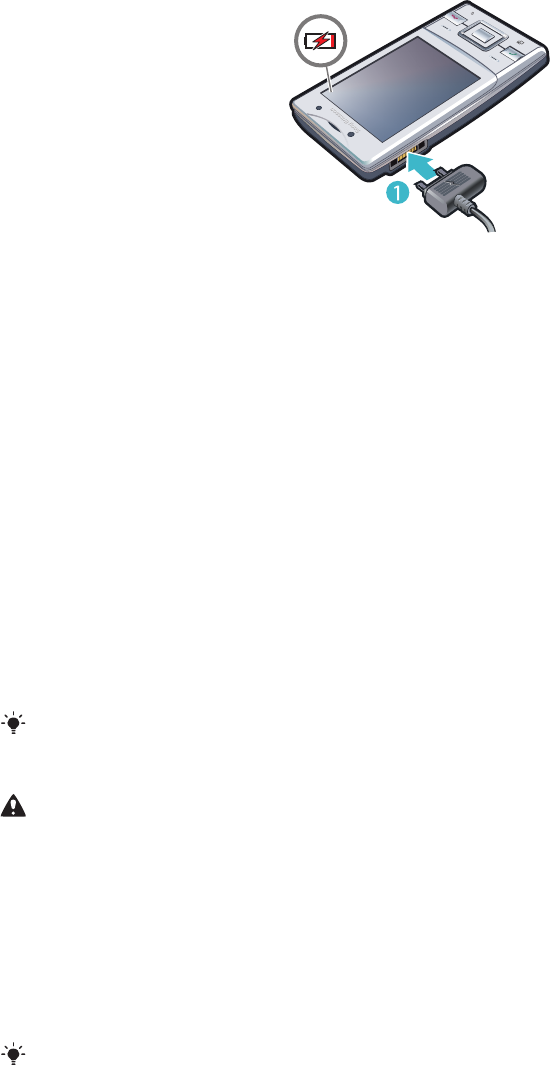
To charge the battery
1Connect the charger to the phone.
2Remove the charger by tilting the plug upwards.
Note
•If there are two USB cables in the kit (a USB cable for charging and a USB cable for data
transfer), the USB cable for charging is only intended for charging your phone. Do not
use it for transferring data. The USB cable for the USB charger is only intended for
connection to the AC adapter to charge your phone. It must not be used for connection
to a computer. It can only be used for charging your phone. Never use it for charging
accessories.
•If there is only one USB cable in the kit, it is intended for charging your phone as well as
transferring data.
•If there is only one USB cable for the USB charger in the phone kit, this USB cable is only
intended for charging your phone.
•To charge your phone, Sony Ericsson strongly recommends that you use only
Sony Ericsson branded original batteries, a power supply which is in accordance
with specification YD/T 1591-2006 (a Communications Industry standard of P. R.
China) , and the USB cable supplied with your phone. The use of third-party products
may decrease the performance of your phone and/or pose a risk to your health or safety
You can charge the battery for more or less than 3 hours. Interrupted charging does not damage
the battery. Performance depends on temperatures, signal strength, usage patterns, features
selected and voice or data transmissions. The standby time for this battery is up to 400 hours.
Use only Sony Ericsson branded original batteries intended for use with your mobile phone. If
you use other batteries you may not be able to charge your phone.
Maximising battery performance
•Charge your phone often. The battery lasts longer if you charge it frequently.
•If you are in an area with no coverage, your phone repeatedly scans for available networks.
This consumes power. If you cannot move to an area with better coverage, turn off your
phone temporarily.
•Do not cover the phone antenna when you are engaged in a call.
Go to
www.sonyericsson.com/support
to learn more about how to maximise the battery
performance.
9
This is an Internet version of this publication. © Print only for private use.
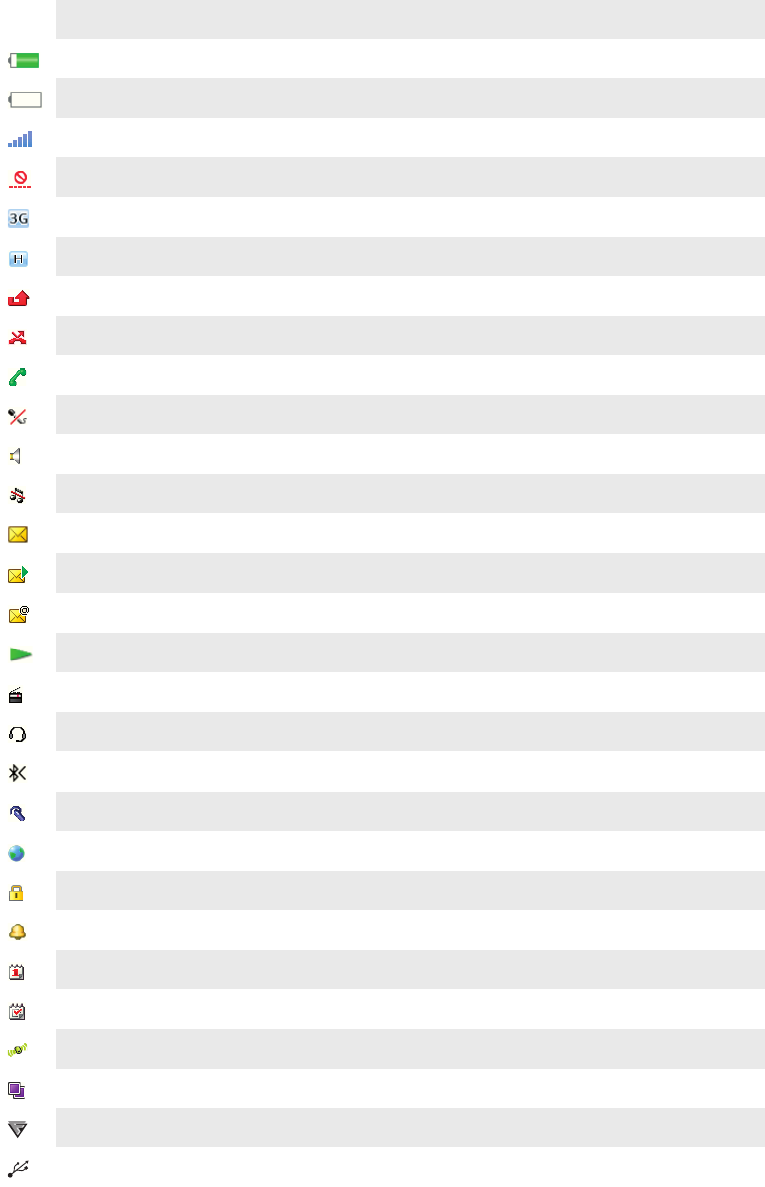
Screen icons
These icons may appear on the screen:
Icon Description
The battery is almost fully charged
The battery needs charging
The network coverage is good
No network coverage (also shown in flight mode)
A 3G network is available
A UMTS HSPA network is available
Missed calls
Calls diverted
Ongoing call
The microphone is muted
The loudspeaker is on
The phone is in silent mode
New text message
New multimedia message
New email
The music player is playing
The radio is playing
A handsfree is connected
The Bluetooth function is activated
A Bluetooth headset is connected
The phone is connected to the Internet
Secure website
An alarm is activated
Appointment reminder
Task reminder
GPS is activated
A Java™ application is activated
Activating Antivirus
USB cable is connected
10
This is an Internet version of this publication. © Print only for private use.
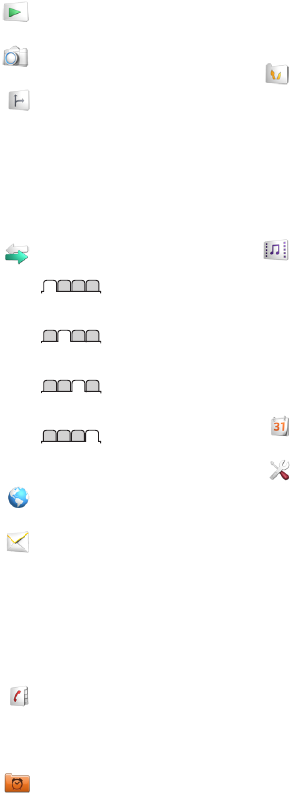
Menu overview*
PlayNow™
Camera
Location services
Google Maps
Navigation
Tracker
My favourites
Settings
Calls**
All
Answered
Dialled
Missed
Internet
Messaging
Write new
Inbox/Conversations
Messages
Email
Call voicemail
Contacts
Myself
New contact
Organiser
Alarms
Applications
File manager **
File transfer
Tasks
Notes
Media Home
Synchronisation
Timer
Stopwatch
Torch
Calculator
Entertainment
Online services
Radio
TrackID™
Games
Record sound
Demo tour
Media
Photo
Music
Video
Games
Web feeds
Settings
Calendar
Settings
General
Profiles
Time & date
Language
Update software
Voice control
Shortcuts
Flight mode
Automatic keylock
PIN codes
Security
Accessibility
Phone status
Master reset
Sounds & alerts
Ring volume
Ringtone
Silent mode
Increasing ring
Vibrating alert
Message alert
Key sound
Display
Wallpaper
Main menu layout
Theme
Startup screen
Screen saver
Clock size
Brightness
Edit line names
Calls
Speed dial
Smart search
Divert calls
Switch to line 2
Manage calls
Time
Show/hide my no.
Handsfree
Open to answer
Close to end call
Connectivity
Bluetooth
USB
Phone name
Content sharing
Synchronisation
Device management
Mobile networks
Data communication
Internet settings
Streaming settings
Message settings
SIP settings
Accessories
User help
User guide
Basic setup
Tips and tricks
* Some menus are operator-,
network- and subscription-
dependent.
** You can use the navigation
key to scroll between tabs in
submenus.
11
This is an Internet version of this publication. © Print only for private use.
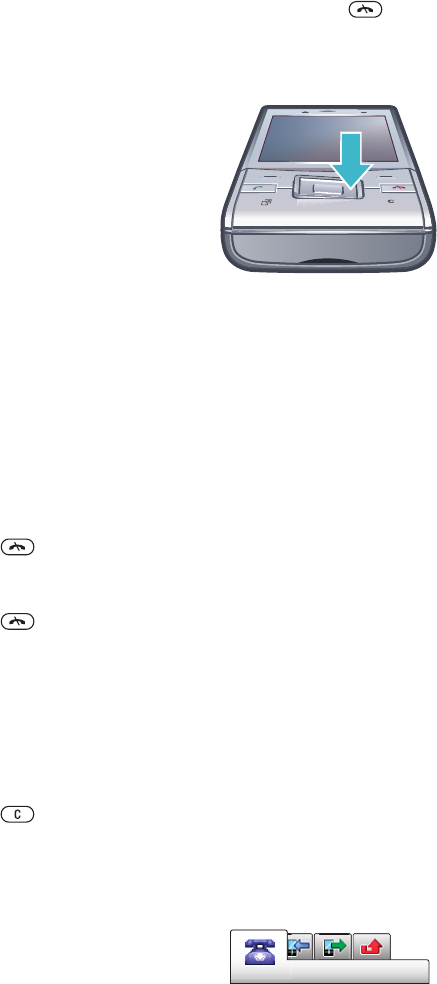
Navigation
To access the main menu
•When Menu appears on the screen, press the centre selection key to select
Menu.
•If Menu does not appear on the screen, press , and then press the centre
selection key to select Menu.
To navigate the phone menus
•Press the navigation key upwards, downwards, left or right to move through the
menus.
To select actions on the screen
•Press the left, centre or right selection key.
To view options for an item
•Select Options to, for example, edit.
To end a function
•Press .
To return to standby
•Press .
To navigate your media
1Select Menu > Media.
2Scroll to a menu item and press the navigation key right.
3To go back, press the navigation key left.
To delete items
•Press to delete items such as numbers, letters, pictures and sounds.
Tabs
Tabs may be available. For example, Calls have tabs.
To scroll between tabs
•Press the navigation key left or right.
Shortcuts
You can use the navigation key shortcuts to go directly to functions from standby.
To use navigation key shortcuts
•Press the navigation key upwards, downwards, left or right to go directly to a
function.
12
This is an Internet version of this publication. © Print only for private use.
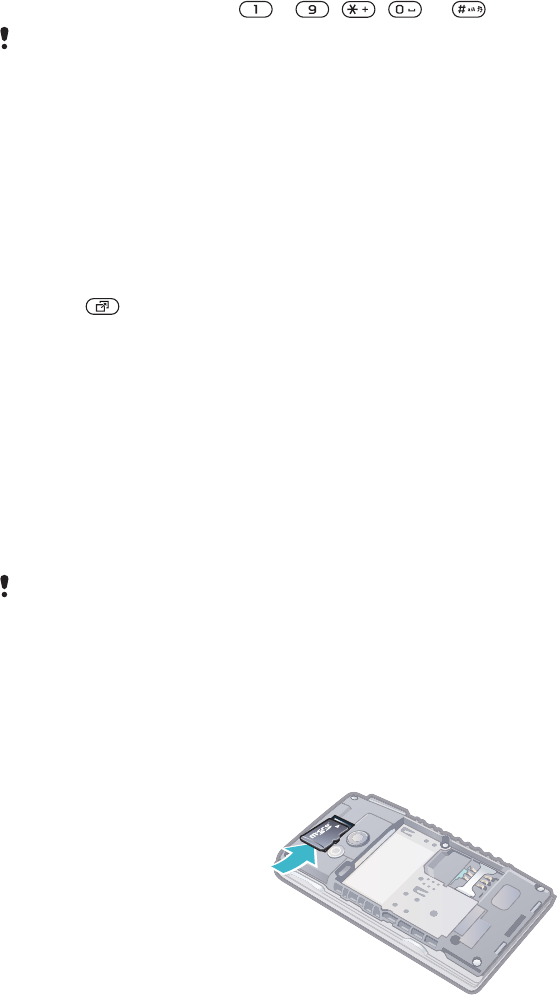
To edit a navigation key shortcut
1Select Menu > Settings > General > Shortcuts.
2Scroll to an option and select Edit.
3Scroll to a menu option and select Shortc..
Main menu shortcuts
Menu numbering starts from the top left icon and moves across and then down row by
row.
To go directly to a main menu item
•Select Menu and press – , , or .
The Main menu layout must be set to Grid. See To change the main menu layout on page 56.
Activity menu
The activity menu gives you quick access to:
•New events – missed calls and new messages.
•Running apps – applications that are running in the background.
•My shortcuts – add your favourite functions to access them quickly.
•Internet – connect conveniently to the Internet.
To open the activity menu
•Press .
Memory
You can save content on a memory card, in the phone memory and on the SIM card. Photos
and music are saved on the memory card, if a memory card is inserted. If not, or if the
memory card is full, photos and music are saved in the phone memory. Messages and
contacts are saved in the phone memory, but you can choose to save them on the SIM
card.
Memory card
You may have to purchase a memory card separately.
Your phone supports a microSD™ memory card, adding more storage space to your
phone. This type of card can also be used as a portable memory card with other compatible
devices.
You can move content between a memory card and the phone memory.
To insert a memory card
•Remove the battery cover and insert the memory card with the gold-coloured
contacts facing down.
13
This is an Internet version of this publication. © Print only for private use.
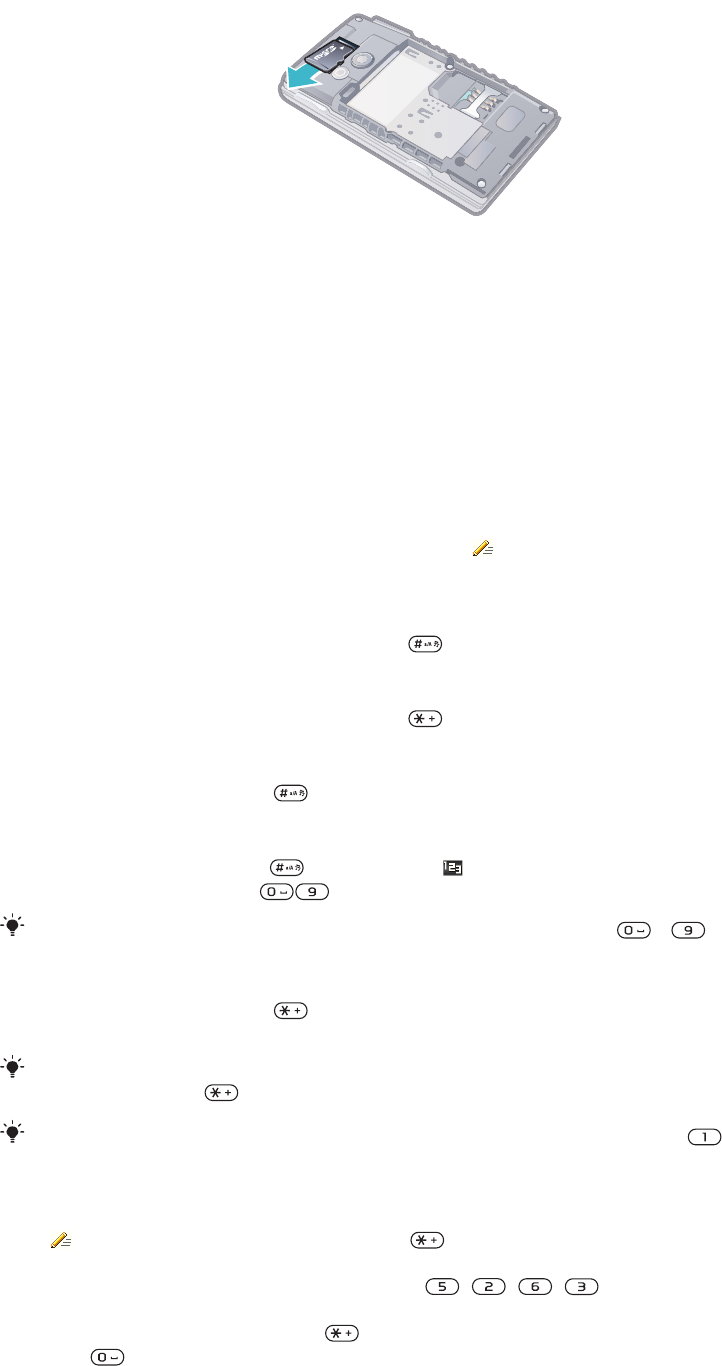
To remove a memory card
•Remove the battery cover and slide the memory card to remove it.
Phone language
You can select a language to use in your phone.
To change the phone language
1Select Menu > Settings > General > Language > Phone language.
2Select an option.
Entering text
You can use multitap text input or Quick text input to enter text. The Quick text input
method uses a dictionary application in your phone.
To change the writing language
•When you enter text, press and hold down .
To change the text input method
•When you enter text, press and hold down .
To shift between upper- and lower-case letters or numbers
•When you enter text, press .
To enter numbers
1When you enter text, press repeatedly until appears at the top of the screen.
2To enter a number, press .
To enter a number from text input mode, you can press and hold down – .
To enter punctuation marks and symbols
1When you enter text, press briefly.
2Scroll to a symbol and select Insert.
When you enter Chinese, you can insert full-size symbols such as
。
or
《
. To open the full-size
symbol table, press and select Full.
To select from the most commonly used punctuation marks, you can also press .
To enter text using Quick text input
1Select, for example, Menu > Messaging > Write new > Message.
2If is not displayed, press and hold down to change to Quick text input.
3Press each key only once, even if the letter you want is not the first letter on the key.
For example, to write the word “Jane”, press , , , . Write the whole
word before looking at the suggestions.
4To view word suggestions, press or press the navigation key downwards.
5Press to accept a suggestion and add a space.
14
This is an Internet version of this publication. © Print only for private use.

To enter text using the multitap method
1Select, for example, Menu > Messaging > Write new > Message.
2If is displayed, press and hold down to change to multitap text input.
3Press – repeatedly until the desired letter appears.
4Press to add a space.
Multitap input only applies when Latin characters are selected as input language.
To add words to the phone dictionary
1When you enter text using Quick text input, select Options > Spell word.
2Write the word using multitap input and select Save.
Chinese input
This mobile phone has different input methods for entering Chinese characters:
•Stroke input
•Pinyin input
You can use these methods, for example, to enter Chinese names and Chinese short
messages.
General instructions
Your phone has a function to speed up the entry of Chinese characters. Whenever you
enter a stroke or a Pinyin letter, a candidate row of the most frequently used characters
containing that stroke or relating to that letter appears at the bottom of the screen. Pressing
to present another candidate row. Continue pressing until the character you want is
displayed. Alternatively, you can enter the next stroke or Pinyin letter, and a new set of
characters will immediately be displayed in the candidate row. To go back to the previous
row, press . To select a character in the candidate row, press the navigation key or press
and hold the key corresponding to the number above the character you want to enter.
Stroke input
A Chinese character is built up of strokes which are grouped into five stroke categories.
Each category is represented on the keypad by one of the keys - . The Wild Card
key , is used when you are not sure of which stroke to use.
Components
Using components is a fast method for entering complex characters. After entering the first
two strokes of the desired character, the component and character candidates that started
with that stroke are displayed in the candidate row.
The smaller candidates surrounded by dotted frames are components, and the bigger candidates
without dotted frames are characters.
For example, to enter “ 信息”
1Enter “ ”, “ ” and “ ”.
2Move the cursor to “信”, press the centre selection key.
3Move the cursor to “息”, press the centre selection key again to select “ 息”.
Example of using the wild card key
The wild card key , is used to supplement unclear strokes in entering characters. If you
want to enter “互”, but you only know that “ 一” is the first and the last stroke of the character
and that the total number of strokes is four, enter , , , . The character is
displayed in the candidate row.
15
This is an Internet version of this publication. © Print only for private use.

Pinyin input
Press the keys containing the required Pinyin letters, and the phone will make various
proposals on the screen, according to the pronunciation rules of Mandarin.
On the keypad, the letter ü is replaced by v.
For example, to enter “ 信息”
1Press , , .
2When “xin” is highlighted, press or and select “ 信”, then press the centre
selection key. (If you want to enter any of the other suggested Pinyin combinations,
scroll up or down to the desired combination, then press the centre selection key.)
3Press the centre selection key again to select “ 息”, when “ 息” is highlighted.
Fuzzy Pinyin
In Fuzzy Pinyin, some spelling differences are ignored. For example, c and ch, z and zh,
n and ng. This is helpful when you are uncertain about the exact spelling of a character.
For example, you can enter
信
with either spelling xin or xing.
To turn on Fuzzy Pinyin
1When you enter text using Pinyin input, select Options > Writing settings > Fuzzy
Pinyin.
2Select On.
16
This is an Internet version of this publication. © Print only for private use.

Calling
You need to turn on your phone and be within range of a network.
Making and answering calls
To end a call
•Press .
To re-dial a number
•When Retry? appears, select Yes.
Do not hold your phone to your ear when waiting for the call to connect. When the call connects,
your phone gives a loud signal.
To answer a call
•Press .
To reject a call
•Press .
To change the ear speaker volume during a call
•Press the volume keys up or down.
To mute the microphone during a call
1Press and hold down . appears.
2Press and hold down again to resume.
To turn on the loudspeaker during a call
•Select Spkr on. appears.
Do not hold the phone to your ear when using the loudspeaker. This could damage your hearing.
To view missed calls from standby
• appears. Press to open the call list.
Background music
You can add background music to an ongoing call. When activated, background music
can be heard by all participants. When the microphone is muted, the background music
continues to play.
To start playing background music during a call
•During the call, select Music.
See To play music on page 31.
To stop playing background music during a call
•Press the centre selection key.
To change the background music volume during a call
•Press the volume key up or down.
Only the music volume can be changed when the music is playing.
Call sound quality
The Noise shield filters out sound around you that can make it difficult for the other party
to hear your voice, while the Clear Voice function helps you hear better in a crowded
environment. You can enable or disable these functions during a call.
17
This is an Internet version of this publication. © Print only for private use.

To turn off the Noise shield
•During a call, select Options > Noise shield off. The status icon on the screen
changes to .
To turn on Clear Voice
•During a call, select Options > Clear Voice on.
Video call
During a video call, the person you are talking to can see you on their screen.
Before making video calls
3G (UMTS) service is available when or appears. To make a video call, both parties
on the call must have a 3G (UMTS) phone subscription that supports 3G (UMTS) service
and 3G (UMTS) coverage.
To make a video call
1Enter a phone number (with international country code and area code, if applicable).
2Select Options > Make video call.
To use the zoom with an outgoing video call
•Press the navigation key upwards or downwards.
To share photos and videos during a video call
1During a video call, press the navigation key left to switch to the video share mode
tab.
2Scroll to a video clip or photo and select Share.
To view video call options
•During the call, select Options.
Emergency calls
Your phone supports international emergency numbers, for example, 112 or 911. You can
normally use these numbers to make emergency calls in any country, with or without the
SIM card inserted, if you are within range of a network.
In some countries, other emergency numbers may also be promoted. Your network operator may
therefore have saved additional local emergency numbers on the SIM card.
To make an emergency call
•Enter 112 (the international emergency number) and press .
To view your local emergency numbers
1Select Menu > Contacts.
2Scroll to New contact and select Options > Special numbers > Emergency
numbers.
Call list
You can view information about answered , dialled and missed or rejected calls.
To call a number from the call list
1Press and scroll to a tab.
2Scroll to a name or a number and press .
18
This is an Internet version of this publication. © Print only for private use.

Contacts
You can save names, phone numbers and personal information in Contacts. Information
can be saved in the phone memory or on the SIM card.
You can synchronise your contacts using the Sony Ericsson PC Suite. Add the area code when
you save fixed line numbers in your phone.
Default contacts
You can choose which contact information is shown by default. If Phone contacts is
selected as the default, only contact information saved to the phone memory is listed in
Contacts. If you select SIM contacts as the default, only names and numbers saved on
the SIM card are shown in Contacts.
To select default contacts
1Select Menu > Contacts.
2Scroll to New contact and select Options > Advanced > Default contacts.
3Select an option.
Phone contacts
Phone contacts can contain names, phone numbers and personal information. They are
saved in the phone memory.
To add a phone contact
1Select Menu > Contacts.
2Scroll to New contact and select Add.
3Enter the name and select OK.
4Scroll to New number: and select Add.
5Enter the number and select OK.
6Select a number option.
7Scroll between the tabs and add information to the fields.
8Select Save.
Calling contacts
To call a contact written in Chinese characters
1Select Menu > Contacts. Enter the entire multi-letter name, pure initial or mixed
initial Pinyin of Chinese contacts you want to call.
2When the contact is highlighted, press navigation key left or right to select a number.
Press the Call key.
To call a contact written in Latin letters
1Select Menu > Contacts. Scroll to, or enter the first letters or all letters of the contact
you want to call (a maximum of 10 letters).
2When the contact is highlighted, press the navigation key left or right to select a
number. Press the Call key.
The phone supports a mixed search of Chinese and English contacts. When a contact is written
in Latin characters, the entered letter can reach the Latin contact you want to call. When a contact
is written in Chinese characters, the entered letter can reach the Pinyin of the Chinese contact
you want to call.
To go directly to the contacts list
•Press and hold down – .
To make a call using Smart search
1Press – to enter a sequence of (at least two) digits. All entries that match
the sequence of digits, or corresponding letters, are shown in a list.
2Scroll to a contact or a phone number and press .
19
This is an Internet version of this publication. © Print only for private use.

To turn on or off Smart search
1Select Menu > Settings > Calls > Smart search.
2Select an option.
Editing contacts
To add information to a phone contact
1Select Menu > Contacts.
2Scroll to a contact and select Options > Edit contact.
3Scroll between the tabs and select Add or Edit.
4Select an option and an item to add or edit.
5Select Save.
If your subscription supports Calling Line Identification (CLI) services, you can assign personal
ringtones and pictures to contacts.
To copy names and numbers to phone contacts
1Select Menu > Contacts.
2Scroll to New contact and select Options > Advanced > Copy from SIM.
3Select an option.
To copy names and numbers to the SIM card
1Select Menu > Contacts.
2Scroll to New contact and select Options > Advanced > Copy to SIM.
3Select an option.
When you copy all contacts from your phone to the SIM card, all existing SIM card information
is replaced.
To automatically save names and phone numbers on the SIM card
1Select Menu > Contacts.
2Scroll to New contact and select Options > Advanced > Auto save on SIM.
3Select an option.
To save contacts on a memory card
1Select Menu > Contacts.
2Scroll to New contact and select Options > Advanced > Back up to m. card.
SIM contacts
SIM contacts can contain names and numbers only. They are saved on the SIM card.
To add a SIM contact
1Select Menu > Contacts.
2Scroll to New contact and select Add.
3Enter the name and select OK.
4Enter the number and select OK.
5Select a number option and add more information, if available.
6Select Save.
Deleting contacts
To delete all contacts
1Select Menu > Contacts.
2Scroll to New contact and select Options > Advanced > Delete all contacts.
3Select an option.
Contact memory status
The number of contacts you can save in your phone or on the SIM card depends on
available memory.
20
This is an Internet version of this publication. © Print only for private use.

To view contact memory status
1Select Menu > Contacts.
2Scroll to New contact and select Options > Advanced > Memory status.
Myself
You can enter information about yourself and, for example, send your business card.
To enter information in Myself
1Select Menu > Contacts.
2Scroll to Myself and select Open.
3Scroll to an option and edit the information.
4Select Save.
To add your own business card
1Select Menu > Contacts.
2Scroll to Myself and select Open.
3Scroll to My contact info and select Add > Create new.
4Scroll between the tabs and add information to the fields.
5Enter the information and select Save.
Groups
You can create a group of phone numbers and email addresses from Phone contacts to
send messages to. You can also use groups (with phone numbers) when you create
accepted callers lists.
To create a group of numbers and email addresses
1Select Menu > Contacts.
2Scroll to New contact and select Options > Groups.
3Scroll to New group and select Add.
4Enter a name for the group and select Continue.
5Scroll to New and select Add.
6For each contact phone number or email address you want to mark, scroll to it and
select Mark.
7Select Continue > Done.
Speed dial
Speed dialling lets you select nine contacts that you can dial quickly from standby. The
contacts can be saved in positions 1-9.
To assign speed dial numbers to contacts
1Select Menu > Contacts.
2Scroll to New contact and select Options > Speed dial.
3Scroll to a position number and select Add.
4Select a contact.
To speed dial
•Enter the position number and press .
More calling features
Voicemail
If your subscription includes an answering service, callers can leave a voicemail message
when you cannot answer a call.
21
This is an Internet version of this publication. © Print only for private use.

To enter your voicemail number
1Select Menu > Messaging > Messages > Settings > the Message settings tab
> Voicemail number.
2Enter the number and select OK.
To call your voicemail service
•Press and hold down .
Voice control
By creating voice commands you can:
•Voice dial – call someone by saying their name
•Answer and reject calls when you use a handsfree
To record a voice command using voice dialling
1Select Menu > Settings > General > Voice control > Voice dialling > Activate.
2Select Yes > New voice command and select a contact. If the contact has more
than one number, select the number to add the voice command to.
3Follow the instructions that appear. Wait for the tone and say the command to
record. Record a voice command such as “John mobile”. The voice command is
played back to you.
4If the recording sounds OK, select Yes. If not, select No and repeat steps 3 and 4.
Voice commands are saved in the phone memory only. They cannot be used in another phone.
To voice dial a contact
1Press and hold down a volume key.
2Wait for the tone and say a recorded voice command, for example “John mobile.”
The phone plays the command back to you and connects the call.
To activate voice answering and record voice answer commands
1Select Menu > Settings > General > Voice control > Voice answer > Activate.
2Follow the instructions that appear and select Continue. Wait for the tone and say
“Answer”, or say any other word.
3Select Yes to accept or No to make a new recording.
4Wait for the tone and say “Busy”, or say any other word.
5Select Yes to accept or No to make a new recording.
6Follow the instructions that appear and select Continue.
7Select the environments in which you want to activate voice answering.
To answer a call using voice commands
•Say “Answer.”
To re-record a voice command
1Select Menu > Settings > General > Voice control > Voice dialling > Edit
names.
2Scroll to a command and select Options > Replace voice.
3Wait for the tone and say the command.
Diverting calls
You can divert calls, for example, to an answering service.
When Restrict calls is used, some divert call options are not available.
To divert calls
1Select Menu > Settings > Calls > Divert calls.
2Select a call type and a divert option.
3Select Activate. appears.
4Enter the number to divert calls to and select OK.
22
This is an Internet version of this publication. © Print only for private use.

Call waiting
You will hear a beep if you receive a second call while call waiting is active.
To activate call waiting
•Select Menu > Settings > Calls > Manage calls > Call waiting > Activate.
More than one call
You can handle more than one call at a time. For example, you can put an ongoing call on
hold while you make or answer a second call. You can also switch between the two calls.
You cannot answer a third call without ending one of the first two calls.
To switch between two calls
•During the call, press .
To join two calls
•During the call, select Options > Join calls.
To end an ongoing call and return to the call on hold
•First press and then .
To make a second call
1During the call, press . This puts the ongoing call on hold.
2Select Options > Add call.
3Enter the number to call and press .
To answer a second call
•During the call, press . This puts the ongoing call on hold.
To reject a second call
•During the call, press and continue with the ongoing call.
To end an ongoing call and answer a second call
•During the call, select Replace active call.
Conference calls
With a conference call, you can have a joint conversation with up to five people.
To add a new participant
1During the call, press . This puts the joined calls on hold.
2Select Options > Add call.
3Enter the number to call and press .
4Select Options > Join calls to add the new participant.
5Repeat this task to add more participants.
To release a participant
1Select Options > Release party.
2Select the participant to release.
To have a private conversation
1During the call, select Options > Talk to and select the participant to talk to.
2To resume the conference call, select Options > Join calls.
My numbers
You can view, add and edit your own phone numbers.
23
This is an Internet version of this publication. © Print only for private use.

To check your phone numbers
1Select Menu > Contacts.
2Scroll to New contact and select Options > Special numbers > My numbers.
3Select an option.
Accept calls
You can choose to receive calls from certain phone numbers only.
To add numbers to the accepted callers list
1Select Menu > Settings > Calls > Manage calls > Accept calls > Only from list.
2Scroll to New and select Add.
3Select a contact or Groups.
To accept all calls
•Select Menu > Settings > Calls > Manage calls > Accept calls > All callers.
Restricted dialling
You can restrict outgoing and incoming calls. A password from your service provider is
required.
If you divert incoming calls, you cannot use some restrict calls options.
To restrict calls
1Select Menu > Settings > Calls > Manage calls > Restrict calls.
2Select an option.
3Select Activate.
4Enter your password and select OK.
Call time and cost
During a call, the phone shows how long you have been talking. You can also check on
the duration of your last call, your outgoing calls and the total time of all your calls.
To check the call time
•Select Menu > Settings > Calls > Time > Call timers.
Showing or hiding your phone number
You can decide to show or hide the number displayed on the call recipient's phone when
you make a call.
To hide your phone number
1Select Menu > Settings > Calls > Show/hide my no..
2Select Hide number.
24
This is an Internet version of this publication. © Print only for private use.
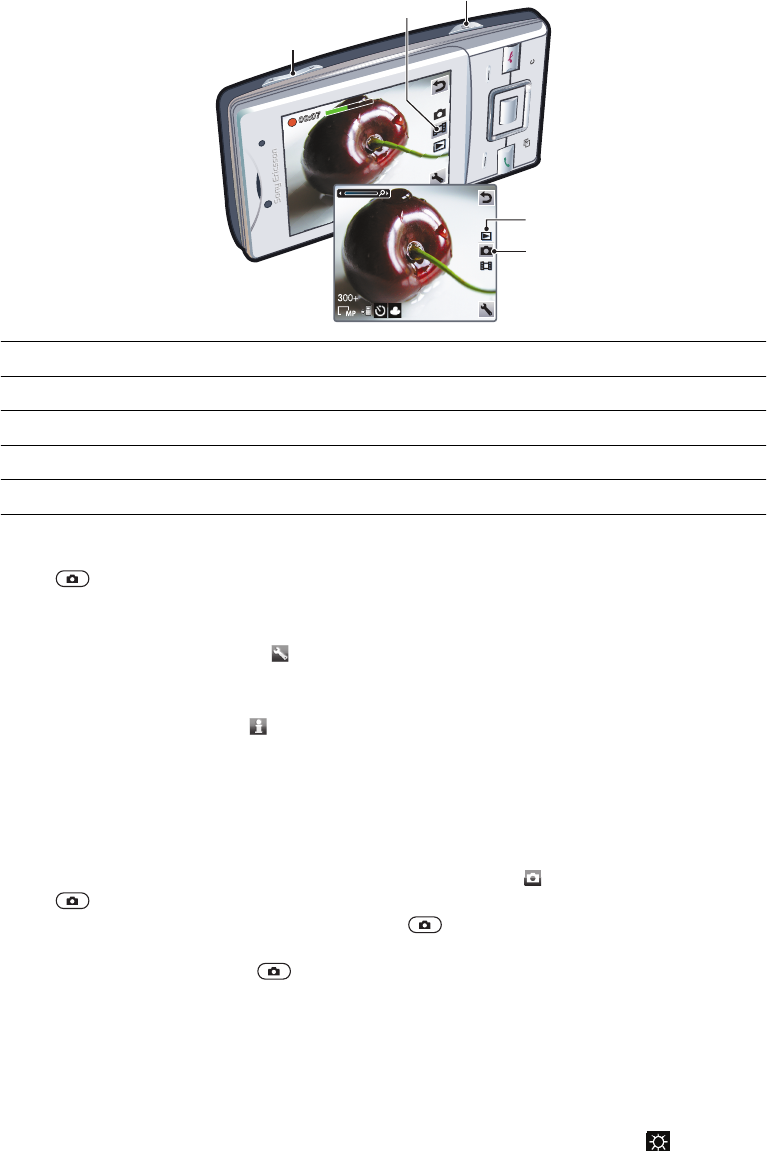
Imaging
You can take photos and record videos to view, save or send. You can find saved photos
and videos in Media and in File manager.
Viewfinder and camera keys
1
2
3
4
5
1 Zoom in or out
2 Indicates photo mode
3 View photos and video clips
4 Indicates video mode
5 Activate the camera/Take photos/Record video clips
To activate the camera
•Press .
To change settings
•Activate the camera and select .
To view information about settings
•Scroll to a setting and select .
Using the still camera
To take a photo
1Activate the camera and press the navigation key to scroll to .
2Press halfway down to use auto focus.
3When the dot and focus frame are green, press fully down to take a photo. The
photo is automatically saved.
4To take another photo, press to return to the viewfinder.
To use zoom
•Press the volume key.
To adjust brightness
•Press the navigation key left to decrease the brightness. Press the navigation key
right to increase the brightness. The level of brightness appears beside the .
25
This is an Internet version of this publication. © Print only for private use.

Face detection
You can use face detection to bring an off-centre face into focus. The camera automatically
detects up to three faces, indicated by white frames. A green frame shows which face has
been selected for focus. Focus is set to the face closest to the camera.
To set face detection
•Select > Focus > Face detection.
Smile detection
Smile detection allows you to capture the smiles of family and friends. The camera detects
up to three faces and selects one face for smile detection and auto focus. A yellow frame
shows which face is selected. When the selected face smiles, the camera automatically
takes a photo.
To set Smile detection
1Select > Shoot mode > Smile detection.
2When appears, the camera is in Smile detection mode.
To use Smile detection
1With Smile detection set, point the camera at your subject.
2The camera automatically takes the photo when the subject smiles.
Scenes
You can use Scenes to quickly set up the camera for common situations using pre-
programmed scenes. The camera has determined a number of settings for you to fit the
selected scene, ensuring the best possible photo.
To use Scenes
1Activate the camera and press the navigation key to scroll to .
2Select > Scenes.
3Select a scene.
4Select to return to the viewfinder.
5Take a photo.
Photo fix
You can use Photo fix to improve photos. In a one-click operation, brightness, light and
contrast are adjusted to give you the best possible photo. The improvements are saved as
a copy of the photo. The original photo is not affected.
To improve a photo with Photo fix
1Activate the camera and press the navigation key to scroll to .
2Make sure Review is set to On. Select > Settings and scroll to Review > On.
Select to return to the viewfinder.
3Take a photo.
4When you review the photo, select Options > Photo fix.
5Review the improvement and select Save to save.
6If you do not want to save the improvement, select Back.
Tips on using the camera
Rule of thirds
Don’t place your subject in the middle of the frame. By placing it a third of the way in, you
achieve a better result.
Hold it steady
Avoid blurry photos by holding the camera steady. Try to steady your hand by leaning it
against a solid object. You can also use the self-timer to make sure that the phone is steady
when the photo is taken.
26
This is an Internet version of this publication. © Print only for private use.

Get closer
By getting as close as possible to your subject, you can avoid relying on the zoom. Try to
fill the viewfinder with your subject.
Stay within the flash range
Photos taken beyond the maximum flash range will be too dark. The maximum flash range
is about four steps from the subject.
Consider variety
Think about different angles, and move towards the object. Take some vertical photos. Try
different positions.
Use a plain background
A plain background helps highlight your subject.
Keep your lens clean
Mobile phones are used in all kinds of weather and places, and carried in pockets and bags.
This results in the camera lens becoming dirty and covered with fingerprints. Use a soft
cloth to clean the lens.
Using the video camera
To record a video
1Activate the camera and press the navigation key to scroll to .
2Press fully down to start recording.
3To stop recording, press fully down. The video is saved automatically.
4To return to the viewfinder and to record another video, press .
Working with photos
You can view, enhance and organise photos and videos on your computer by installing the
Adobe™ Photoshop™ Album Starter Edition application. It is available for download at
www.sonyericsson.com/support.
Use theMedia Go™ application to transfer content to and from your phone.
Viewing and tagging photos
To view photos
1Activate the camera and press the navigation key to scroll to .
2Scroll through the photos.
To view videos
1Activate the camera and press the navigation key to scroll to .
2Scroll to a video and press the centre selection key. Videos are indicated by in
the upper left corner.
To view photos in a slide show
1Select Menu > Media > Photo > Camera album.
2Select a month.
3Scroll to a photo and select View.
4Select Options > Slide show.
5Select a mood.
27
This is an Internet version of this publication. © Print only for private use.

Viewing photos on a map
When you take a photo, you can attach your geographical position to it. This is called geo
tagging. Geo-tagged photos are tagged with in Media. If you cannot view photos on a
map, see I cannot use Internet-based services on page 60.
Information acquired by cell-id is approximate. Sony Ericsson takes no responsibility for the
accuracy of such location data.
To view photos on a map
•Select Menu > Media > Photo > Geotags.
Photo tags
You can organise your photos using photo tags. You can create new tags, assign one or
several tags to a photo, or remove a tag from a photo. Photos with the same tag are saved
together under Photo tags. For example, you can add the tag ’Vacation’ to all your vacation
photos and view them all in Photo tags under the tag ’Vacation’.
To create a new photo tag
1Select Menu > Media > Photo > Camera album.
2Select a month.
3Scroll to a photo and select View.
4Press the navigation key downwards and select Options > New tag.
To tag photos
1Select Menu > Media > Photo > Camera album.
2Select a month.
3Scroll to a photo and select View.
4Press the navigation key downwards and scroll to a tag.
5Select Options > Tag this photo.
6For each photo you want to tag, scroll to the photo and select Options > Tag this
photo.
To delete a tag from a photo
1When viewing a photo, press the navigation key downwards
2Scroll to a tag and select Options > Undo tag.
Using photos
You can add a photo to a contact, use the photo during phone startup, as a wallpaper in
standby, or as a screen saver.
To use photos
1Select Menu > Media > Photo > Camera album.
2Select a month.
3Scroll to a photo and select View.
4Select Options > Use as.
5Select an option.
Printing photos
You can print photos using a USB cable connected to a PictBridge™ compatible printer.
You can also print using a Bluetooth compatible printer that supports the Object Push Profile.
28
This is an Internet version of this publication. © Print only for private use.

To print photos using a USB cable
1Select Menu > Media > Photo > Camera album.
2Select a month.
3Select Options > Mark > Mark several or Mark all.
4Select Options > Print and follow the instructions.
5Connect the USB cable to the phone.
6Connect the USB cable to the printer.
7Wait for feedback in the phone.
8Set printer settings if required and select Print.
Disconnect and re-connect the USB cable if there is a printer error.
Using web albums
If your subscription supports this service, you can send photos or videos to a web album.
If you cannot send content to a web album, see I cannot use Internet-based services on
page 60.
Web services may require a separate license agreement between you and the service provider.
Additional regulations and charges may apply. Contact your service provider for more
information.
To send photos saved in your phone to a web album
1Select Menu > Media > Photo > Camera album.
2Select a month and year.
3Scroll to the photo and select Options > Send > To web albums.
4Select a web album service. If requested, enter your login information.
5Select an album, or add a new album.
6Enter text and select Send.
To send videos saved in your phone to a web album
1Select Menu > Media > Video > Videos.
2Scroll to a video and select Options > Send > To web albums.
3Select a web album service. If requested, enter your login information.
4Select a web album, or add a new web album.
5Enter some text and select Send.
To send photos or videos you have just taken to a web album
1When you have taken a photo or recorded a video, select Send > To web
albums.
2Select a web album service. If requested, enter your login information.
3Select an album, or add a new album.
4Enter some text and select Send.
To view web albums
1Select Menu > Media > Photo > Web albums.
2Select a web album.
To go to a web address from contacts
1Select Menu > Contacts.
2Scroll to a contact and select Open.
3Scroll to a web address and select Go to.
Accessing videos in your phone
You can browse and play videos using the video player from Media and File manager.
You can find videos you recorded using the camera under Camera album. You can access
other videos from Videos.
29
This is an Internet version of this publication. © Print only for private use.
To play videos
1Select Menu > Media > Video > Videos or Camera album.
2Scroll to a title and select Play.
To stop playing a video
•Press the centre selection key.
To fast forward and rewind
•Press and hold down the navigation key right or left.
To move between videos
•Press the navigation key right or left.
To change the volume
•Press the volume keys up or down.
To change the video screen size
•Press the navigation key downwards.
30
This is an Internet version of this publication. © Print only for private use.
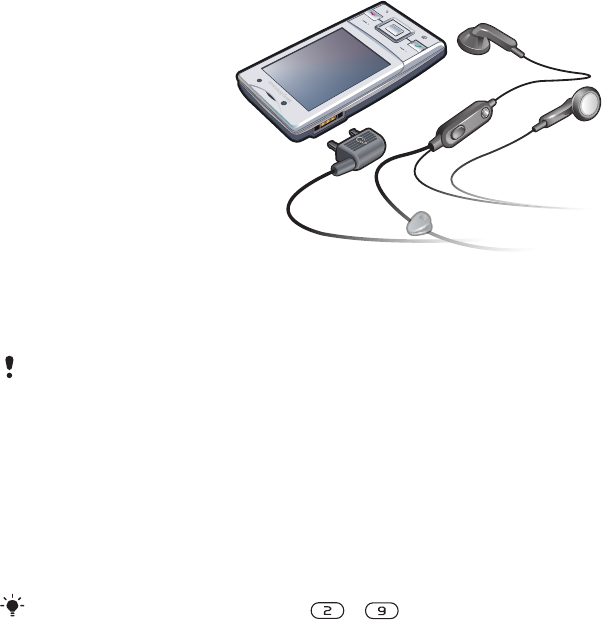
Music
You can listen to music, audio books and podcasts. Use the Media Go™ application to
transfer content to and from your phone. For more information, see Transferring content
to and from a computer on page 37.
Stereo portable handsfree
To use a handsfree
•Connect a portable handsfree. Music stops when you receive a call and resumes
when the call has ended.
If headphones are not included with the phone, you may purchase them separately.
Music player
To play music
1Select Menu > Media > Music.
2Browse by category using the navigation key.
3Scroll to a title and select Play.
Within a category, you can press – to go to entries beginning with a specific letter.
To stop playing music
•Press the centre selection key.
To fast forward and rewind
•Press and hold down the navigation key right or left.
To move between tracks
•Press the navigation key right or left.
To change the volume
•Press the volume keys up or down.
To minimise the music player
•Select Options > Minimise.
To return to the player
•Select Menu > Media.
Playlists
You can create playlists to organise your music. You can add tracks and folders to a playlist.
It may take a few minutes for the phone to create a playlist.
31
This is an Internet version of this publication. © Print only for private use.
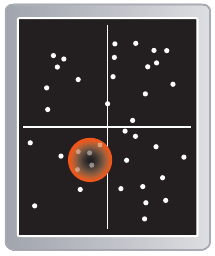
To create a playlist
1Select Menu > Media > Music > Playlists.
2Scroll to New playlist and select Add.
3Enter a name and select OK.
4For each track you want to add, scroll to the track and select Mark.
5Select Add to add the marked tracks to the playlist.
To add tracks to a playlist
1Select Menu > Media > Music > Playlists.
2Select a playlist.
3Scroll to Add music and select Add.
4For each track you want to add, scroll to the track and select Mark.
5Select Add to add the marked tracks to the playlist.
SensMe™ technology
With SensMe™ technology you can create playlists in two ways: by mood or from all the
tracks in your phone. To create playlists by mood, you first need to use the Media Go™
application to transfer tracks to your phone. Information such as mood, tempo and chords
is then added. The tracks are displayed as dots on a map with two axes. In the All view,
all the tracks in your phone are placed randomly on the map.
To create a playlist by mood
1Select Menu > Media > Music.
2Scroll to SensMe™ and select Open.
3Press the navigation key upwards, downwards, right or left.
4Make sure you are in Mood view. If you are not, select Mood.
5To preview different tracks, press the navigation key upwards, downwards, right or
left.
6To choose an area of tracks, select Add and press the navigation key upwards or
downwards.
7To create the playlist and play it in the music player, select Create.
8Select Options > Save playlist.
9Enter a name and select OK.
To create a playlist from the All view
1Select Menu > Media > Music.
2Scroll to SensMe™ and select Open.
3Press the navigation key upwards, downwards, right or left.
4Make sure you are in All view. If you are not, select All.
5To preview different tracks, press the navigation key upwards, downwards, right or
left.
6To choose an area of tracks, select Add and press the navigation key upwards or
downwards.
7To create the playlist for playing in the music player, select Create.
8Select Options > Save playlist.
9Enter a name and select OK.
32
This is an Internet version of this publication. © Print only for private use.

Audio books
If you use the Media Go™ application to transfer audio books to your phone from a
computer, you can listen to the audio books in your phone. It may take a few minutes before
a transferred audio book appears in the list of available audio books.
To access audio books
•Select Menu > Media > Music > Audio books.
You can find audio books in formats other than M4B and those that do not have ID3v2 chapter
tags in the Tracks folder.
Buy Now
If you subscribe to a music service allowing limited, non-permanent use with your phone,
you can mark a track you are interested in buying later. The next time you synchronise your
music with the Microsoft® Windows Media® Player application on a computer with enabled
Internet access, you should be asked if you want to buy the track you marked earlier. If you
accept, the track is downloaded to your computer and your selected music service account
is charged. This service requires a subscription and account with a downloadable music
service, a computer with the Microsoft® Windows Media® Player 11 application or
subsequent compatible version of the Microsoft® Windows Media® Player application, and
a USB computer connection.
You cannot see that a track is marked. You cannot unmark tracks you have already marked.
To mark a track
•When the track you want to mark is playing, press and hold down .
PlayNow™ application
When you open the PlayNow™ application, you enter PlayNow™, where you can
download music, games, ringtones, themes and wallpapers. You can preview or listen to
content before you purchase and download it to your phone. If you cannot use the
PlayNow™ application, see I cannot use Internet-based services on page 60.
This service is not available in all countries/regions.
For extended functionality, you can also access the PlayNow™ web shop on a computer
from www.sonyericsson.com/playnow. For more information, go to
www.sonyericsson.com/support to read the PlayNow™ Feature guide.
To use the PlayNow™ application
1Select Menu > PlayNow™.
2Scroll through PlayNow™ and follow the instructions to preview and purchase
content.
TrackID™ application
TrackID™ technology is a music recognition service. You can search for the title, artist and
album name of a track you hear playing through a loudspeaker or on the radio in your
phone. If you cannot use the TrackID™ application, see I cannot use Internet-based
services on page 60.
To search for track information
•When you hear a track playing through a loudspeaker, select Menu > Entertainment >
TrackID™ > Start.
•When you hear a track playing on your phone radio, select Options > TrackID™ >
TrackID™.
For best results, use TrackID™ in a quiet area.
33
This is an Internet version of this publication. © Print only for private use.

Online music and video clips
You can view video clips and listen to music by streaming them to your phone from the
Internet. If you cannot use the Internet, see I cannot use Internet-based services on
page 60.
To select a data account for streaming
1Select Menu > Settings > Connectivity > Streaming settings > Connect using:.
2Select the data account to use.
3Select Save.
To stream music and video clips
1Select Menu > Internet Service.
2Select and then select .
3Select a link to stream from.
Radio
Do not use your phone as a radio in places where this is prohibited.
To turn on the radio
1Connect a handsfree to the phone.
2Select Menu > Entertainment > Radio.
To search for channels automatically
•Select Search.
To fine tune the frequency
•Press the navigation key right or left.
To change the volume
•Press the volume keys up or down.
To minimise the radio
•Select Options > Minimise.
To return to the radio
•Select Menu > Entertainment > Radio.
Saving channels
You can save up to 20 preset channels.
To save channels automatically
•Select Options > Channels > Auto save.
To save channels manually
1When you find a radio channel, select Options > Channels > Save.
2Scroll to a position and select Insert.
3If you want, you can rename the channel. Select Save.
You can also save a channel in a position by pressing and holding down - .
To switch between saved channels
•Press the navigation key upwards or downwards.
You can also select a saved channel by pressing - .
34
This is an Internet version of this publication. © Print only for private use.

Recording sound
You can record a voice memo or a call. Recorded sounds can also be set as ringtones.
In some countries/regions or states, it is required by law that you inform the other person before
recording a call.
To record a sound
1Select Menu > Entertainment > Record sound > Record.
2To stop recording and save, select Save.
To record a call
1During an ongoing call, select Options > Record.
2To save the recording, select Save.
To listen to a recording
1Select Menu > Organiser > File manager.
2Scroll to Music and select Open.
3Scroll to a recording and select Play.
35
This is an Internet version of this publication. © Print only for private use.

Transferring and handling content
You can transfer and handle content such as pictures and music.
You are not allowed to exchange some copyright-protected material. identifies a protected
item.
Handling content in the phone
You can use File manager in your phone to handle content saved in the phone memory
or on a memory card. Tabs and icons in File manager show where the content is saved.
If the memory is full, delete some content to create space.
To view memory status
1Select Menu > Organiser > File manager.
2Select Options > Memory status.
3Select Memory card or Phone.
To select more than one item in a folder
1Select Menu > Organiser > File manager.
2Scroll to a folder and select Open.
3Select Options > Mark > Mark several.
4For each item you want to mark, scroll to the item and select Mark.
To move items between the phone memory and the memory card
1Select Menu > Organiser > File manager.
2Find an item and select Options > Manage file > Move.
3Select Memory card or Phone.
4Scroll to a folder and select Open.
5Select Paste.
To view information about content
1Select Menu > Organiser > File manager.
2Find an item and select Options > Information.
Sending content to another phone
You can send content using different transfer methods, for example, Messages or
Bluetooth wireless technology.
To send content
1Scroll to an item and select Options > Send.
2Select a transfer method.
Make sure the receiving device supports the transfer method you select.
Using a USB cable
You can connect your phone to a computer using a USB cable, wait until the computer
recognizes your phone. If you are using a computer running a Microsoft® Windows®
operating system and you have not already installed the necessary USB software, you are
asked to install PC Companion.
You may have to purchase a USB cable separately. Only use a USB cable supported by your
phone. Check that Autoplay functionality is enabled on your PC.
To disconnect the USB cable safely
Do not disconnect the USB cable when transferring content as this may corrupt the content.
36
This is an Internet version of this publication. © Print only for private use.

1Computer: Right-click the Safely Remove Hardware icon in the Microsoft®
Windows® Explorer application.
2Select the drives you want to disconnect. Select Stop.
3Wait until you are notified that it is safe to remove the drive. Disconnect the USB
cable.
PC Companion
PC Companion lets you:
•Explore content in your phone.
•Use your phone as a modem.
•Install PC software used to synchronise, transfer and back up phone content.
For more information, including Feature guides, go to www.sonyericsson.com/support.
To download Mac® compatible software, go to www.sonyericsson.com/support.
To install PC Companion
If the necessary USB software has not been installed on your PC, you need to install PC
Companion. Also, Autoplay functionality needs to be enabled on your PC.
1Using a USB cable supported by your phone, connect the phone to a computer that
runs a Microsoft® Windows® operating system.
2Computer: Follow the on-screen instructions.
Dragging and dropping content
You can drag and drop content between your phone, a memory card and a computer using
the Microsoft® Windows® Explorer application.
To drag and drop content
1Connect your phone to a computer using a USB cable supported by the phone.
2Computer: Wait until the phone memory and memory card appear as external disks
in the Microsoft® Windows® Explorer application.
3Drag and drop selected files between the phone and the computer.
Required operating systems
You need one of these operating systems to use Sony Ericsson PC software:
•Microsoft® Windows® 7
•Microsoft® Windows Vista™
•Microsoft® Windows® XP, Service Pack 2 or higher
Transferring content to and from a computer
You can use the Media Go™ application to transfer media content between your phone
and a computer. The Media Go™ application is available for download through PC
Companion or from www.sonyericsson.com/support.
Mac® compatible software is also available for download at www.sonyericsson.com/support.
To transfer content using Media Go™
1Connect your phone to a computer using a USB cable supported by your phone.
2Computer: When the Portable Device dialog box appears, select Transfer to or from
Device using Media Go and click OK. The Media Go™ application opens.
3Computer: Wait until your device appears in the Library navigation pane on the left
of the Media Go™ window. You can now select and transfer files between the phone
and computer.
4Move files between your phone and the computer using the Media Go™ application.
37
This is an Internet version of this publication. © Print only for private use.

Phone name
You can enter a name for your phone that is shown to other devices when using, for
example, Bluetooth™ wireless technology.
To enter a phone name
1Select Menu > Settings > Connectivity > Phone name.
2Enter the phone name and select OK.
Using Bluetooth™ wireless technology
Use Bluetooth™ technology to wirelessly connect to other devices, free of charge. You
can, for example:
•Connect to handsfree devices.
•Connect to several devices at the same time.
•Connect to computers and access the Internet.
•Exchange MP3 files, virtual business cards, photos, and more.
•Play multiplayer games.
A range of less than 10 metres (33 feet), with no solid objects in between, is recommended for
Bluetooth communication.
Before using Bluetooth™ wireless technology
You must turn on the Bluetooth™ function to communicate with other devices. You may
also have to pair your phone with other Bluetooth™ devices.
To turn on the Bluetooth™ function
•Select Menu > Settings > Connectivity > Bluetooth > Turn on.
Make sure the device you want to pair your phone with has the Bluetooth™ function activated
and is visible to other devices.
To pair the phone with another device
1Select Menu > Settings > Connectivity > Bluetooth > Add new device.
2Select a device.
3Enter a passcode, if required.
To allow connections to the phone
1Select Menu > Settings > Connectivity > Bluetooth.
2Select a device from the list.
3Select Options > Allow connection.
4Select Always ask or Always allow.
This is only possible with devices that require access to a secure service.
Power saving
You can save battery power with the Power save function. In Power save mode you can
only connect to a single Bluetooth device. If you want to connect to more than one
Bluetooth device at the same time, you must turn off this function.
To turn on Power save
•Select Menu > Settings > Connectivity > Bluetooth > Options > Power save >
On.
Transferring sound to and from a Bluetooth handsfree
You can transfer sound to and from a Bluetooth handsfree using the phone keypad or the
appropriate key on the handsfree.
38
This is an Internet version of this publication. © Print only for private use.

To transfer sound
1Select Menu > Settings > Connectivity > Bluetooth > Options > Incoming call.
2Select an option. In phone transfers sound to the phone. In handsfree transfers
sound to the handsfree.
If you select the option In phone and answer using the handsfree key, the sound transfers to the
handsfree.
To transfer sound during a call
1During a call, select Sound.
2Select from the list of available handsfree devices.
Backing up and restoring
You can back up and restore your contacts, calendar, tasks, notes and bookmarks using
the Sony Ericsson PC Suite, which is available through PC Companion or from
www.sonyericsson.com/support
.
You can also back up and restore contacts in your phone by moving content between the
memory card and the phone memory. See Handling content in the phone on page 36.
Back up your phone content regularly to make sure you do not lose it.
To make a backup using the Sony Ericsson PC Suite
1Computer: Start the Sony Ericsson PC Suite from Start/Programs/Sony Ericsson/
Sony Ericsson PC Suite.
2Follow the instructions in the Sony Ericsson PC Suite on how to connect.
3Go to the backup and restore section in the Sony Ericsson PC Suite and make a
backup of your phone content.
To restore phone content using the Sony Ericsson PC Suite
The Sony Ericsson PC Suite overwrites all phone content during the restore process. You may
damage your phone if you interrupt the process.
1Computer: Start the Sony Ericsson PC Suite from Start/Programs/Sony Ericsson/
Sony Ericsson PC Suite.
2Follow the instructions in the Sony Ericsson PC Suite on how to connect.
3Go to the backup and restore section in the Sony Ericsson PC Suite and restore
your phone content.
39
This is an Internet version of this publication. © Print only for private use.

Updating your phone
You can update your phone to the most recent software for optimal performance and to
get the latest enhancements. You need a USB cable and an Internet-connected PC.
To learn how, go to
www.sonyericsson.com/update
.
Remember to back up your phone content before updating. See Backing up and restoring on
page 39.
Updating your phone using Sony Ericsson PC Suite
You can update your phone using a USB cable and Sony Ericsson PC Suite. When the
phone is connected, it will automatically check for and notify you of new updates.
40
This is an Internet version of this publication. © Print only for private use.

Messaging
Text and picture messages
Messages can contain text, pictures, sound effects, animations, and melodies.
When sending messages, the phone automatically selects the most suitable method (as a
text or picture message) for sending the message.
If you cannot use picture messages, see I cannot use Internet-based services on
page 60.
Sending messages
You can send messages from your phone. The maximum size of a standard text message
is 160 characters (including spaces) if no other items are added to the message. If you
enter more than 160 characters, a second message is created. Your messages are sent
as one concatenated message.
To create and send a message
1Select Menu > Messaging > Write new > Message.
2Enter text. To add items to the message, press the navigation key downwards, scroll
by pressing the navigation key left or right, and select an item.
3Select Continue > Contacts look-up.
4Select a recipient and select Send.
If you send a message to a group, you may be charged for each member. Contact your service
provider for details.
To copy and paste text in a message
1When you write the message, select Options > Copy & paste.
2Select Copy all or Mark & copy. Scroll to and mark text in the message.
3Select Options > Copy & paste > Paste.
Receiving and saving messages
You are notified when you receive a message. or appears. Messages are
automatically saved in the phone memory. When the phone memory is full, you can delete
messages or save them on a memory card or on the SIM card.
To save an incoming message on a memory card
•Select Menu > Messaging > Messages > Settings > Save to > Memory card.
To save a message on the SIM card
1Select Menu > Messaging > Messages and select a folder.
2Scroll to a message and select Options > Save message.
To view a message in the inbox
1Select Menu > Messaging > Messages > Inbox.
2Scroll to the message and select View.
To call a number contained in a message
•When you view the message, scroll to the phone number and press .
Message options
You can set some options, such as the Message alert and default storage location, to apply
to all messages. You can set other options, such as the Delivery priority and Delivery time,
for each message you send.
41
This is an Internet version of this publication. © Print only for private use.

To set options for all messages
1Select Menu > Messaging > Messages > Settings.
2Select an option.
To set options for a specific message
1When the message is ready and a recipient is selected, select Options >
Advanced.
2Scroll to an option and select Edit.
Conversations
You can choose whether to view your messages in Conversations or the Inbox. A
messaging conversation shows all messaging communication between you and one of
your contacts.
To view messages in Conversations
•Select Menu > Messaging > Inbox > the Conversations tab.
•Select Menu > Messaging > Conversations and select a conversation.
To send a message from Conversations
1Select Menu > Messaging.
2Select Conversations, or select Inbox > the Conversations tab.
3Select a conversation.
4Write a message and select Send.
Voice messages
You can send and receive a sound recording as a voice message.
The sender and recipient must have a subscription supporting multimedia messaging.
To record and send a voice message
1Select Menu > Messaging > Write new > Voice message.
2Record the message and select Stop > Send > Contacts look-up.
3Select a recipient and select Send.
Email
You can get e-mail in your phone and use all standard e-mail functions.
You can synchronise your email using the Microsoft® Exchange ActiveSync® application.
Before using email
You can use the setup wizard to check if settings for your email account can be
automatically downloaded. If this does not work, you will be prompted to enter settings
manually.
To use email, you need the correct Internet settings in your phone. If you cannot use the Internet,
see I cannot use Internet-based services on page 60.
To create an email account for the first time
1To start the email setup wizard, select Menu > Messaging > Email.
2Follow the instructions to create the account.
If you need to enter settings manually, you can contact your email provider for more information.
An email provider could be the company that supplied your email address.
42
This is an Internet version of this publication. © Print only for private use.

To write and send an email message
1Select Menu > Messaging > Email.
2If you have several email accounts, select the account you want to send the message
from.
3Select Write new.
4To add a recipient, scroll to To: and select Add > Enter email address. Enter the
email address and select OK.
5To add more recipients, scroll to To: and select Edit. Scroll to an option and select
Add. When you are ready, select Done.
6To enter a subject, scroll to Subject:, select Edit, enter the subject, and select OK.
7To enter the message text, scroll to Text:, select Edit, enter the text, and select
OK.
8Select Add to attach a file.
9Select Continue > Send.
To receive and read an email message
1Select Menu > Messaging > Email.
2If you have several email accounts, select an account.
3Select Inbox > Options > Check new email.
4Scroll to the message and select View.
To save an email message
1Select Menu > Messaging > Email.
2If you have several email accounts, select an account.
3Select Inbox.
4Scroll to the message and select View > Options > Save message.
To reply to an email message
1Select Menu > Messaging > Email.
2If you have several email accounts, select an account.
3Select Inbox.
4Scroll to the message and select Options > Reply.
5Write the reply and select OK.
6Select Continue > Send.
To view an attachment in an email message
•When you view the message, select Options > Attachments > Use > View.
Active email account
If you have several email accounts, you can change which one is active.
To create additional email accounts
1Select Menu > Messaging > Email.
2If you have several email accounts, select an account.
3Select Accounts.
4Scroll to New account and select Add.
To change the active email account
1Select Menu > Messaging > Email.
2If you have several email accounts, select an account.
3Select Accounts.
4Select the account you want to activate.
Checking for new email messages automatically
You can set your phone to check for new email messages automatically. You can use a
time interval for the check, or you can let the phone stay connected to the email server
(push email). The phone will only check for email messages for the active email account.
When you receive a new email message, appears on the screen.
43
This is an Internet version of this publication. © Print only for private use.
To set the interval for checking for new email messages
1Select Menu > Messaging > Email.
2If you have several email accounts, select an account.
3Select Settings > the Download tab > Check interval.
4Select an option.
44
This is an Internet version of this publication. © Print only for private use.
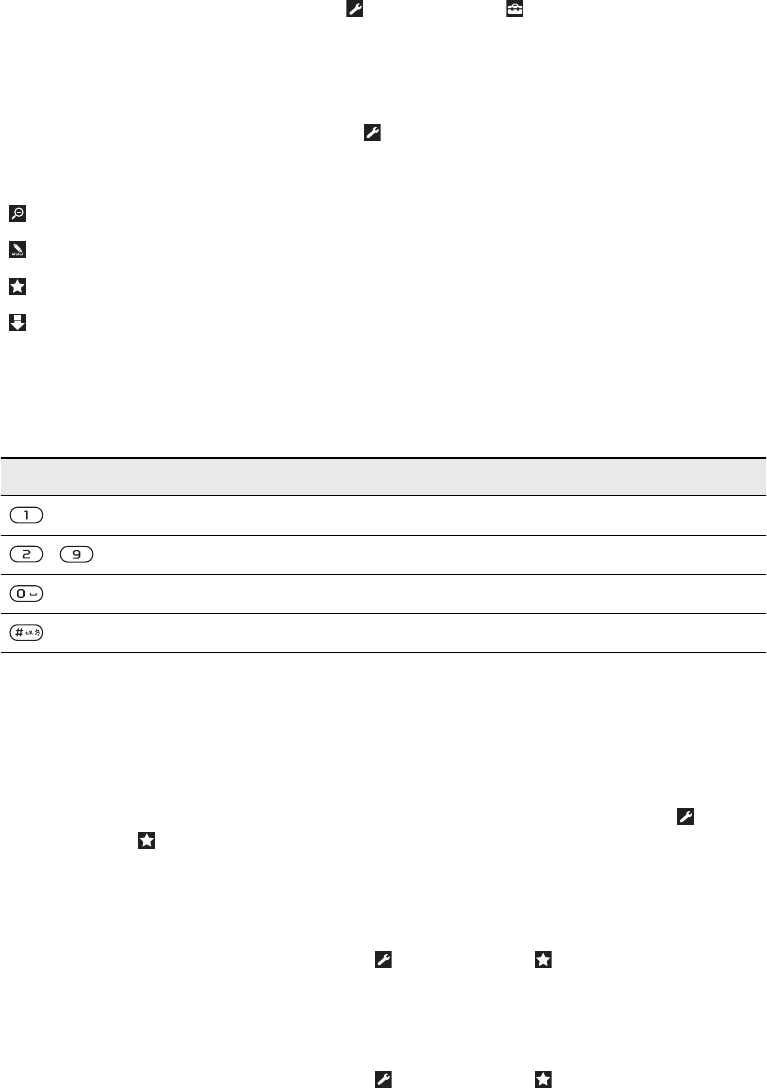
Internet
If you cannot use the Internet, see I cannot use Internet-based services on page 60.
To start browsing
1Select Menu > Internet.
2Enter a web address, a search phrase or the name of a bookmark.
3Scroll to an item in the list and select Go to or Search.
To exit the browser
1When you are browsing the web, select and then select .
2Select Exit browser.
To access the web browser toolbar
When you are viewing a web page, select . The following options appear:
Icon Function
Pan and zoom the web page
Search the web or enter a web address
Manage your favourite web pages
Manage the files you have downloaded from the Internet
Web browser shortcuts
You can use the keypad to go directly to a web browser function.
Key Shortcut
Bookmarks
- Enter text to enter an address, search the Internet or search in Bookmarks
Zoom
Overview (when Smart-Fit is off)
Bookmarks
You can create and edit bookmarks as quick links to your favourite web pages.
To create a bookmark
1When you are viewing a web page you want to add to your bookmarks, select
and then select .
2Select Add as bookmark.
To select a bookmark
1Select Menu > Internet Service.
2When you are browsing the Internet, select and then select .
3Scroll to a bookmark and select Go to.
To send a bookmark
1Select Menu > Internet Service.
2When you are browsing the Internet, select and then select .
3Scroll to a bookmark, then select Options.
4Select Send and select a transfer method.
45
This is an Internet version of this publication. © Print only for private use.

History pages
You can view and go to web pages you have previously visited.
To view history pages
1Select Menu > Internet Service.
2Select and then select .
3Select History.
More browser features
To turn on or off Smart-Fit Rendering™
1Select Menu > Internet Service.
2Select and then select .
3Select Settings > Smart-Fit.
4Select an option.
To use pan and zoom on a web page
1When you are viewing a web page, select and then select .
2Use the navigation key to move the frame.
3Press the centre selection key to zoom in on a part of the web page.
To use pan and zoom, Smart-Fit must be turned off.
To make a call when you are browsing the web
•Press .
To save a picture from a web page
1When you are viewing a web page, select and then select .
2Select Save picture.
3Select a picture.
To find text on a web page
1When viewing a web page, select and then select .
2Select Find on page.
3Enter text and select Find.
To send a link
1When you are viewing a web page, select and then select .
2Select Send link and select a transfer method.
Make sure the receiving device supports the transfer method you select.
Internet security and certificates
Your phone supports secure browsing. Certain Internet services, such as banking, require
certificates in your phone. Your phone may already contain certificates when you buy it or
you can download new certificates.
To view certificates in the phone
•Select Menu > Settings > General > Security > Certificates.
File transfers
The File transfer manager keeps track of the files you download from the Internet, for
example, media files, podcasts and games, and helps you access the files. It also tracks
your photo uploads to web sites, such as web albums and blogs. In the File transfer
manager you can also install downloaded Java applications, and to pause, resume or
cancel downloads.
46
This is an Internet version of this publication. © Print only for private use.

To access a file using File transfer
1Select Menu > Organiser > File transfer.
2Scroll to the file.
3Press the centre selection key to access the file, or select Options for other actions.
Web feeds
Using web feeds, you can subscribe to and download frequently updated content, such
as news, podcasts or photos.
To add new feeds from a web page
1When you browse a page on the Internet that provides web feeds, indicated by ,
select and then .
2For each feed you want to add, scroll to the feed and select Add > Yes.
3Select an update frequency.
To search for web feeds
1Select Menu > Media > Web feeds.
2Select New feed and enter a web address.
To download content via web feeds
1Select Menu > Media > Web feeds.
2Select Options >Update feed.
3Scroll to an updated feed and select View.
4Scroll to a heading by pressing the navigation key left or right.
5Scroll to the item you want to download by pressing the navigation key downwards,
then select Options > Download file.
You can access downloaded files from the File transfer manager. See File transfers on
page 46.
You can also subscribe to and download web feed content to a computer using the Media Go™
application. See To transfer content using Media Go™ on page 37.
Updating web feeds
You can manually update your feeds, or schedule updates. When updates arrive,
appears on the screen.
To schedule web feed updates
1Select Menu > Media > Web feeds.
2Scroll to a feed and select Options > Schedule update.
3Select an option.
Frequent updates may be costly.
Web feeds in standby
You can show news updates on the standby screen using the ticker application.
This application may not be available in all markets.
To show web feeds in standby
1Select Menu > Media > Web feeds.
2Scroll to a feed and select Options > Settings > Standby ticker > Show in
standby.
To access web feeds from standby
1From standby, select Ticker.
2To read more about a feed, press the navigation key upwards or downwards to scroll
to a headline, then select View.
47
This is an Internet version of this publication. © Print only for private use.
Podcasts
Podcasts are files, for example, radio programmes or video content, that you can download
and play. You subscribe to and download podcasts using web feeds.
To access audio podcasts
•Select Menu > Media > Music > Music feeds.
To access video podcasts
•Select Menu > Media > Video > Video feeds.
48
This is an Internet version of this publication. © Print only for private use.
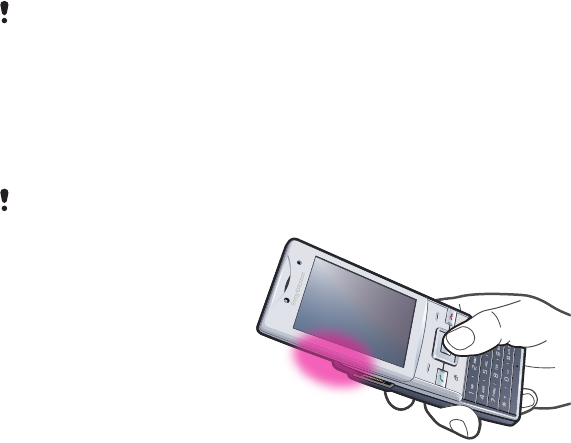
GPS
Your phone has a GPS receiver that uses satellite signals to calculate your location. Some
GPS features use the Internet. Data rates and charges may apply.
If you cannot use some GPS features, see I cannot use Internet-based services on page 60.
Using GPS
Your location can be found when you have a clear view of the sky. If your location is not
found after a few minutes, move to another location. To help the search, stand still and do
not cover the GPS antenna.
The first time you use the GPS it may take up to 10 minutes before your location is found.
Saving locations
You can find all saved locations in My favourites.
To save your current location
1Select Menu > Location services > My favourites > Add new place.
2Select Edit and enter the title. Select OK.
3Scroll to Description: and select Add.
4Enter the description and select OK.
5Scroll to Position: and select Add > Current position.
6When the position is found, select Save.
To view a saved location on a map
1Select Menu > Location services > My favourites.
2Scroll to a location and select Go to.
Location requests
External services may ask for your location. You can allow external services to use
information about your location, as well as restrict them from doing so.
To change access for external services
1Select Menu > Location services > Settings > Privacy.
2Select an option.
Turning off GPS
The GPS receiver turns off automatically when it is not in use. You can also turn the GPS
receiver off manually. This saves battery power when you use features that do not require
the GPS receiver to find your location.
To turn on or off GPS manually
1Select Menu > Location services > Settings.
2Select Enable GPS or Disable GPS.
49
This is an Internet version of this publication. © Print only for private use.

Tracker
Tracker is a GPS-based sports application which allows you to keep track of your speed,
distance, route and energy consumption during training. You can base the training on how
long time you want to train or on what distance you want to cover. You can also base it on
a previous training route which has GPS data.
Information provided by use of the Tracker application is approximate. Sony Ericsson makes no
warranty of any kind with respect to the accuracy of the Tracker application. Any serious health
and fitness concerns should be referred to a health care professional.
To start a training session
1Select Menu > Location services > Tracker > Start training.
2Select a training type.
3Scroll to an item, select Edit and enter the data.
4To save, select Done.
5To start training, select Start.
To switch between training views
•During a training session, press the navigation key left or right to view information on
training duration, progress and live comparison with a previous session.
To compare results during training
1Select Menu > Location services > Tracker > Start training.
2Select Route based.
3Scroll to Route:, select Edit and select a route.
4Scroll to Live compare and select Edit.
5Scroll to the result you want to compare and select Compare.
6Select Done and then Start.
A GPS location is required before results can be compared.
To end a training session manually
•During a training session, select Pause > End.
Results
The training result is shown after a session is ended. You can view past results anytime,
and compare them if they have GPS data.
To view a training result
1Select Menu > Location services > Tracker > Results.
2Scroll to a month and select View.
3Scroll to a date and select View.
4Select a training result. If you have used laps, press the navigation key left or right
to view result per lap.
To compare results
1Select Menu > Location services > Tracker > Results.
2Scroll to a result and select Options > Compare.
3Select a result to compare with.
A GPS location is required before results can be compared.
Energy consumption
To calculate and view the energy consumption for a session you must first set your personal
profile in Settings in Tracker. You view the energy consumption in the result view.
To set the personal profile
1Select Menu > Location services > Tracker > Settings > Personal profile.
2Select an item, enter data and select OK.
3When finished, select Options > Save profile.
50
This is an Internet version of this publication. © Print only for private use.
To turn on energy consumption
•Select Menu > Location services > Tracker > Settings > Energy consumption
> On.
51
This is an Internet version of this publication. © Print only for private use.

Synchronising
You can synchronise your phone in two different ways: using a computer program, or using
an Internet service.
Use only one of the synchronisation methods at a time with your phone.
For more information, go to www.sonyericsson.com/support to read the Synchronisation
Feature guide.
Synchronising using a computer
You can use a USB cable or Bluetooth wireless technology to synchronise phone contacts,
appointments, bookmarks, tasks and notes using an online service or a computer program
such as the Microsoft® Outlook® application.
Before synchronising, you need to install the Sony Ericsson PC Suite. Sony Ericsson PC
Suite software is available for download through PC Companion or from
www.sonyericsson.com/support
.
Mac® compatible software is also available for download at
www.sonyericsson.com/support
.
To synchronise using the Sony Ericsson PC Suite
1Computer: Start Sony Ericsson PC Suite from Start/Programs/Sony Ericsson/
Sony Ericsson PC Suite.
2Follow the instructions in the Sony Ericsson PC Suite for how to connect.
3When you are notified that the Sony Ericsson PC Suite has found your phone, you
can start synchronising.
For usage details, see the Sony Ericsson PC Suite Help section once the software has been
installed on your computer.
Synchronising using an Internet service
You can synchronise your phone data through an Internet service using SyncML™, or you
can use a Microsoft® Windows® Server in combination with the Microsoft® Exchange
ActiveSync® application. For more information, go to www.sonyericsson.com/support to
read the Synchronisation Feature guide.
52
This is an Internet version of this publication. © Print only for private use.

More features
Flight mode
In Flight mode the network and radio transceivers are turned off to prevent disturbance to
sensitive equipment.
When the flight mode menu is activated you are asked to select a mode the next time you
turn on your phone:
•Normal mode – full functionality
•Flight mode – limited functionality
To activate the flight mode menu
•Select Menu > Settings > General > Flight mode > Continue > Show at
startup.
To select flight mode
1When the flight mode menu is activated, turn off your phone.
2Turn on your phone and select Flight mode. appears.
Alarms
You can set a sound or the radio as an alarm signal. The alarm sounds even if the phone
is turned off. When the alarm sounds, you can silence it or turn it off.
To set the alarm
1Select Menu > Organiser > Alarms.
2Scroll to an alarm and select Edit.
3Scroll to Time: and select Edit.
4Enter a time and select OK > Save.
To set the recurrent alarm
1Select Menu > Organiser > Alarms.
2Scroll to an alarm and select Edit.
3Scroll to Recurrent: and select Edit.
4Scroll to a day and select Mark.
5To select another day, scroll to the day and select Mark.
6Select Done > Save.
To set the alarm signal
1Select Menu > Organiser > Alarms.
2Scroll to an alarm and select Edit.
3Scroll to the tab.
4Scroll to Alarm signal: and select Edit.
5Find and select an alarm signal. Select Save.
To silence the alarm
•When the alarm sounds, press any key.
•To repeat the alarm, select Snooze.
To turn off the alarm
•When the alarm sounds, press any key, then select Turn off.
To cancel the alarm
1Select Menu > Organiser > Alarms.
2Scroll to an alarm and select Turn off.
53
This is an Internet version of this publication. © Print only for private use.

To set the snooze duration
1Select Menu > Organiser > Alarms.
2Scroll to an alarm and select Edit.
3Scroll to Snooze duration: and select Edit.
4Select an option.
The alarm in silent mode
You can set the alarm not to sound when the phone is in silent mode.
To set an alarm to sound or not in silent mode
1Select Menu > Organiser > Alarms.
2Scroll to an alarm and select Edit.
3Scroll to the tab.
4Scroll to Silent mode: and select Edit.
5Select an option.
Calendar
You can synchronise your phone calendar with a computer calendar, with a calendar on
the web or with the Microsoft® Outlook® application.
Appointments
You can add new appointments or reuse existing appointments.
To add an appointment
1Select Menu > Calendar.
2Select a date.
3Scroll to New entry and select Add.
4Enter the information and confirm each entry.
5Select Save.
To view an appointment
1Select Menu > Calendar.
2Select a date.
3Scroll to an appointment and select View.
To edit an appointment
1Select Menu > Calendar.
2Select a date.
3Scroll to an appointment and select View.
4Select Options > Edit.
5Edit the appointment and confirm each entry.
6Select Save.
To set when reminders should sound
1Select Menu > Calendar.
2Select a date.
3Select Options > Advanced > Reminders.
4Select an option.
A reminders option set in the Calendar application affects a reminders option set in Tasks.
Notes
You can make notes and save them. You can also show a note in the standby view.
54
This is an Internet version of this publication. © Print only for private use.

To add a note
1Select Menu > Organiser > Notes.
2Scroll to New note and select Add.
3Write a note and select Save.
To show a note in standby
1Select Menu > Organiser > Notes.
2Scroll to a note and select Options > Show in standby.
To hide a note shown in standby
1Select Menu > Organiser > Notes.
2Scroll to the note shown in standby. This is marked with the icon . Select Options >
Hide in standby.
Tasks
You can add new tasks or reuse existing tasks.
To add a task
1Select Menu > Organiser > Tasks.
2Select New task and select Add.
3Select an option.
4Enter details and confirm each entry.
To set when reminders should sound
1Select Menu > Organiser > Tasks.
2Scroll to a task and select Options > Reminders.
3Select an option.
A reminders option set in Tasks affects a reminders option set in Calendar.
Profiles
You can change settings such as the ring volume and vibrating alert to suit different
locations. You can reset all profiles to the phone’s original settings.
To select a profile
1Select Menu > Settings > General > Profiles.
2Select a profile.
To view and edit a profile
1Select Menu > Settings > General > Profiles.
2Scroll to a profile and select Options > View and edit.
You cannot rename the Normal profile.
Time and date
To set the time
1Select Menu > Settings > General > Time & date > Time.
2Enter the time and select Save.
To set the date
1Select Menu > Settings > General > Time & date > Date.
2Enter the date and select Save.
55
This is an Internet version of this publication. © Print only for private use.

To set the time zone
1Select Menu > Settings > General > Time & date > My time zone.
2Select the time zone you are in.
If you select a city, My time zone also updates the time when daylight saving time changes.
To change the clock size displayed on the standby screen
1Select Menu > Settings > Display > Clock size.
2Select an option.
This application may not be available in all markets.
Themes
You can change the appearance of the screen using options such as different colours and
wallpaper. You can also create new themes and download them. For more information, go
to www.sonyericsson.com/fun.
To set a theme
1Select Menu > Settings > Display > Theme.
2Scroll to a theme and select Set.
Main menu layout
You can change the layout of the icons in the main menu.
To change the main menu layout
1Select Menu > Options > Main menu layout.
2Select an option.
Screen orientation
You can change between landscape and portrait orientation.
To change screen orientation in the browser
1Select Menu > Internet Service.
2Select and then select .
3Select Settings > the Browsing tab > Display orientation.
4Select an option.
To change screen orientation in Media
1Select Menu > Media > Settings > Orientation.
2Select an option.
Ringtones
To set a ringtone
1Select Menu > Settings > Sounds & alerts > Ringtone.
2Find and select a ringtone.
To set the ringtone volume
1Select Menu > Settings > Sounds & alerts > Ring volume.
2Press the navigation key left or right to adjust the volume.
3Select Save.
56
This is an Internet version of this publication. © Print only for private use.

To turn off the ringtone
•Press and hold down . appears.
The alarm signal is not affected.
To set the vibrating alert
1Select Menu > Settings > Sounds & alerts > Vibrating alert.
2Select an option.
Games
Your phone contains preloaded games. You can also download games. For more
information, go to www.sonyericsson.com/fun. Help texts are available for most games.
To start a game
1Select Menu > Media > Games.
2Select a game.
To end a game
•Press .
Applications
You can download and run Java™ applications. You can also view information or set
different permissions. If you cannot use Java applications, see I cannot use Internet-based
services on page 60.
To select a Java application
1Select Menu > Organiser > Applications.
2Select an application.
To set permissions for a Java application
1Select Menu > Organiser > Applications.
2Scroll to an application and select Options > Permissions.
3Set permissions.
Java application screen size
Some Java applications are designed for a specific screen size. For more information,
contact the application vendor.
This application may not be available in all markets.
To set the screen size for a Java application
1Select Menu > Organiser > Applications.
2Scroll to an application and select Options > Screen size.
3Select an option.
To set a Java™ application as a wallpaper
1Select Menu > Settings > Display.
2Select Wallpaper > Application.
3Select a Java application.
You can only see the Java applications that have support for wallpaper.
Antivirus
Antivirus identifies and removes applications you install on your phone that become infected
by viruses. It automatically scans applications during installation. When an infected
application is detected, you can delete or release the infected application. You can select
57
This is an Internet version of this publication. © Print only for private use.

a 30-day free evaluation or enter a subscription number. We recommend that you update
the antivirus application with the latest virus protection frequently. You need the correct
Internet settings in your phone to use this function.
Our inclusion or your use of antivirus software does not ensure that your use of this product will
be free from exposure to viruses, malware or other harmful software.
To turn on Antivirus scanning
1Select Menu > Settings > General > Security > Antivirus.
2Follow the instructions to use the setup wizard.
To turn off Antivirus scanning
1Select Menu > Settings > General > Security > Antivirus > Virus scan.
2Select Off.
PIN codes
SIM protection
This lock only protects your subscription. Your phone will work with a new SIM card. If the
lock is on, you have to enter a PIN (Personal Identity Number).
If you enter your PIN incorrectly three times in a row, the SIM card is blocked and you need
to enter your PUK (Personal Unblocking Key). Your PIN and PUK are supplied by your
network operator.
To unblock the SIM card
1When PIN blocked appears, enter your PUK and select OK.
2Enter a new four-to-eight-digit PIN and select OK.
3Re-enter the new PIN and select OK.
To edit the PIN
1Select Menu > Settings > General > PIN codes > SIM protection > Change
PIN.
2Enter your PIN and select OK.
3Enter a new four-to-eight-digit PIN and select OK.
4Re-enter the new PIN and select OK.
If Codes do not match appears, you entered the new PIN incorrectly. If Incorrect PIN appears,
you entered the old PIN incorrectly.
To use the SIM card lock
1Select Menu > Settings > General > PIN codes > SIM protection > Protection.
2Select an option.
3Enter your PIN and select OK.
Phone protection
You can stop unauthorised use of your phone by activating phone lock protection. After
activating, you will be asked to enter your phone lock code every time you restart the phone.
The default phone lock code is 0000. It is recommended that you change this to any four-
to-eight-digit personal code.
It is important that you remember your new code. If you forget it, you need to take your phone
to your local Sony Ericsson retailer.
58
This is an Internet version of this publication. © Print only for private use.

To activate the phone lock
1Select Menu > Settings > General > PIN codes > Phone protection >
Protection.
2Select On if you want to enter a lock code every time you start the phone, or select
Automatic if you want the code to be entered only when the phone restarts after a
new SIM card is inserted.
3Enter the phone lock code (0000 by default) and select OK.
To unlock the phone
•When Phone locked appears, enter your phone lock code and select OK.
To change the phone lock code
1Select Menu > Settings > General > PIN codes > Phone protection > Change
code.
2Enter the old code and select OK.
3Enter the new code and select OK.
4Repeat the code and select OK.
Keypad lock
You can set the keypad lock to avoid accidental dialling. appears. Incoming calls can
be answered without unlocking the keypad.
Calls to the international emergency number 112 can still be made.
To use the automatic keylock
1Select Menu > Settings > General > Automatic keylock.
2Select an option.
To unlock the keypad manually
•Press any key and select Unlock > OK.
IMEI number
To view your IMEI number
•Press , , , , .
59
This is an Internet version of this publication. © Print only for private use.
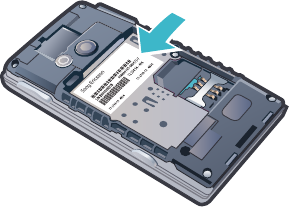
Troubleshooting
Some problems can be fixed using Update Service. Using Update Service on a regular
basis will optimise the phone’s performance. See Updating your phone on page 40.
Some problems will require you to call your network operator.
For more support go to www.sonyericsson.com/support.
Common questions
Where can I find the regulatory information such as my IMEI number if
I cannot turn on my phone?
I have problems with memory capacity or the phone is working slowly
Restart your phone every day to free memory or do a Master reset.
Master reset
If you select Reset settings, the changes that you have made to settings will be deleted.
If you select Reset all, your settings and content, such as contacts, messages, pictures,
sounds and downloaded games, will be deleted. You may also lose content that was in the
phone at purchase.
To reset the phone
1Select Menu > Settings > General > Master reset.
2Select an option.
3Follow the instructions that appear.
I cannot charge the phone or battery capacity is low
The charger is not properly connected or the battery connection is poor. Remove the
battery and clean the connectors.
The battery is worn out and needs to be replaced. See Charging the battery on page 8.
No battery icon appears when I start charging the phone
It may take a few minutes before the battery icon appears on the screen.
Some menu options appear in grey
A service is not activated. Contact your network operator.
I cannot use Internet-based services
Your subscription does not include data capability. Settings are missing or incorrect.
You can download settings using the Settings download or from
www.sonyericsson.com/support.
You can download settings from www.sonyericsson.com/support.
60
This is an Internet version of this publication. © Print only for private use.
I cannot send messages from my phone
To send messages, you need to set a service centre number. The number is supplied by
your service provider and is usually saved on the SIM card. If the number of your service
centre is not saved on your SIM card, you must enter the number yourself.
To send most picture messages, you must set an MMS (Multimedia Messaging Service)
profile and the address of your message server. If no MMS profile or message server exists,
you can receive all the settings automatically from your network operator by going to
www.sonyericsson.com/support.
To enter a service centre number
1Select Menu > Settings > Connectivity > Message settings > Text message and
scroll to Service centre. The number is shown if it is saved on the SIM card.
2If there is no number shown, select Edit.
3Scroll to New service centre and select Add.
4Enter the number, including the international “+” sign and country code.
5Select Save.
To select an MMS profile
1Select Menu > Settings > Connectivity > Message settings > Multim.
message.
2Select an existing profile or create a new one.
To set the message server address
1Select Menu > Settings > Connectivity > Message settings > Multim.
message.
2Scroll to a profile and select Options > Edit.
3Scroll to Message server and select Edit.
4Enter the address and select OK > Save.
The phone does not ring or rings too softly
Make sure that Silent mode has not been set to On. See To turn off the ringtone on
page 57.
Check the ringtone volume. See To set the ringtone volume on page 56.
Check the profile. See To select a profile on page 55.
Check the divert call options. See To divert calls on page 22.
The phone cannot be detected by other devices using Bluetooth
wireless technology
You have not turned the Bluetooth function on. Make sure that the visibility is set to Show
phone. See To turn on the Bluetooth™ function on page 38.
I cannot synchronise or transfer content between my phone and the
computer, when using a USB cable.
The software or the USB drivers have not been properly installed. Go to
www.sonyericsson.com/support to read Feature guides which contain detailed installation
instructions and troubleshooting sections.
How do I use my new Sony Ericsson mobile phone to upload photos to
photo.blog.sina.com?
First, make sure that you have registered for an account on photo.blog.sina.com. Then you
have to link up your mobile phone number with photo.blog.sina.com to be able to use this
function. Follow these steps to link up:
61
This is an Internet version of this publication. © Print only for private use.
1On your computer, register and log in at photo.blog.sina.com, and then click on the
Upload Photos button. Click on the Link up your mobile phone for free link in the
upload page.
2Enter your mobile phone number in the upload page, and then click the Save button.
Now your mobile phone number is linked up with photo.blog.sina.com!
3Use your mobile phone to edit a multimedia message and send it to
1066888817102. This picture will appear in your default album on
photo.blog.sina.com. The title and text of the multimedia message will become the
title and description of the photo on photo.blog.sina.com. (Sina.com does not
charge anything for you to send photos from your cell phone to photo.blog.sina.com,
but local telecom operators will charge transmission fees according to their own
policies.)
Follow these steps when you want to cancel the link or if you need to change the number
of the linked-up mobile phone:
1. Log in to photo.blog.sina.com and click on the Upload Photos button. Click on the
Cancel link to mobile phone link in the upload page.
2. Click the OK button, and the link between your mobile phone number and
photo.blog.sina.com will be canceled.
SMS/MMS Blogging Services Activation Instructions for blog.163.com
Please first log in to the 163.com SMS/MMS blogging services page to start the activation
process:
1Register/log in at 163.com, then go to the SMS blogging services page (http://blog.
163.com/services/emsblog.html?fromservices), and click Free Activation of SMS
Blogging.
2Enter your account number, password, and mobile phone number, and then click
Next.
3After clicking Get Activation Code For Free, you will receive a six-digit activation
code via SMS; enter this code in the box provided and click Next.
4When you see the Phone Activation Complete page, then your cell phone has been
successfully activated for SMS/MMS blogging services, and you can start blogging
right away.
About the fees:
1. There is no monthly service charge for SMS/MMS blogging; 163.com does not charge
any fees.
2. Telecom charges are the same as those for SMS/MMS messages sent to other phones,
and are determined by your telecom provider (China Mobile or China Unicom).
There is no charge for undelivered messages; incoming messages are free.
Error messages
Insert SIM
There is no SIM card in your phone or you may have inserted it incorrectly.
See To insert the SIM card on page 6.
The SIM card connectors need cleaning. If the card is damaged, contact your network
operator.
Insert correct SIM card
Your phone is set to work only with certain SIM cards. Check if you are using the correct
operator SIM card.
Incorrect PIN/Incorrect PIN2
You have entered your PIN or PIN2 incorrectly.
Enter the correct PIN or PIN2 and select OK.
62
This is an Internet version of this publication. © Print only for private use.
PIN blocked/PIN2 blocked
You have entered your PIN or PIN2 code incorrectly three times in a row.
To unblock, see SIM protection on page 58.
Codes do not match
Codes that you have entered do not match. When you want to change a security code, for
example your PIN, you have to confirm the new code. See SIM protection on page 58.
No netw. coverage
•Your phone is in flight mode. See Flight mode on page 53.
•Your phone is not receiving any network signal, or the received signal is too weak. Contact
your network operator and make sure that the network has coverage where you are.
•The SIM card is not working properly. Insert your SIM card in another phone. If this works,
it is probably your phone that is causing the problem. Please contact the nearest
Sony Ericsson service location.
PUK blocked. Contact operator.
You have entered your personal unblocking key code (PUK) incorrectly 10 times in a row.
63
This is an Internet version of this publication. © Print only for private use.
Legal information
Sony Ericsson J20
This User guide is published by Sony Ericsson Mobile Communications AB or its local affiliated company, without any
warranty. Improvements and changes to this User guide necessitated by typographical errors, inaccuracies of current
information, or improvements to programs and/or equipment, may be made by Sony Ericsson Mobile Communications
AB at any time and without notice. Such changes will, however, be incorporated into new editions of this User guide.
All rights reserved.
©Sony Ericsson Mobile Communications AB, 2010
Publication number: 1235-4763.1
Your mobile phone has the capability to download, store and forward additional content, e.g. ringtones. The use of
such content may be restricted or prohibited by rights of third parties, including but not limited to restriction under
applicable copyright laws. You, and not Sony Ericsson, are entirely responsible for additional content that you
download to or forward from your mobile phone. Prior to your use of any additional content, please verify that your
intended use is properly licensed or is otherwise authorized. Sony Ericsson does not guarantee the accuracy, integrity
or quality of any additional content or any other third party content. Under no circumstances will Sony Ericsson be
liable in any way for your improper use of additional content or other third party content.
This User Guide may reference services or applications provided by third parties. Use of such programming or services
may require separate registration with the third party provider and may be subject to additional terms of use. For
applications accessed on or through a third-party website, please review such website’s terms of use and applicable
privacy policy in advance. Sony Ericsson does not warrant or guaranty the availability or performance of any third-
party websites or offered services.
Smart-Fit Rendering is a trademark or a registered trademark of ACCESS Co., Ltd.
Bluetooth is a trademark or a registered trademark of Bluetooth SIG Inc. and any use of such mark by
Sony Ericsson is under license.
The Liquid Identity logo, Hazel , PlayNow and TrackID are trademarks or registered trademarks of Sony Ericsson
Mobile Communications AB.
TrackID™ is powered by Gracenote Mobile MusicID™. Gracenote and Gracenote Mobile MusicID are trademarks or
registered trademarks of Gracenote, Inc.
Sony and "make.believe" are trademarks or registered trademarks of Sony Corporation.
Media Go is a trademark or registered trademark of Sony Media Software and Services.
microSD is a trademark or a registered trademark of SanDisk Corporation.
PictBridge is a trademark or registered trademark of Canon Kabushiki Kaisha Corporation.
Google Maps™ is a trademark or registered trademark of Google, Inc.
Lotus Notes is a trademark or a registered trademark of International Business Machines Corporation.
SyncML is a trademark or registered trademark of Open Mobile Alliance LTD.
Ericsson is a trademark or registered trademark of Telefonaktiebolaget LM Ericsson.
Mac is a trademark of Apple Computer, Inc., registered in the U.S. and other countries.
Adobe Photoshop Album Starter Edition is a trademark or registered trademark of Adobe Systems Incorporated in
the United States and/or other countries/regions.
Microsoft, Windows, Outlook, Windows Vista, Windows Server and ActiveSync are registered trademarks or
trademarks of Microsoft Corporation in the United States and/or other countries/regions.
This product is protected by certain intellectual property rights of Microsoft. Use or distribution of such technology
outside of this product is prohibited without a license from Microsoft.
Content owners use Windows Media digital rights management technology (WMDRM) to protect their intellectual
property, including copyrights. This device uses WMDRM software to access WMDRM-protected content. If the
WMDRM software fails to protect the content, content owners may ask Microsoft to revoke the software's ability to
use WMDRM to play or copy protected content. Revocation does not affect unprotected content. When you download
licenses for protected content, you agree that Microsoft may include a revocation list with the licenses. Content owners
may require you to upgrade WMDRM to access their content. If you decline an upgrade, you will not be able to access
content that requires the upgrade.
This product is licensed under the MPEG-4 visual and AVC patent portfolio licenses for the personal and non-
commercial use of a consumer for (i) encoding video in compliance with the MPEG-4 visual standard ("MPEG-4 video")
or the AVC standard ("AVC video") and/or (ii) decoding MPEG- 4 or AVC video that was encoded by a consumer
engaged in a personal and non-commercial activity and/or was obtained from a video provider licensed by MPEG LA
to provide MPEG-4 and/or AVC video. No license is granted or shall be implied for any other use. Additional information
including that relating to promotional, internal and commercial uses and licensing may be obtained from MPEG LA,
L.L.C. See http://www.mpegla.com. MPEG Layer-3 audio decoding technology licensed from Fraunhofer IIS and
Thomson.
Java, JavaScript and Java-based trademarks and logos are trademarks or registered trademarks of Sun
Microsystems, Inc. in the U.S. and other countries/regions.
End-user license agreement for Sun Java Platform, Micro Edition.
1. Restrictions: Software is confidential copyrighted information of Sun and title to all copies is retained by Sun and/
or its licensors. Customer shall not modify, decompile, disassemble, decrypt, extract, or otherwise reverse engineer
Software. Software may not be leased, assigned, or sublicensed, in whole or in part.
2. Export Regulations: This product, including any software or technical data contained in or accompanying the
product, may be subject to import and export regulations of the European Union, the United States and other
countries/regions. The user and any possessor of the product agrees to comply strictly with all such regulations and
acknowledges that it is their responsibility to obtain any required licenses to export, re-export, or import this product.
Without limiting the foregoing, and as an example, the user and any possessor of the product: (1) must not knowingly
export or re-export Products to destinations identified pursuant to Articles in Chapter II of European Council Regulation
(EC) 1334/2000; (2), must comply with U.S. government Export Administration Regulations ("EAR", 15 C.F.R. §§
730-774, http://www.bis.doc.gov/ ) administered by Department of Commerce, Bureau of Industry and Security; and
(3) must comply with economic sanctions regulations (30 C.F.R. §§ 500 et. seq.,., http://www.treas.gov/offices/
enforcement/ofac/) administered by the U.S. Department of Treasury, Office of Foreign Assets Control. The user and
any possessor of the product may not transport or deliver the product, its accessories or separate software to any
country, region, entity or person prohibited by these regulations..
Restricted Rights: Use, duplication or disclosure by the United States government is subject to the restrictions as set
forth in the Rights in Technical Data and Computer Software Clauses in DFARS 252.227-7013(c) (1) (ii) and FAR
52.227-19(c) (2) as applicable.
Includes "protobuf-c", http://code.google.com/p/protobuf-c/.
Copyright 2008, Dave Benson.
Licensed under the Apache License, Version 2.0 (the "License"); you may not use this file except in compliance with
the License. You may obtain a copy of the License at http://www.apache.org/licenses/LICENSE-2.0.
Unless required by applicable law or agreed to in writing, software distributed under the License is distributed on an
“AS IS” BASIS, WITHOUT WARRANTIES OR CONDITIONS OF ANY KIND, either express or implied. See the License
for the specific language governing permissions and limitations under the License.
Other product and company names mentioned herein may be the trademarks of their respective owners.
Any rights not expressly granted herein are reserved.
Note: Sony Ericsson advises users to backup their personal data information.
All illustrations are for illustration only and may not accurately depict the actual phone.
64
This is an Internet version of this publication. © Print only for private use.
SMS Registration: In order to provide faster and better quality after-sale services, an SMS will be sent automatically
by the phone (The SMS expense is upon the mobile fee bill from the operator) to the server of Sony Ericsson Mobile
Communications (China) Co., Ltd. once the phone is in use. The relevant information of the SMS will be stored and
used for after-sales service management by Sony Ericsson.
To use some pre-loaded applications (e.g. TrackID, MSN) you need first activate data service. Using data services
(GPRS or 3G services) may incur data traffic fee. Please contact your network operator for expense details.
Please visit www.sonyericsson.com/cn to get the latest version of this User's Guide.
65
This is an Internet version of this publication. © Print only for private use.
Index
A
activity menu ...........................................................13
alarms ......................................................................53
answering service ....................................................21
antivirus ...................................................................57
applications .............................................................57
appointment ............................................................54
audio book ..............................................................33
automatic email checking .......................................43
B
background music ...................................................17
backing up and restoring ........................................39
battery
capacity .............................................................8
charging ............................................................9
inserting .............................................................7
blog .........................................................................29
Bluetooth™ wireless technology .............................38
bookmarks ...............................................................45
business card ..........................................................21
C
calendar ...................................................................54
call divert .................................................................22
call list ......................................................................18
call numbers in message .........................................41
call time ...................................................................24
caller-specific ringtones ..........................................20
calls
accepting .........................................................24
answering and rejecting ..................................17
emergency .......................................................18
putting on hold ................................................23
recording .........................................................35
video ................................................................18
camera .....................................................................25
printing ............................................................28
clip ...........................................................................29
conference calls ......................................................23
contacts
adding phone contacts ...................................19
default contacts ...............................................19
groups .............................................................21
smart search ....................................................19
conversations ..........................................................42
costs ..........................................................................8
D
date .........................................................................55
download
files ..................................................................46
music ...............................................................33
E
email ........................................................................42
emergency numbers ................................................18
F
face detection ..........................................................26
file manager .............................................................36
file transfers .............................................................46
flight mode ..............................................................53
G
games ......................................................................57
geo tagging .............................................................28
GPS .........................................................................49
groups .....................................................................21
H
handsfree ...........................................................22, 31
help ............................................................................8
hiding your phone number ......................................24
I
imaging ....................................................................25
IMEI number ............................................................59
Internet ....................................................................46
bookmarks ......................................................45
screen orientation ............................................56
security and certificates ..................................46
settings ............................................................60
K
keypad lock .............................................................59
keys ...........................................................................6
L
language ..................................................................14
location services ......................................................49
lock
keypad .............................................................59
SIM card ..........................................................58
M
master reset ............................................................60
Media Go™ .............................................................37
media transfer .........................................................37
memory ...................................................................13
memory card ...........................................................13
memory status .........................................................20
menu overview ........................................................11
messages
email ................................................................42
picture .............................................................41
text ..................................................................41
voice ................................................................42
microphone .............................................................17
MMS See picture messages
model name ...............................................................8
music feed .........................................................46, 48
music player ............................................................31
SensMe™ technology .....................................32
my numbers .............................................................23
my phone number .....................................................8
N
navigating menus ....................................................12
notes ........................................................................54
O
online
music ...............................................................34
video clips .......................................................34
P
pan and zoom
web pages .......................................................46
PC Companion ........................................................37
PC Suite ..................................................................52
phone
turning on ..........................................................7
phone memory ....................................................8, 13
phone name ............................................................38
photo .......................................................................29
photo feed ...............................................................46
photo fix ..................................................................26
photos .....................................................................27
66
This is an Internet version of this publication. © Print only for private use.
geo tagging .....................................................28
improving .........................................................26
printing ............................................................28
tags ..................................................................28
picture messages ....................................................41
pictures ..............................................................27, 29
PIN .......................................................................7, 58
playlists ....................................................................31
PlayNow™ ...............................................................33
podcasts ............................................................46, 48
power saving ...........................................................38
profiles .....................................................................55
protection
phone ..............................................................58
PUK .........................................................................58
push email ...............................................................43
Q
Quick text input .......................................................14
R
radio ........................................................................34
recording
listening to .......................................................35
restricted dialling .....................................................24
ringtones ..................................................................56
setting ..............................................................56
roaming .....................................................................8
RSS feeds - see web feeds
S
Scenes .....................................................................26
screen icons ............................................................10
screen orientation ....................................................56
search
on web pages ..................................................46
selection keys ..........................................................12
SensMe™ technology .............................................32
setting
ringtones .........................................................56
settings
Internet ............................................................60
shortcuts .................................................................12
web browser ....................................................45
SIM card
copying to/from ...............................................20
inserting .............................................................6
locking .............................................................58
unblocking .......................................................58
SMS See text messages
SOS See emergency numbers
sound recorder ........................................................35
speed dialling ..........................................................21
standby ......................................................................7
notes ................................................................55
still camera ..............................................................25
streaming .................................................................34
synchronising ..........................................................52
T
tagging photos ........................................................27
tasks ........................................................................55
text messages .........................................................41
themes .....................................................................56
time ....................................................................55, 56
time zone .................................................................56
Tracker ....................................................................50
TrackID™ technology ..............................................33
training .....................................................................50
transfer methods
Bluetooth™ wireless technology .....................38
USB cable .......................................................36
transferring
music ...............................................................37
photos .............................................................37
sound ..............................................................38
transferring content .................................................36
turning on/off
Bluetooth™ function .......................................38
phone lock .......................................................59
SIM lock protection .........................................58
U
updating phone software ........................................40
USB cable ...............................................................36
V
video ........................................................................29
video camera ...........................................................27
video feed ................................................................46
video player .............................................................30
video recorder .........................................................25
video ringtones ........................................................56
voice control ............................................................22
voice messages .......................................................42
voicemail .................................................................21
volume
ear speaker ......................................................17
ringtone ...........................................................56
W
web ..........................................................................46
web album ...............................................................29
web feeds ................................................................47
web pages history ...................................................46
web site ...................................................................29
Z
zoom ........................................................................25
67
This is an Internet version of this publication. © Print only for private use.